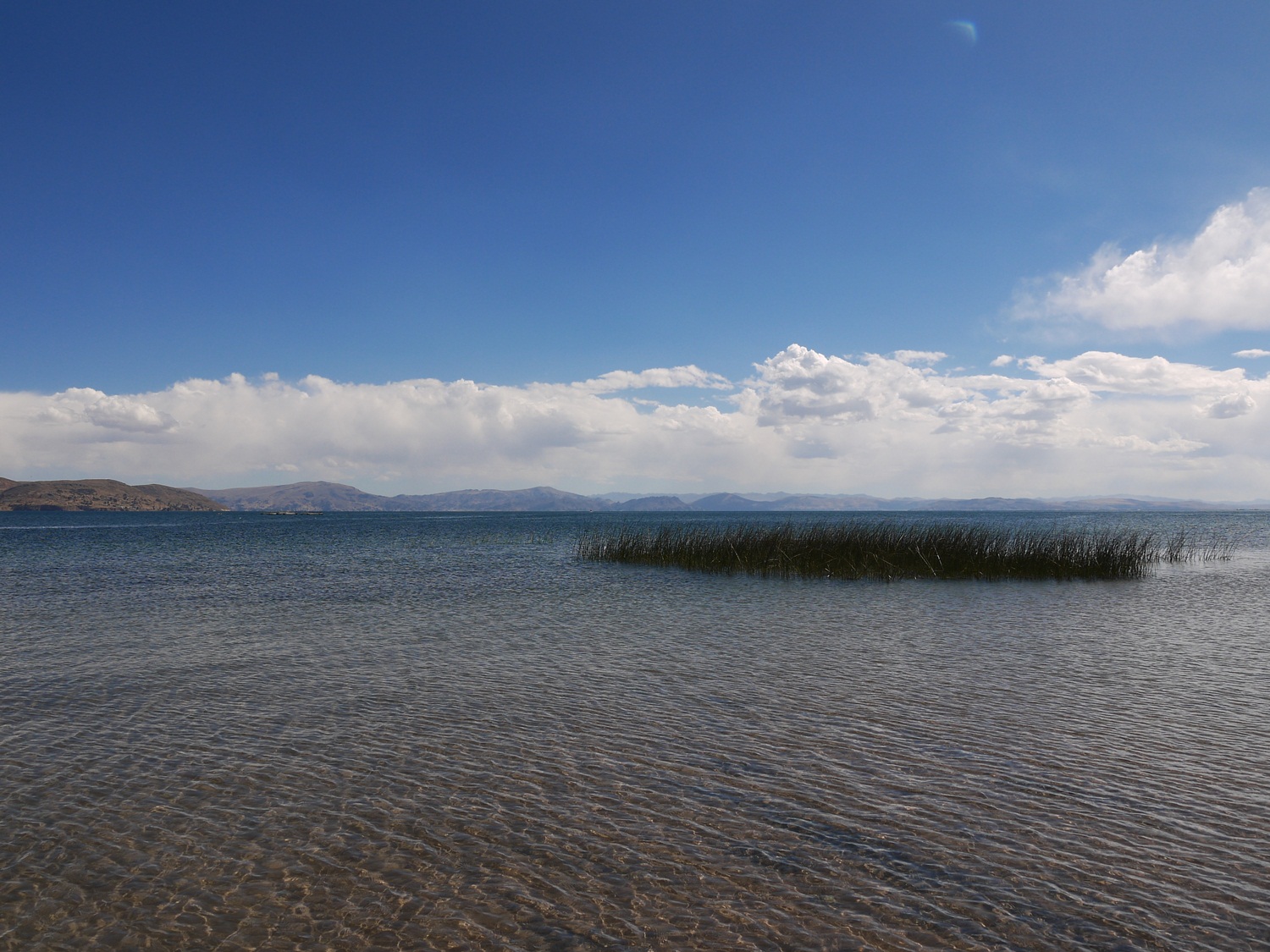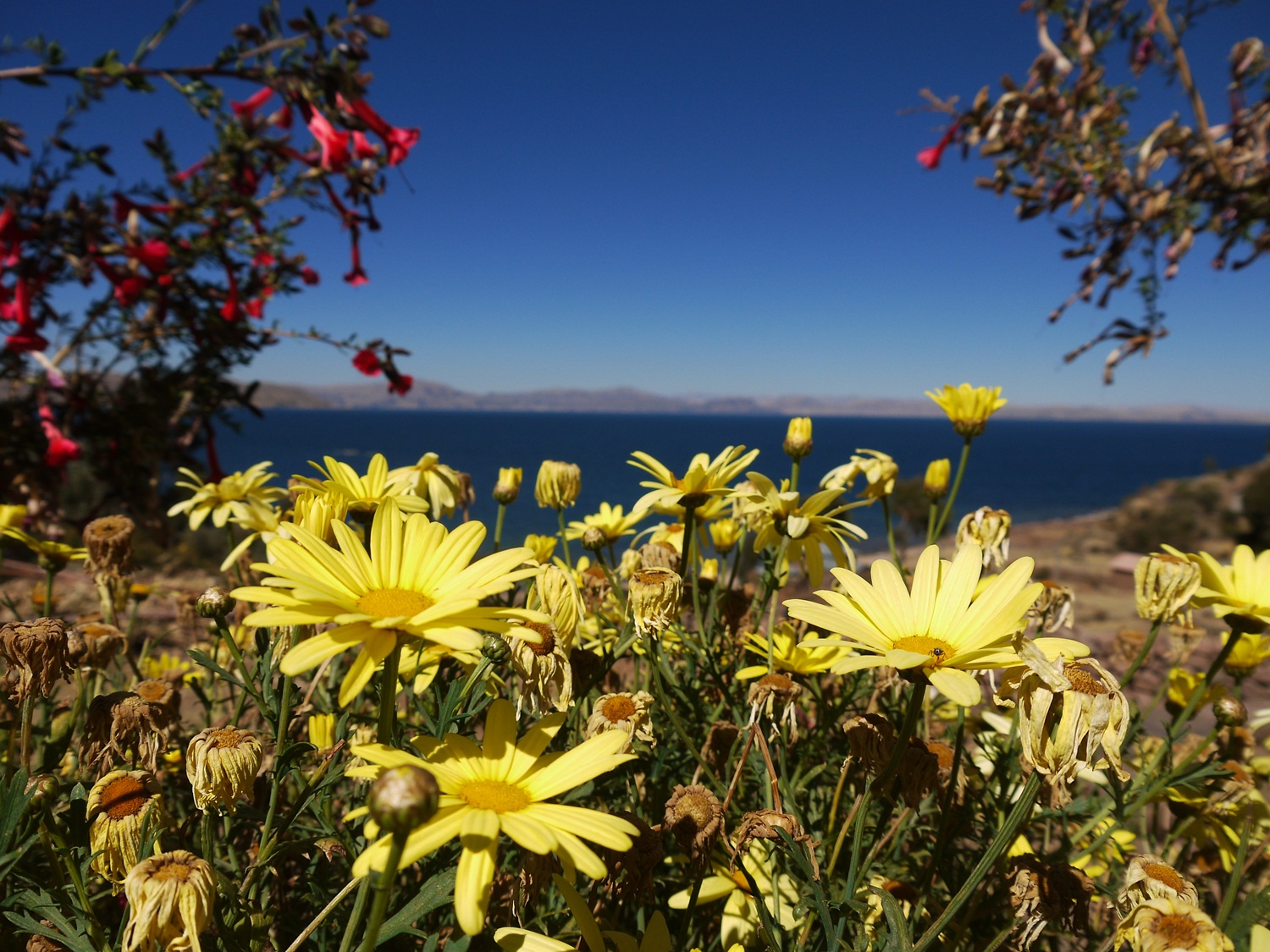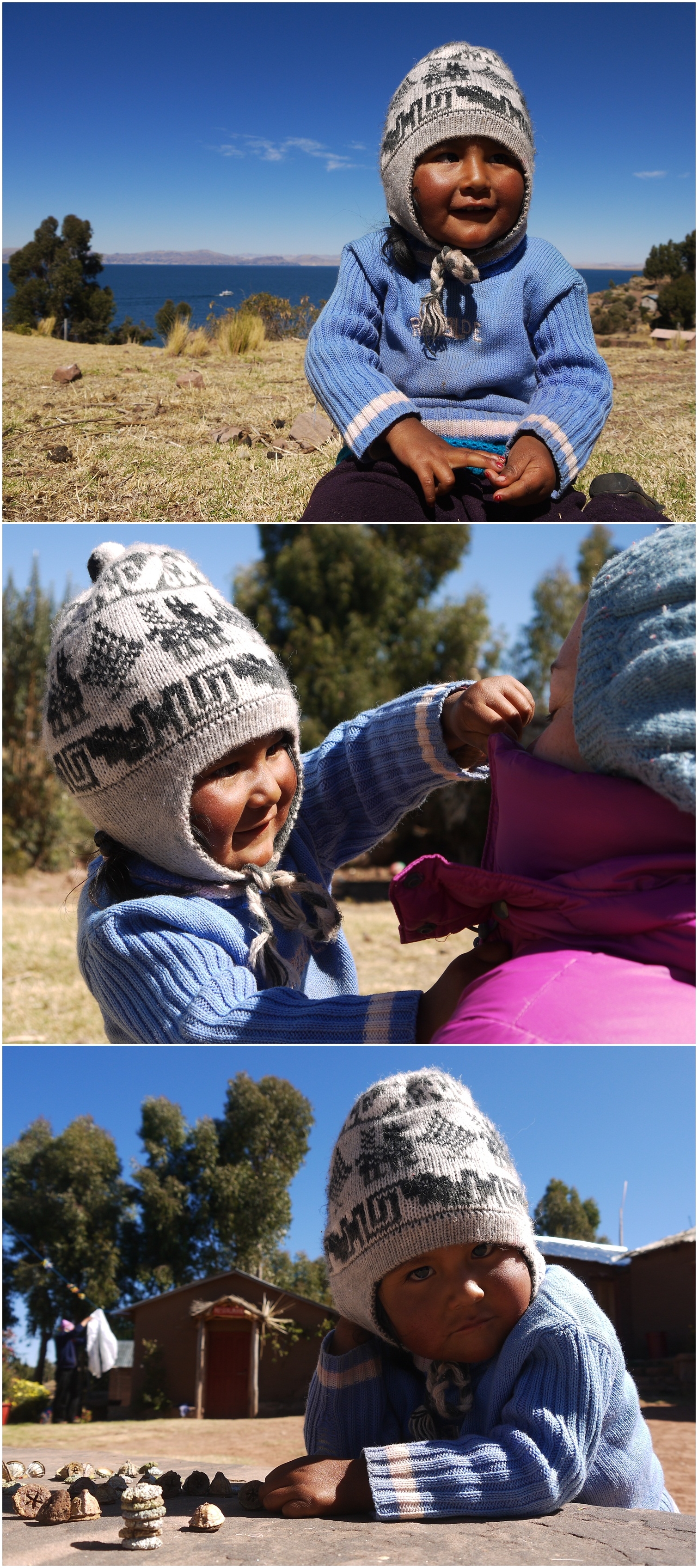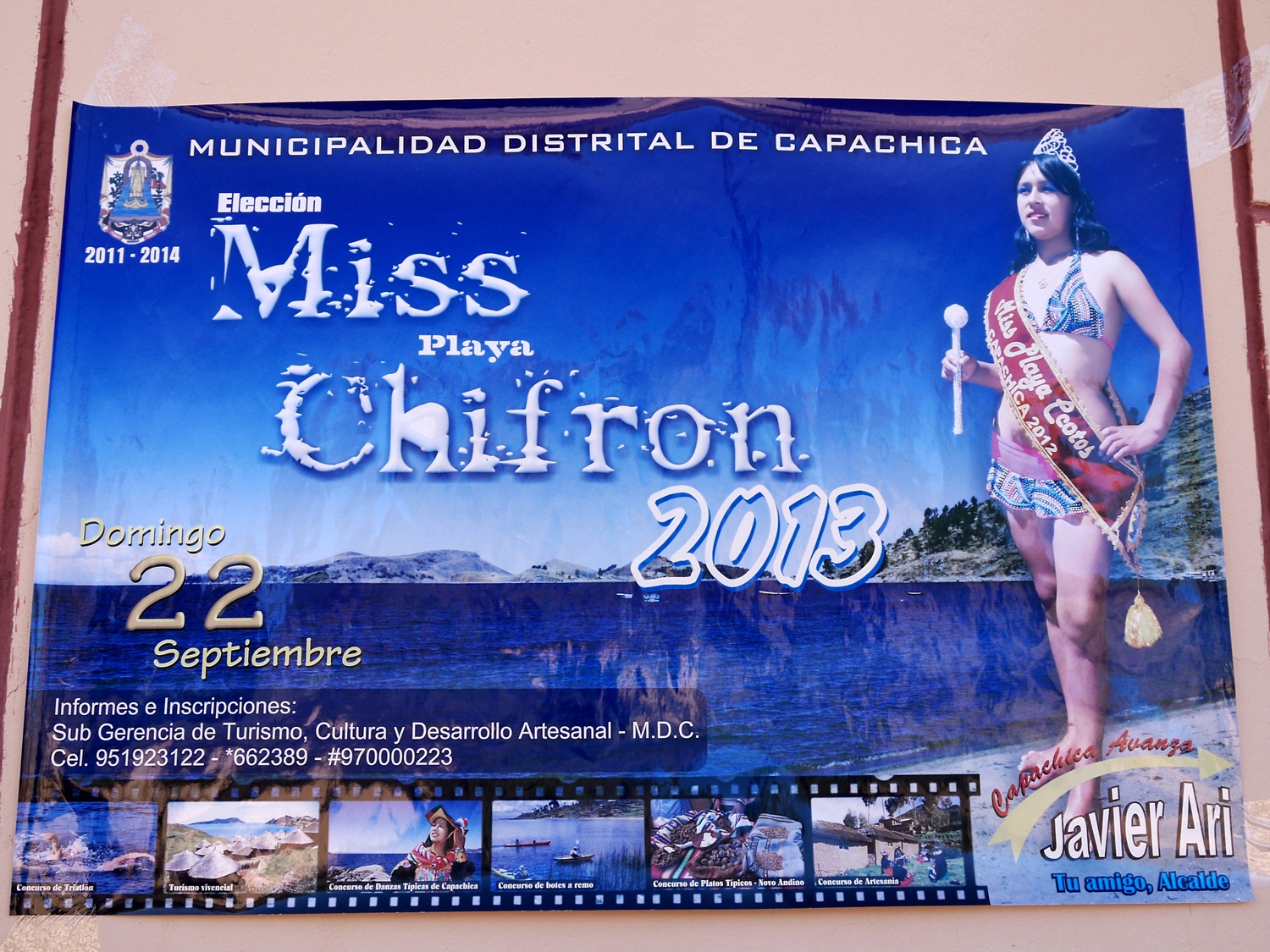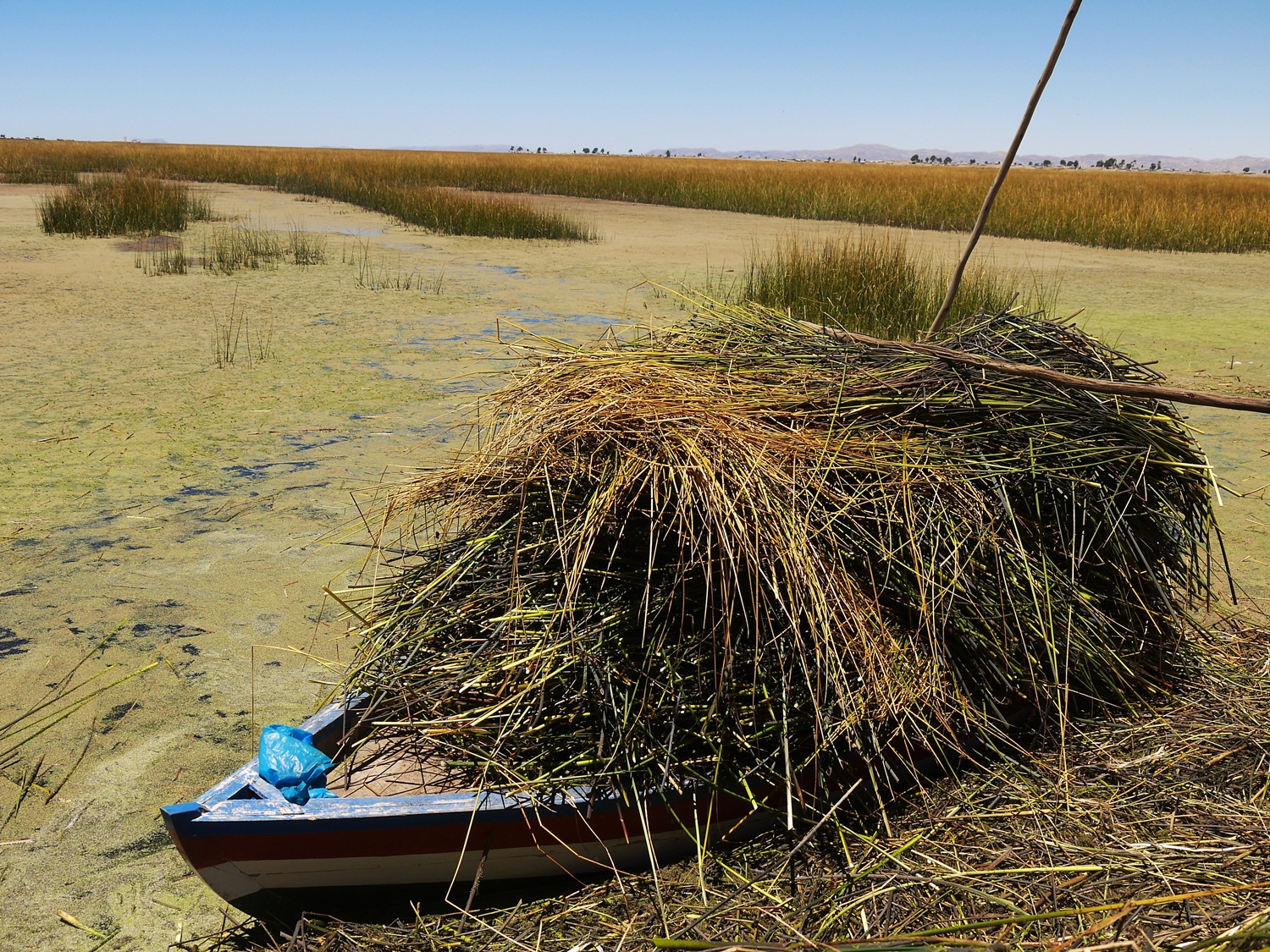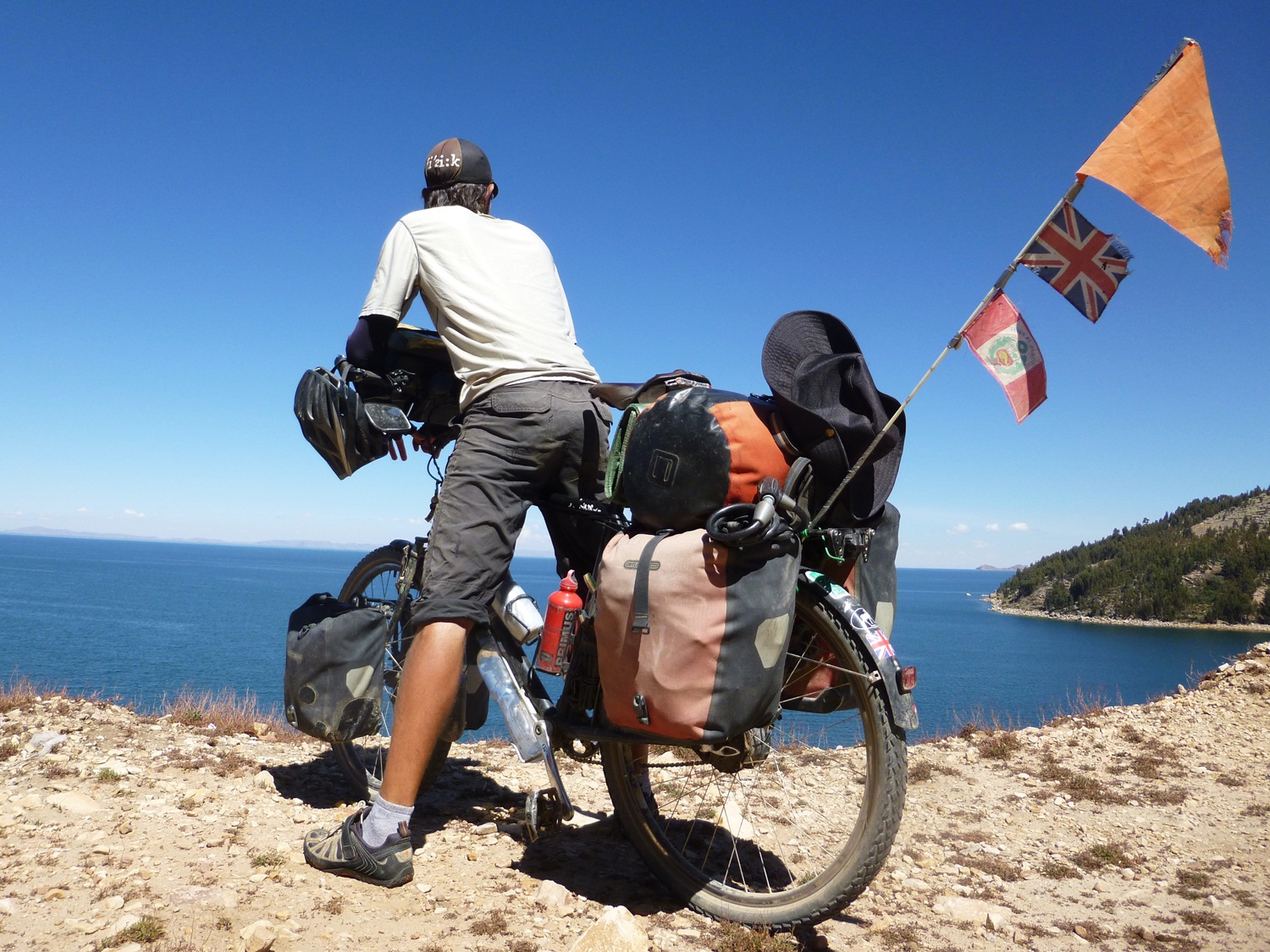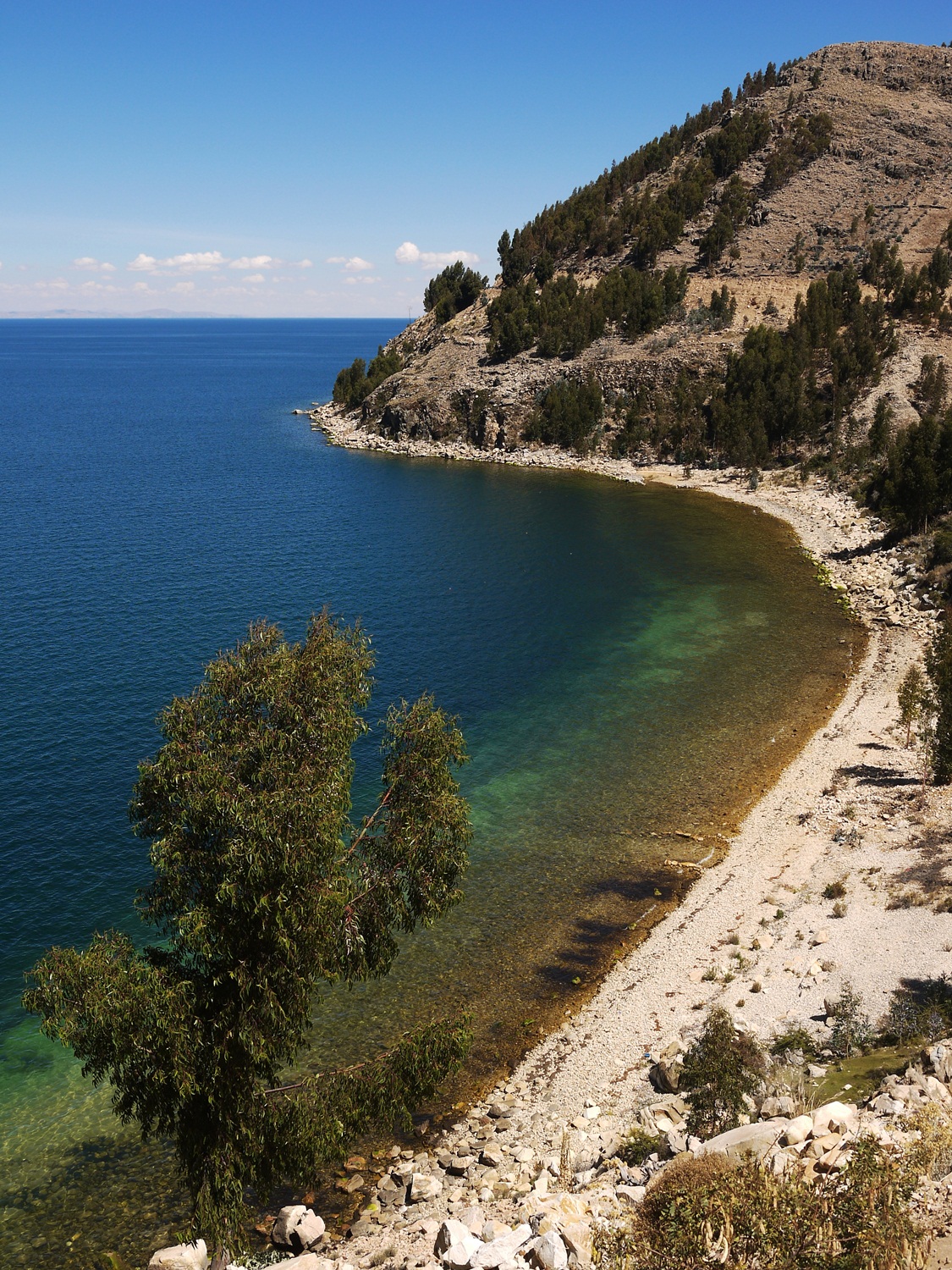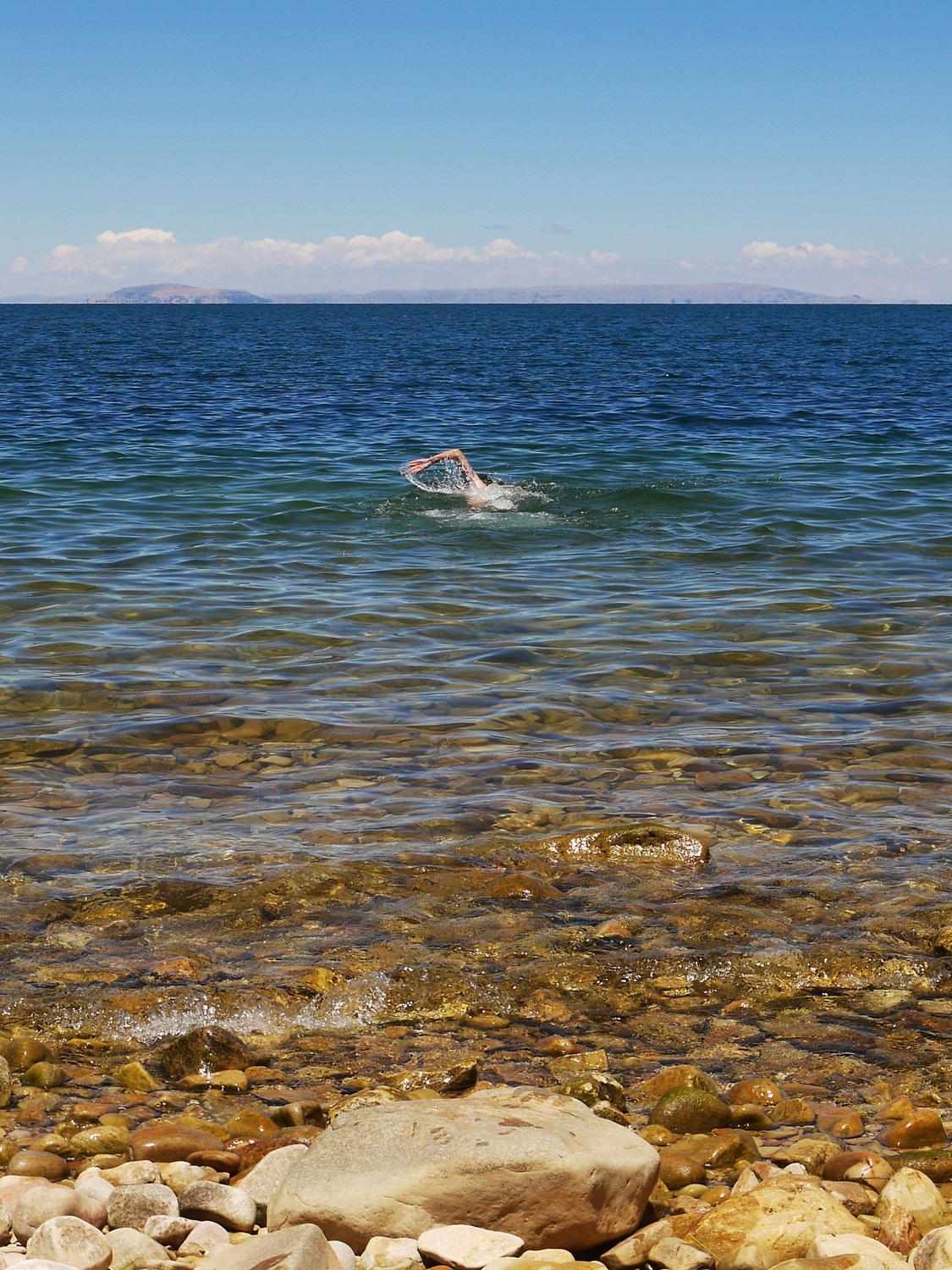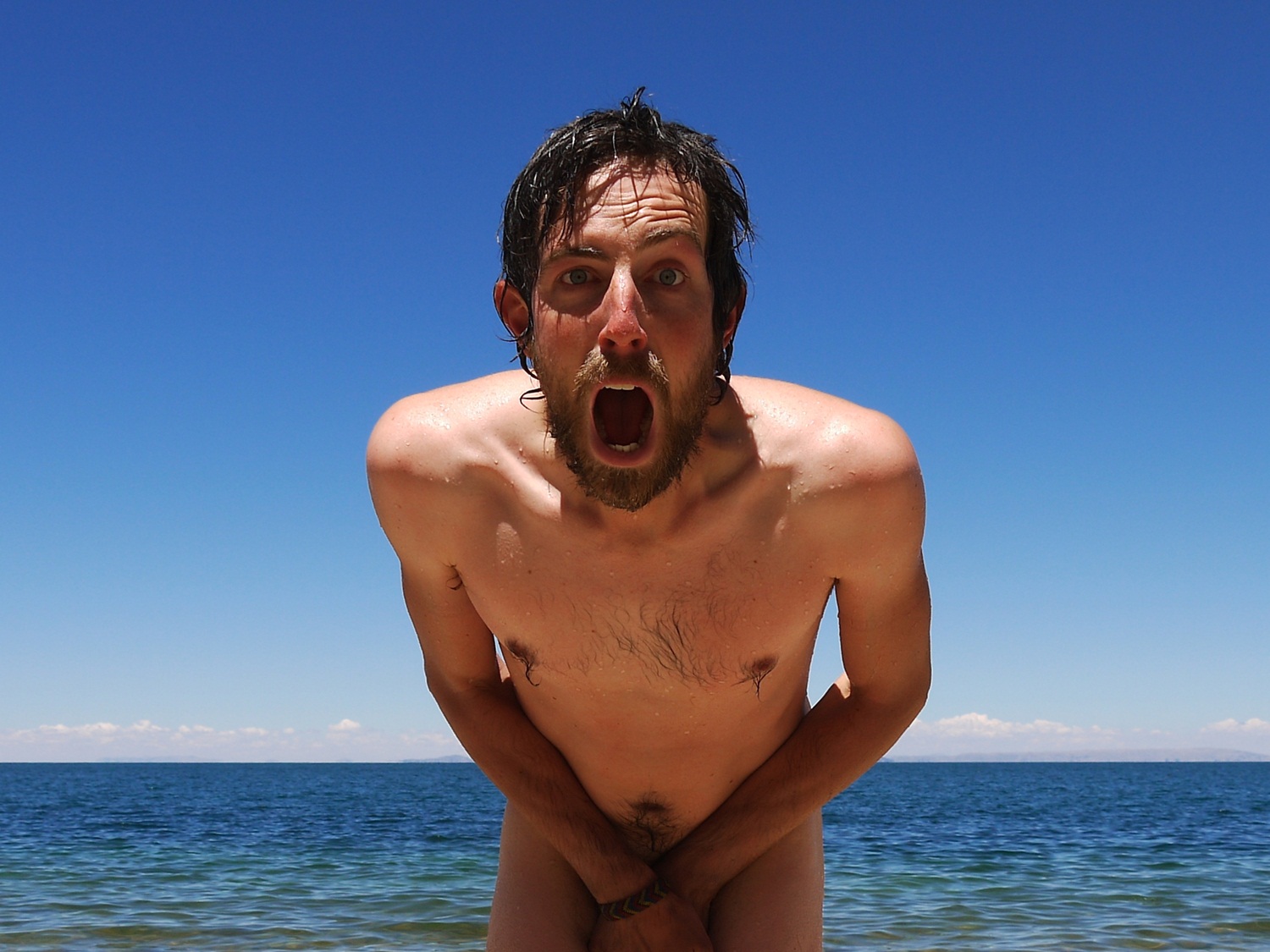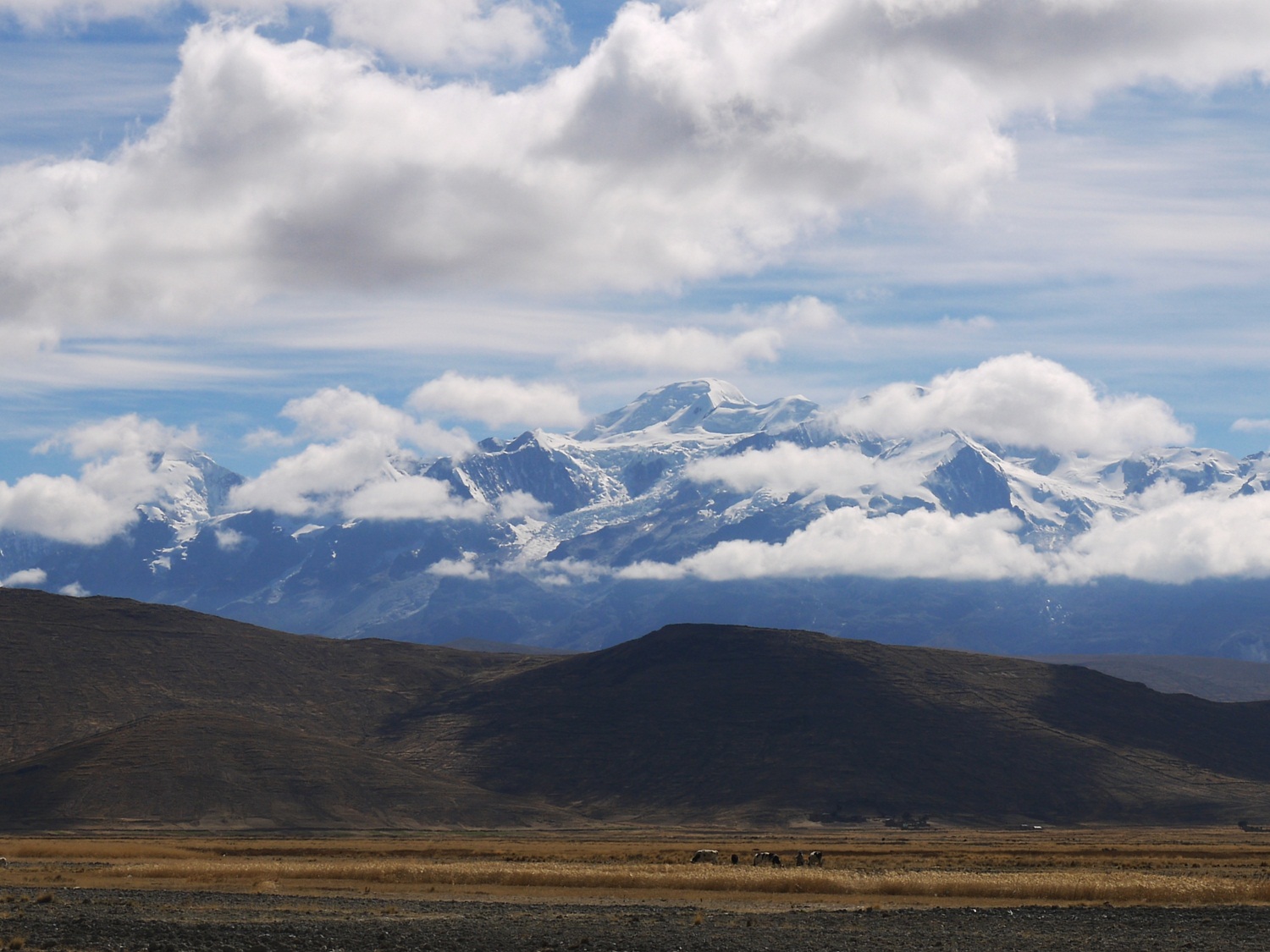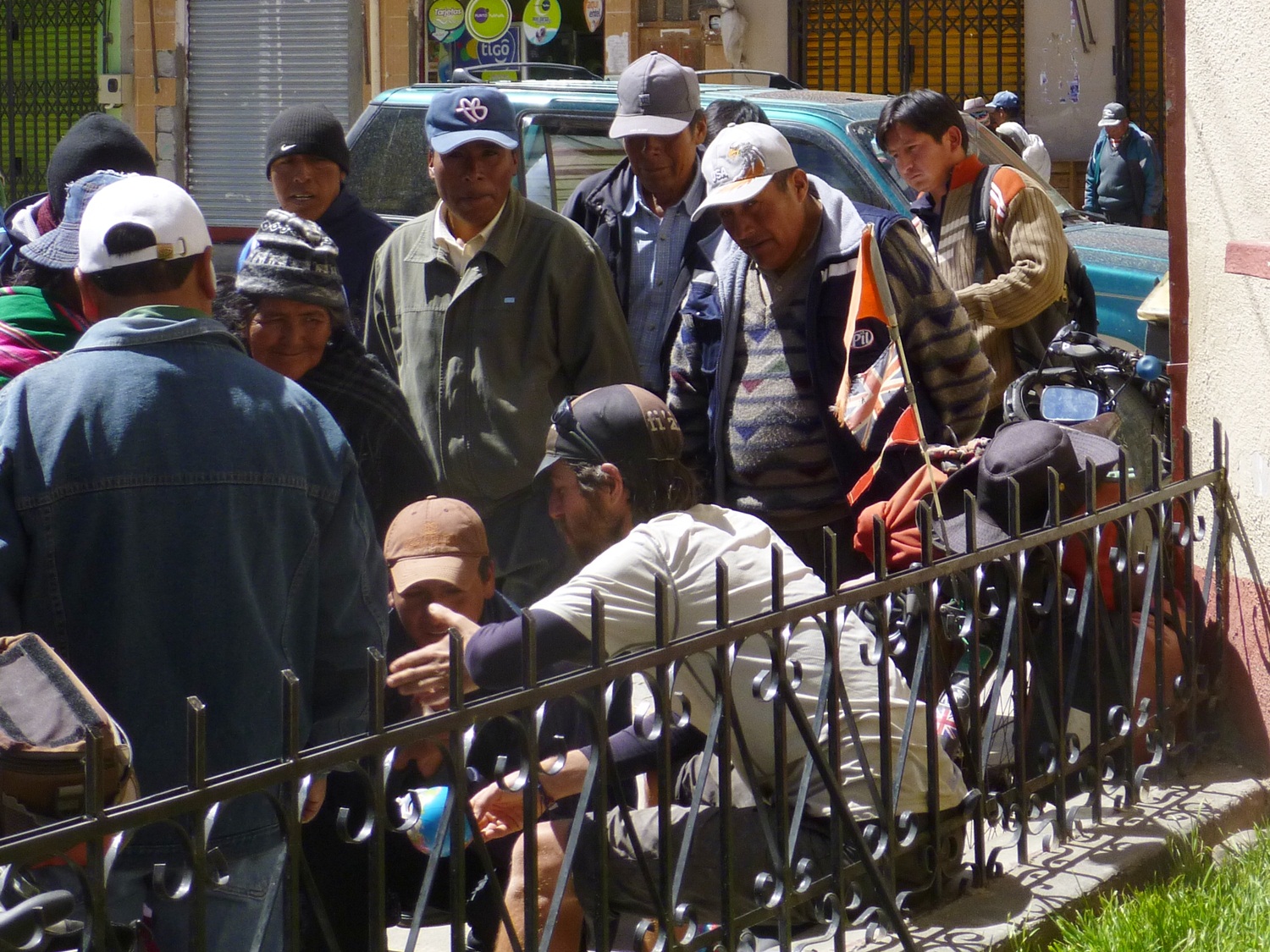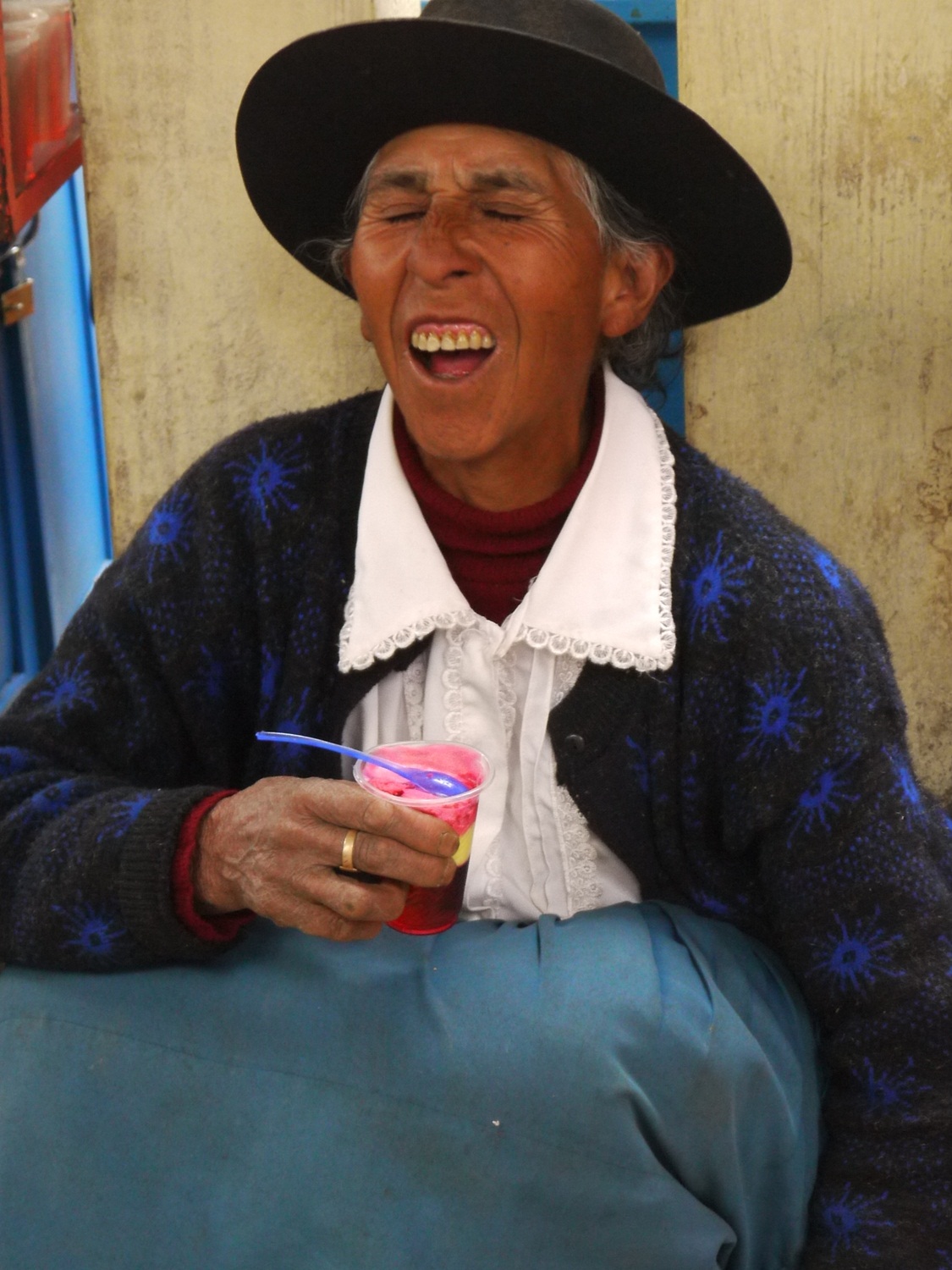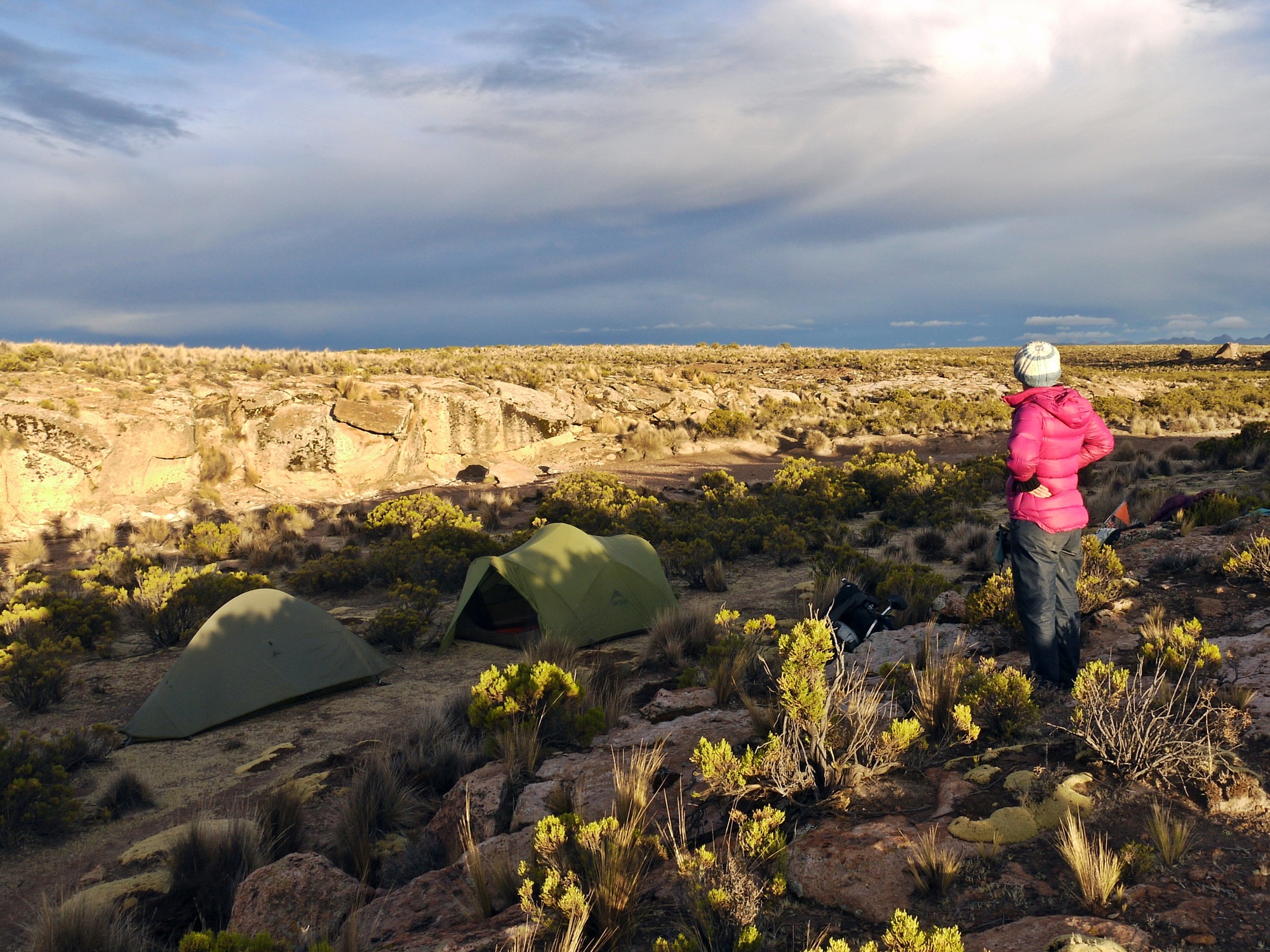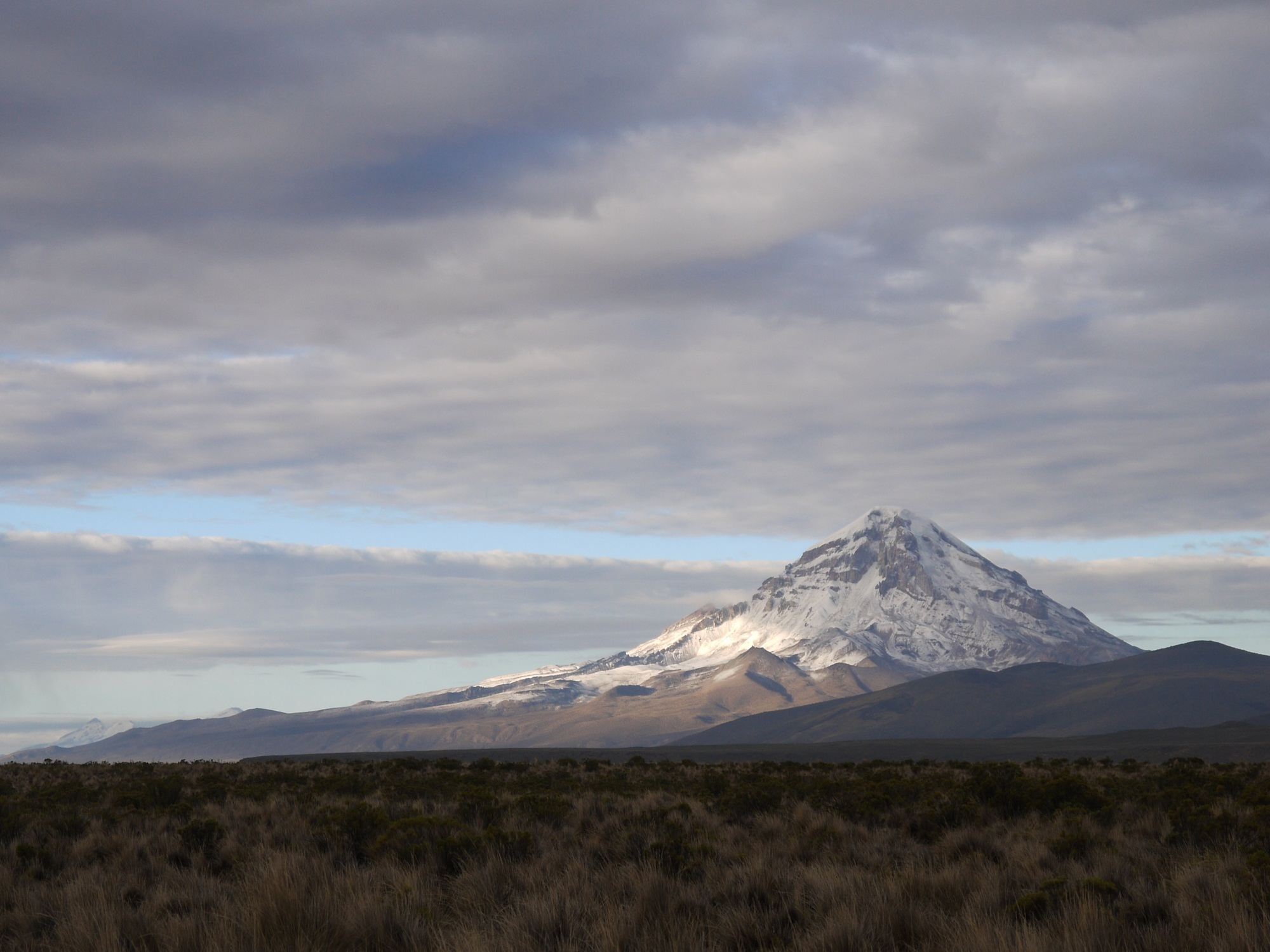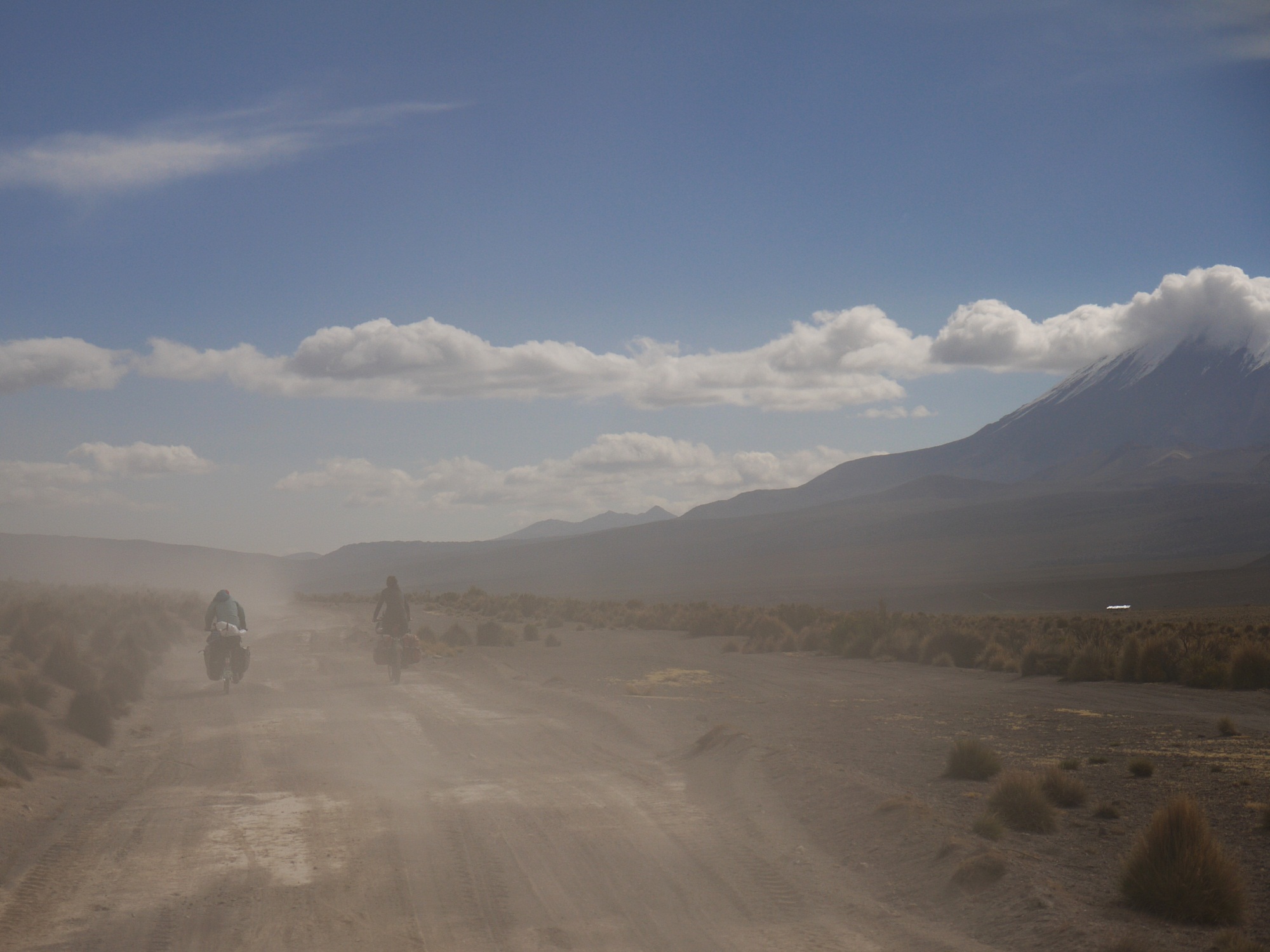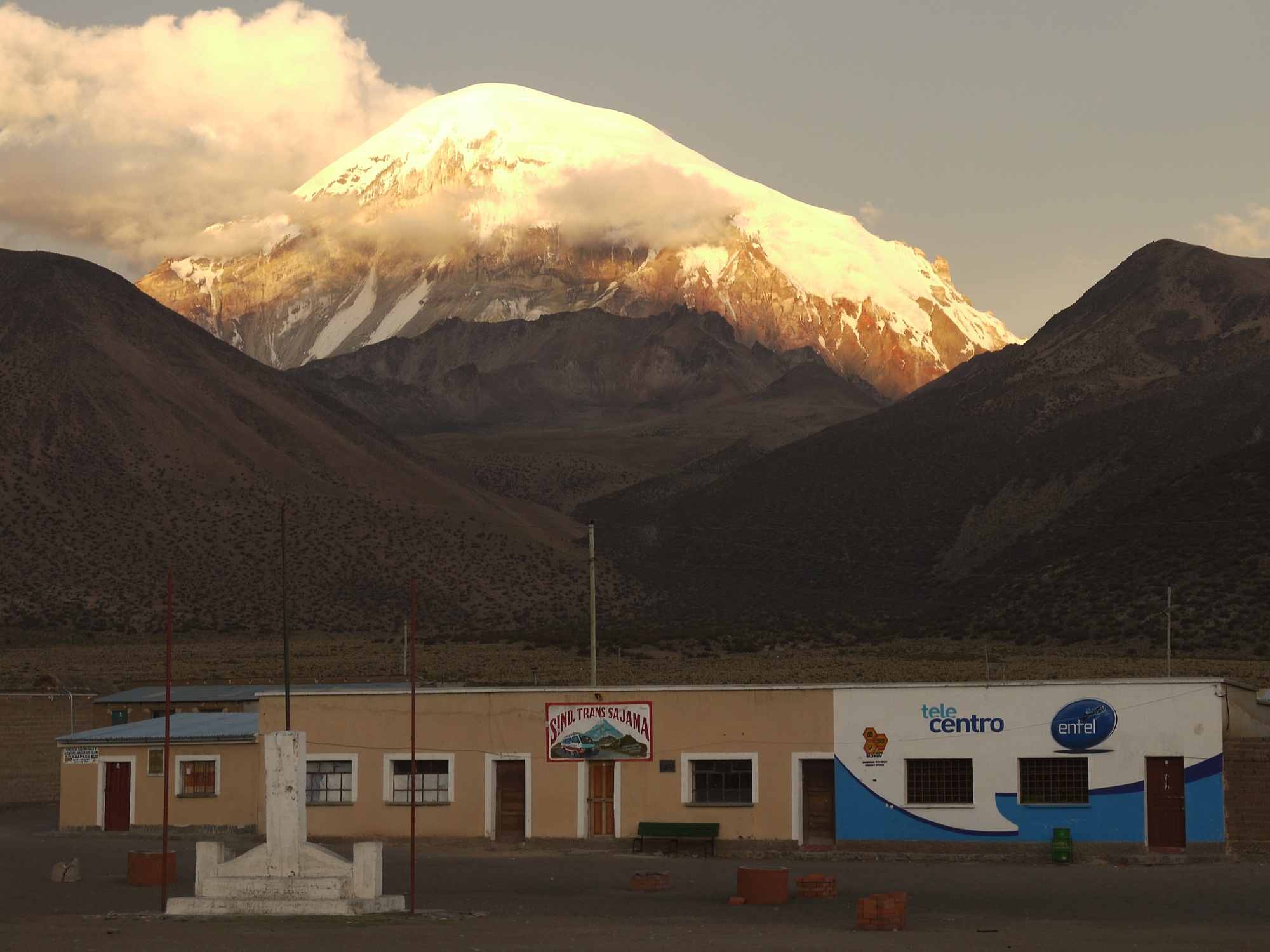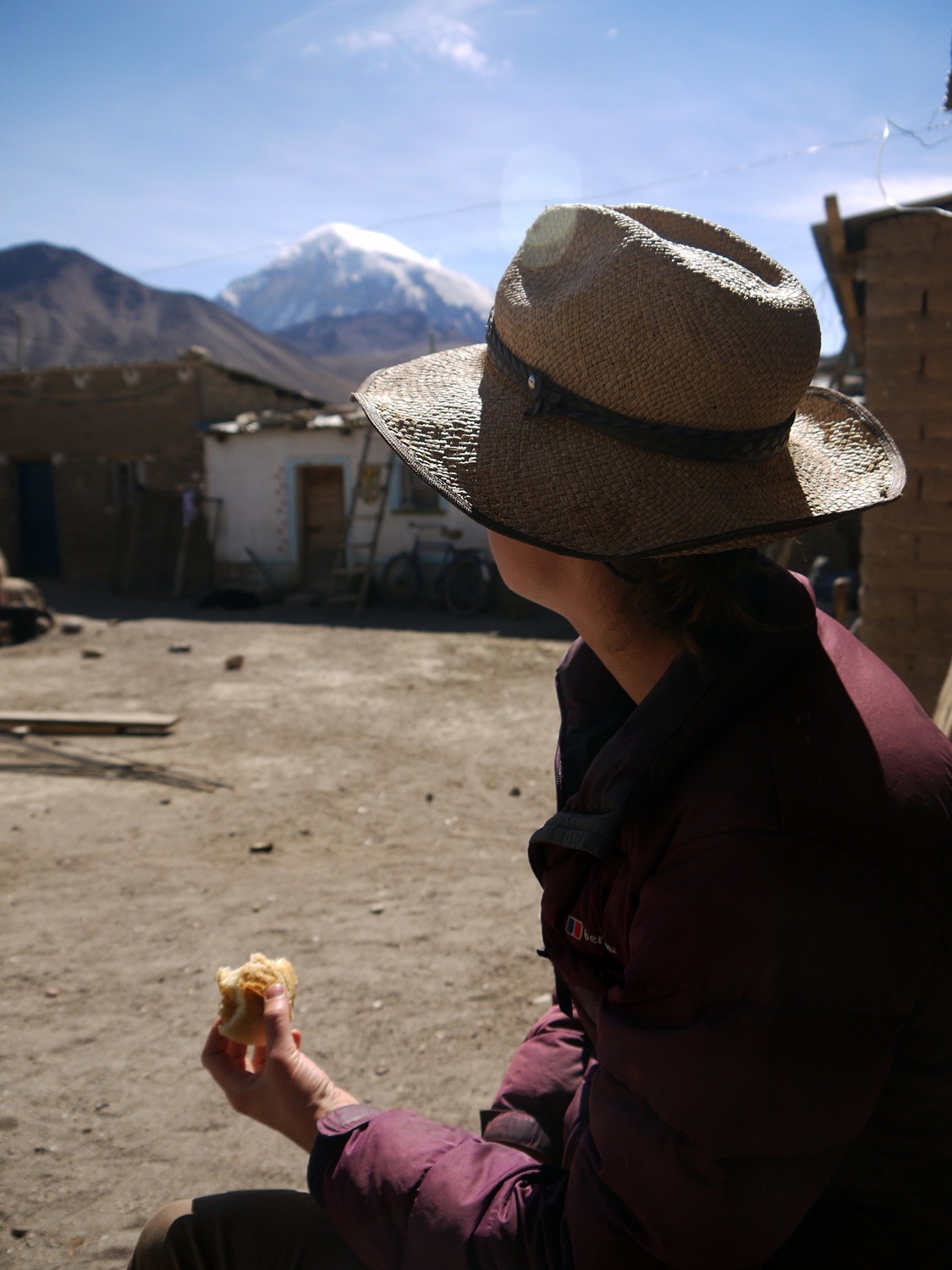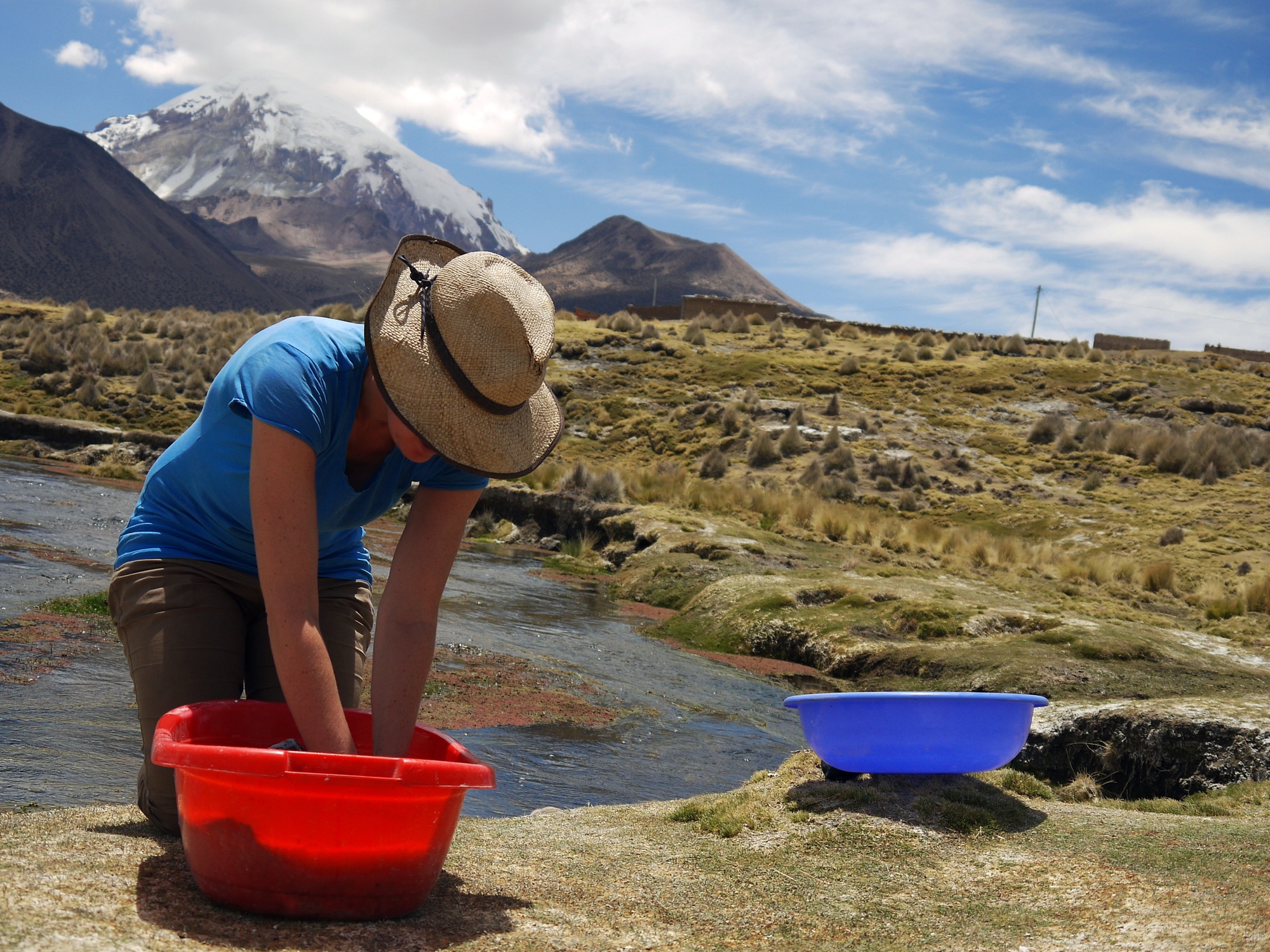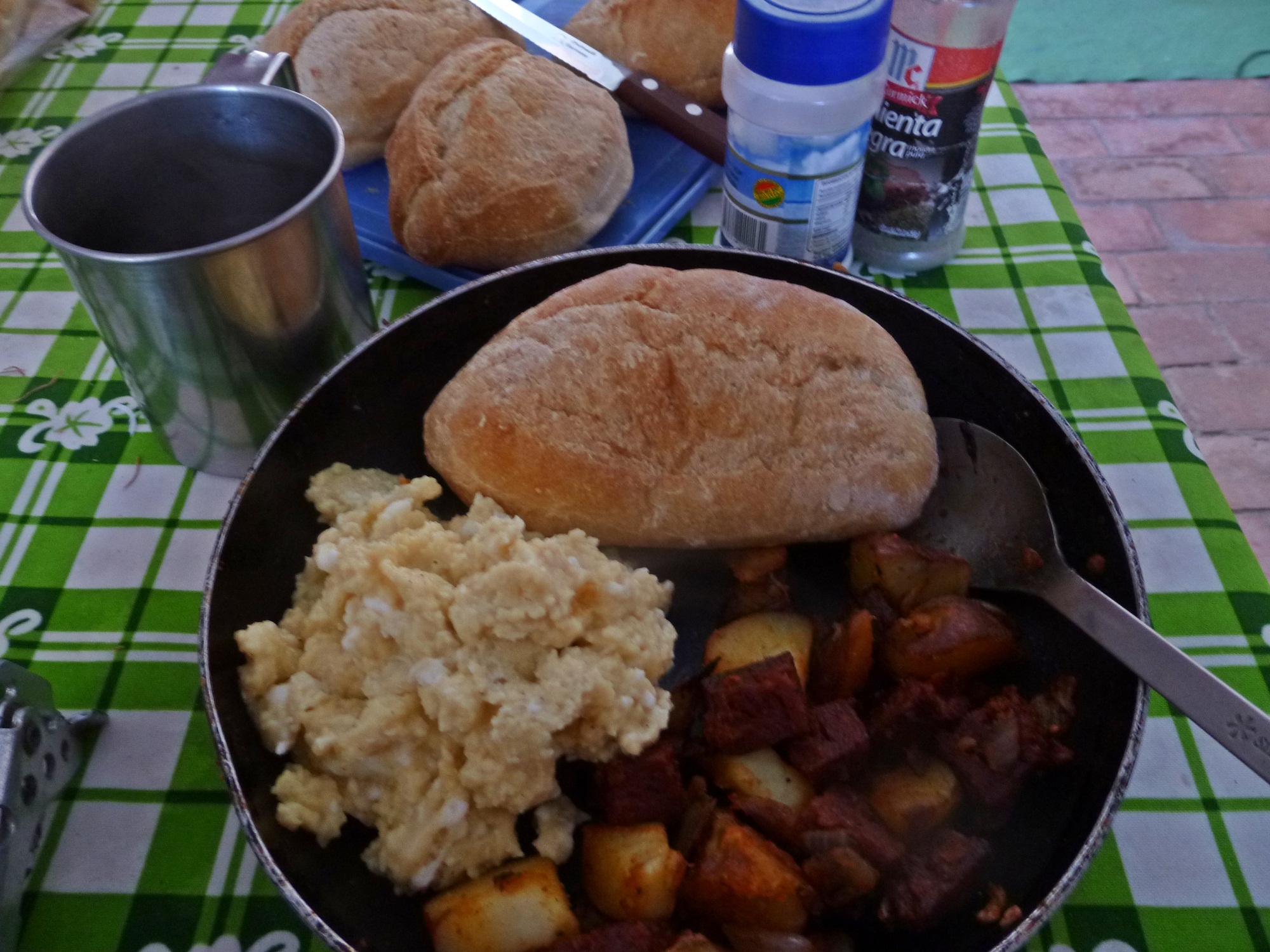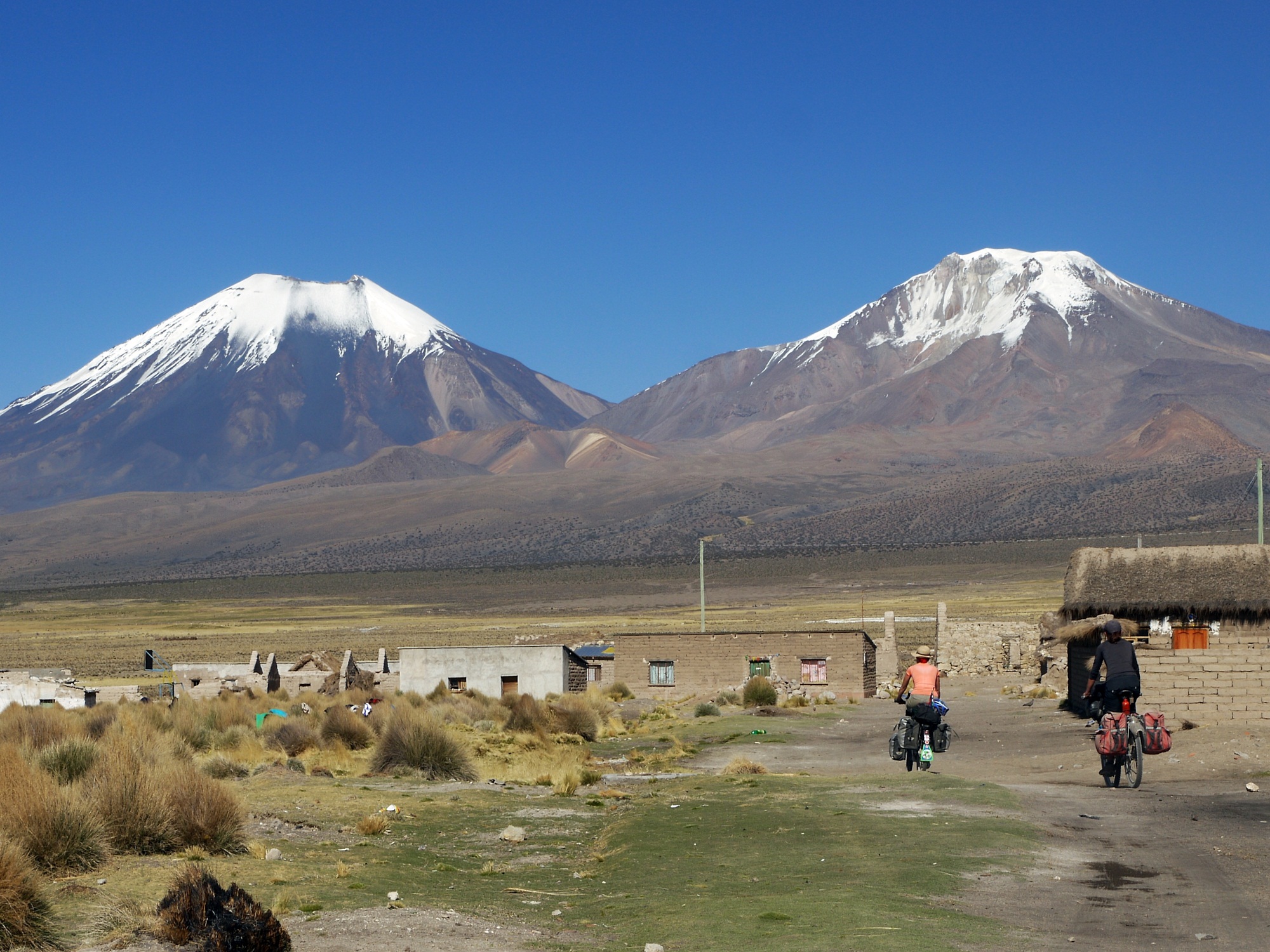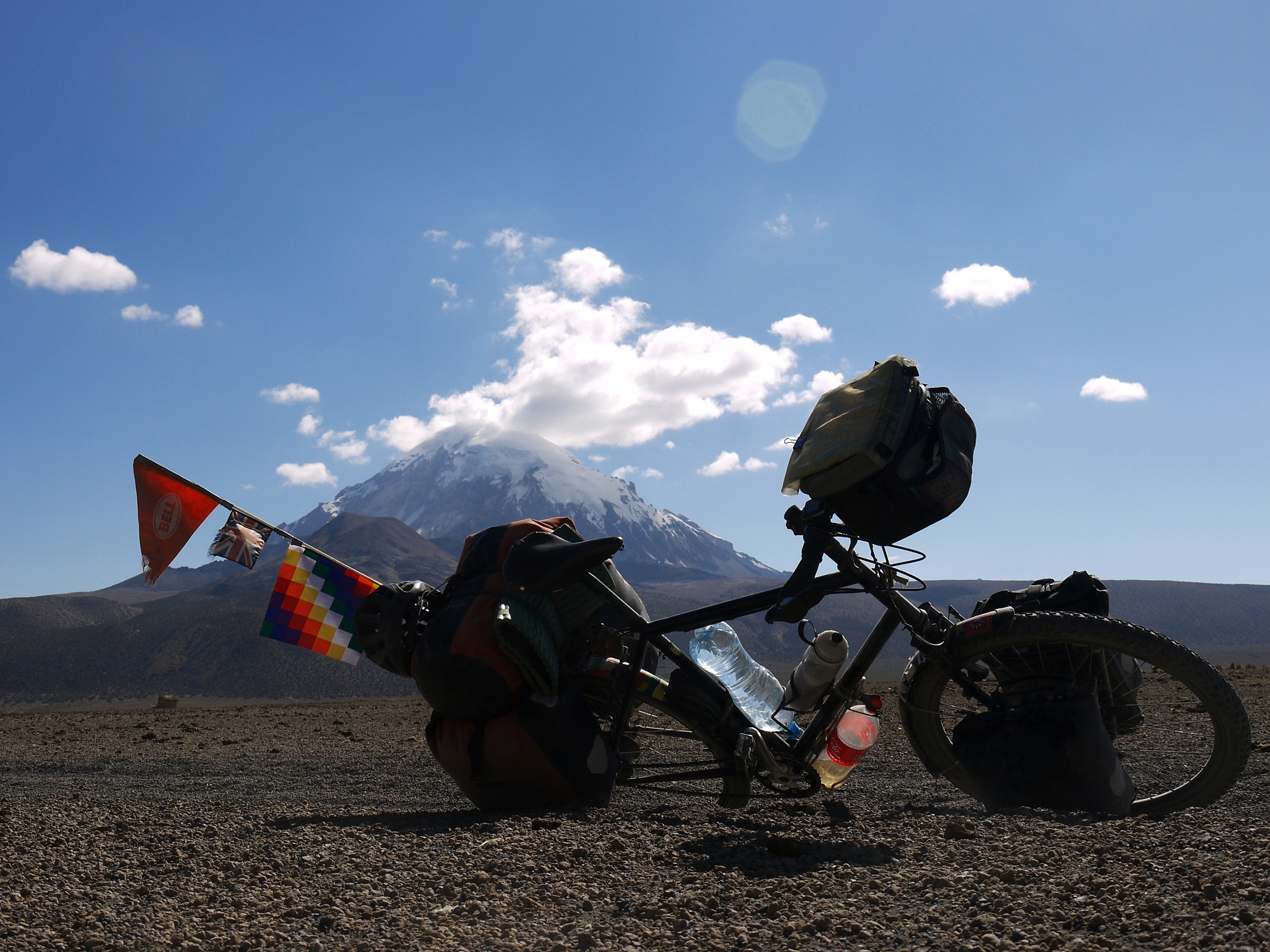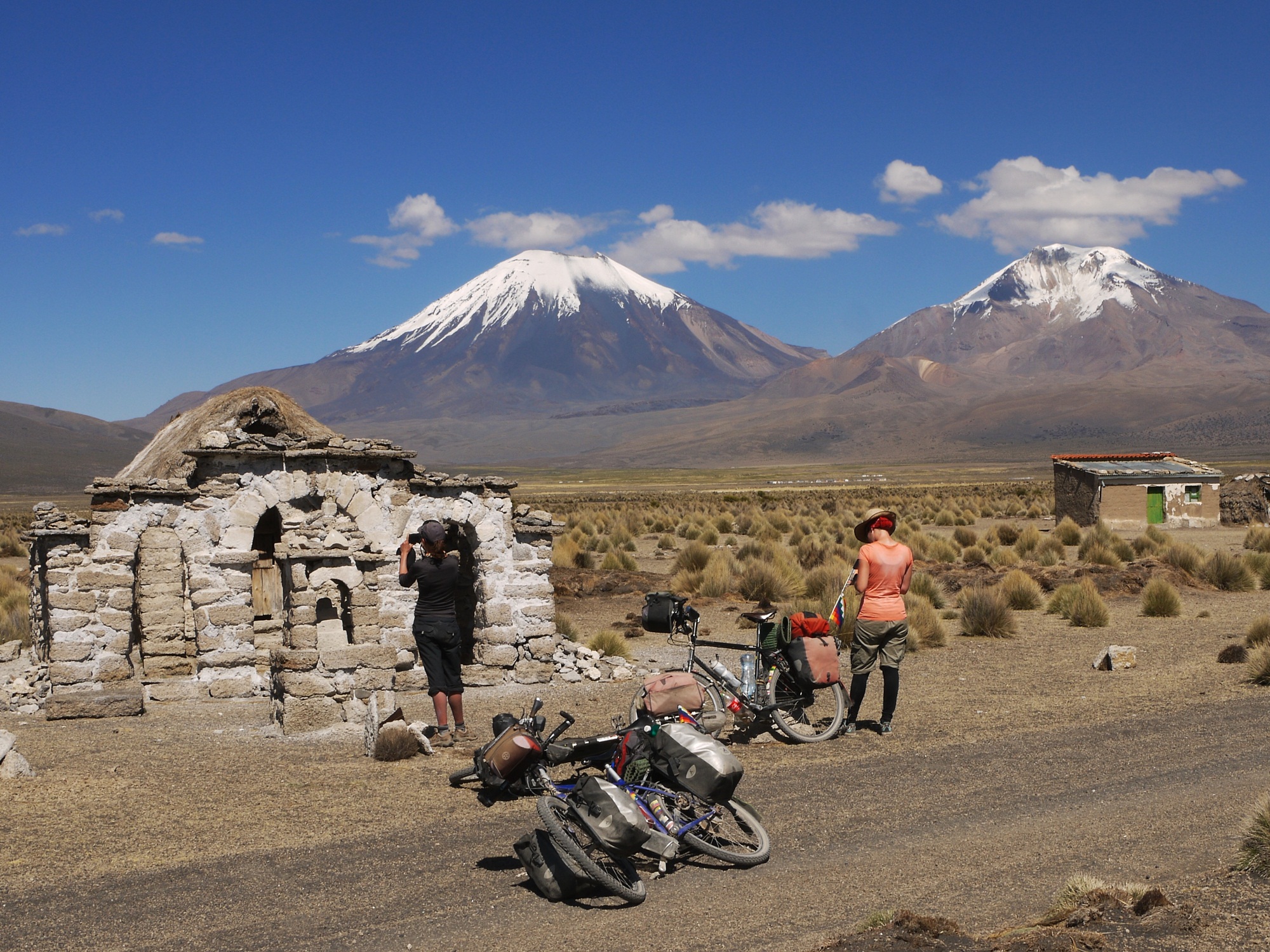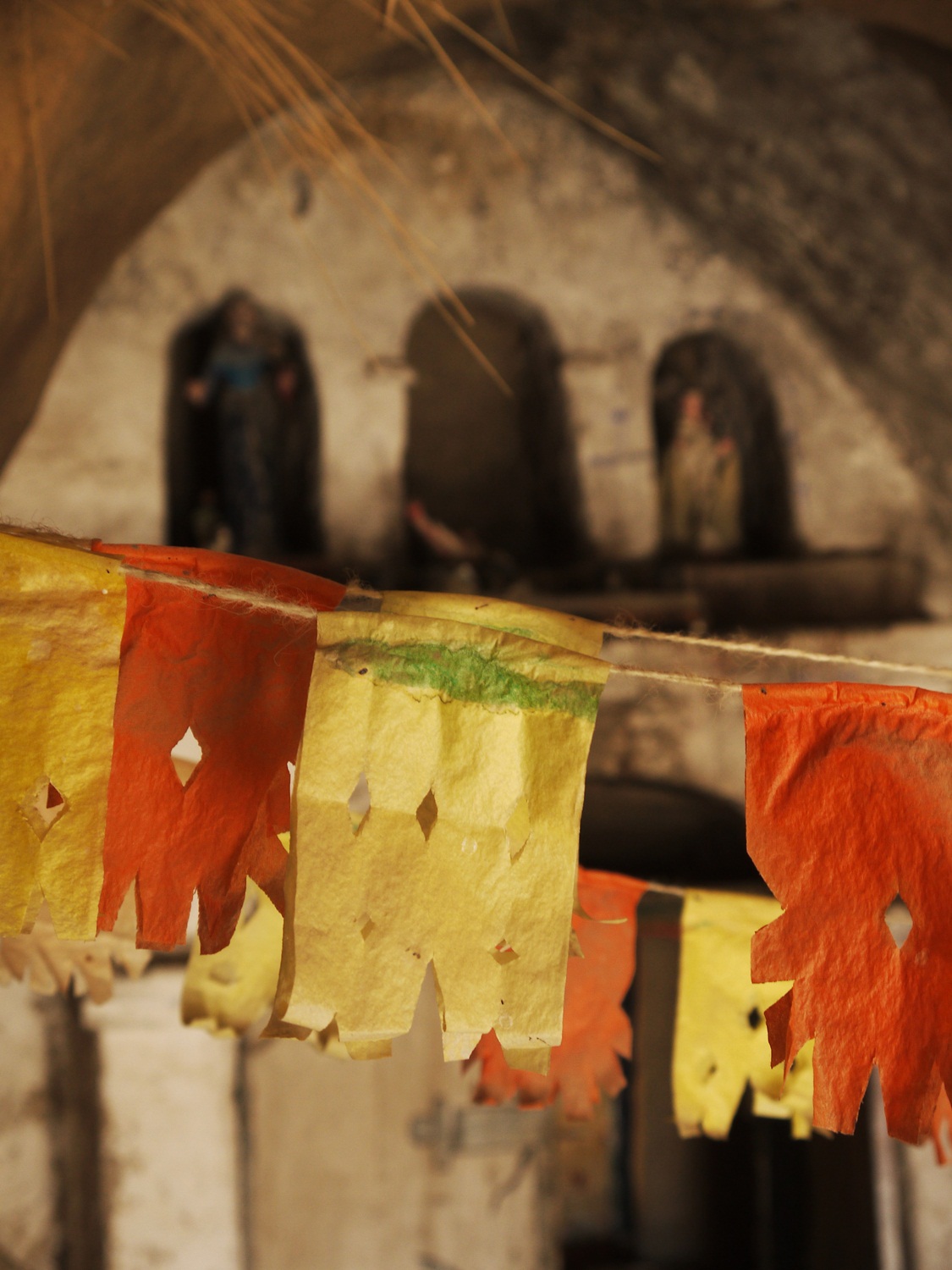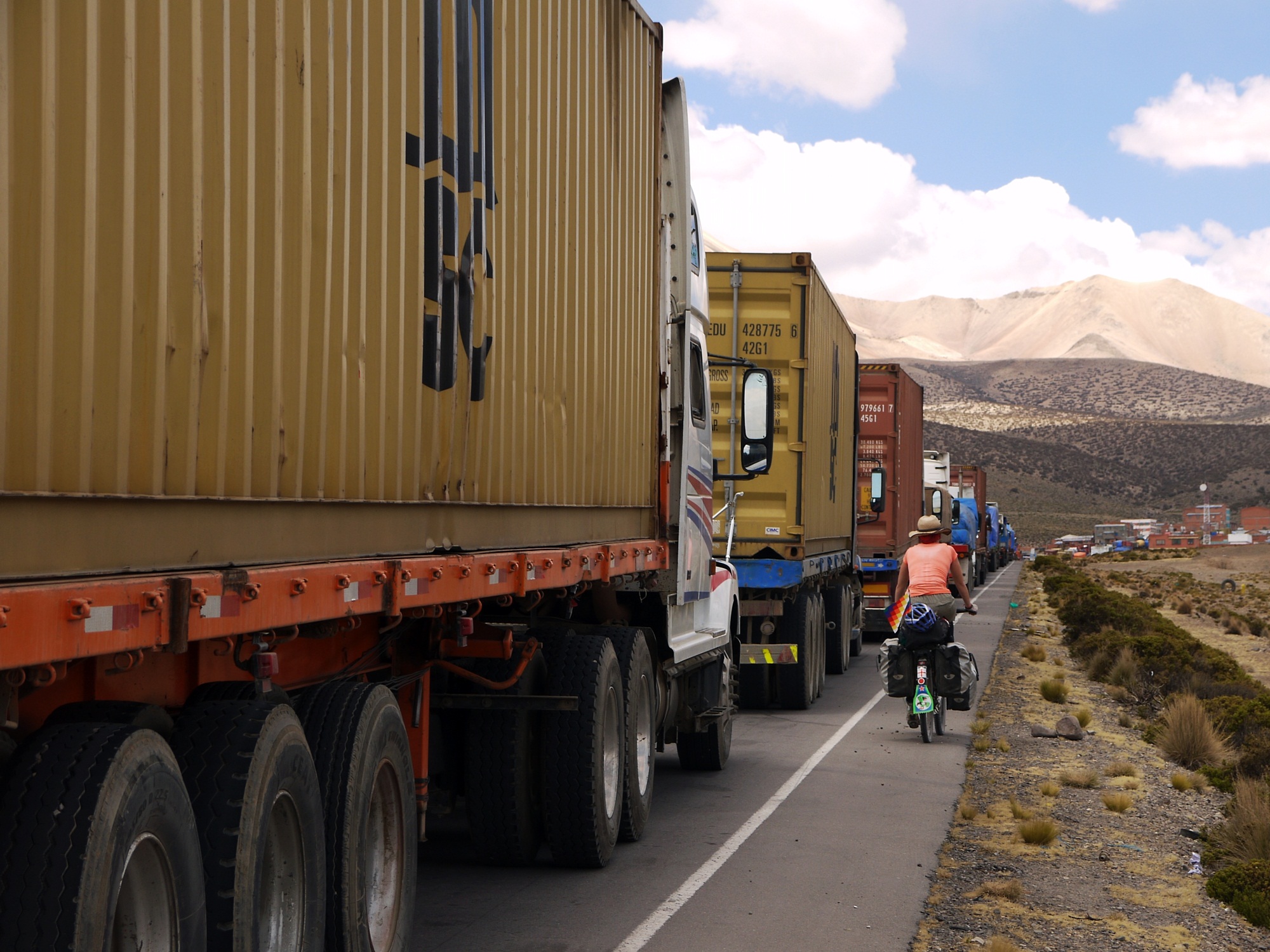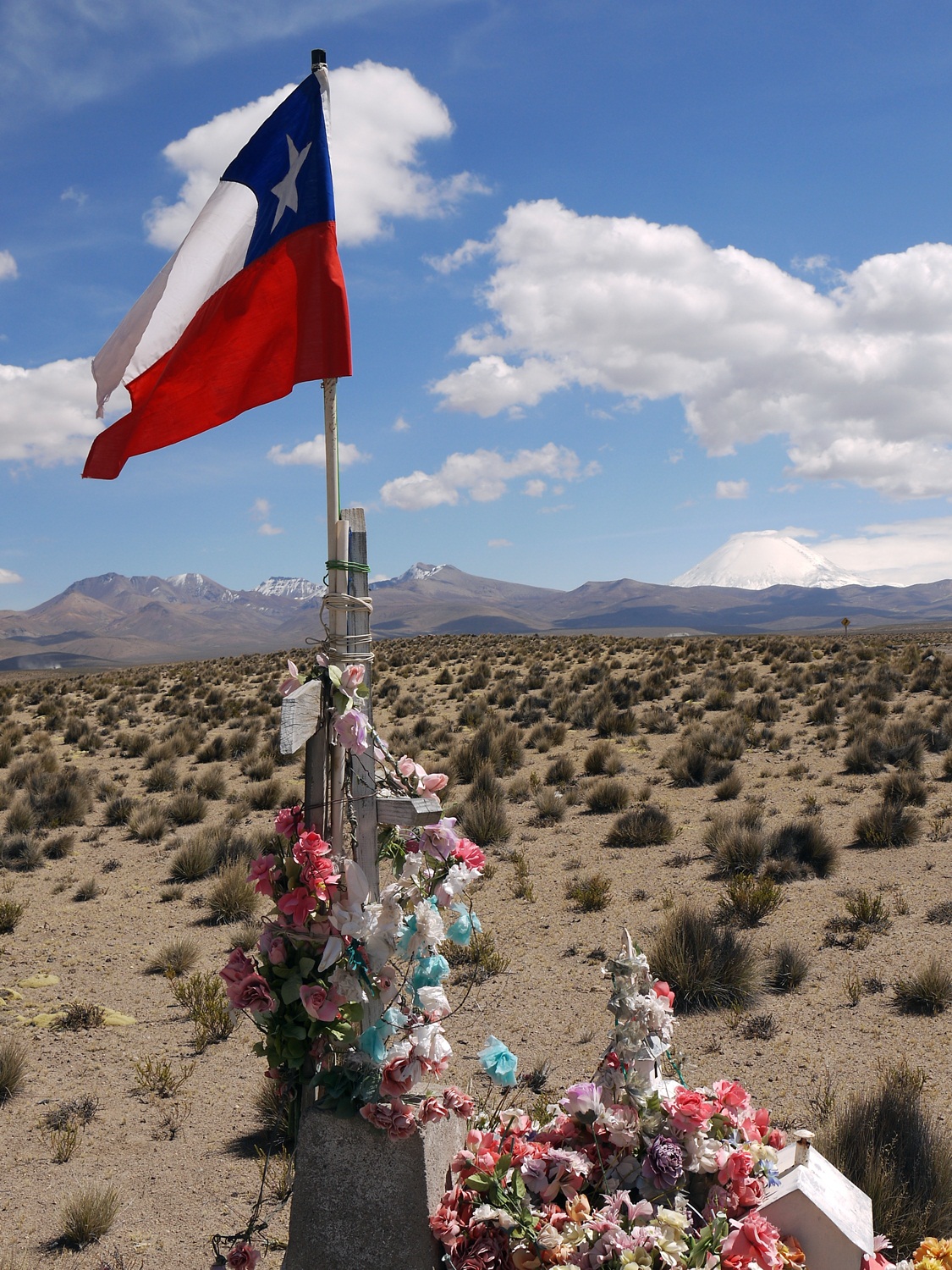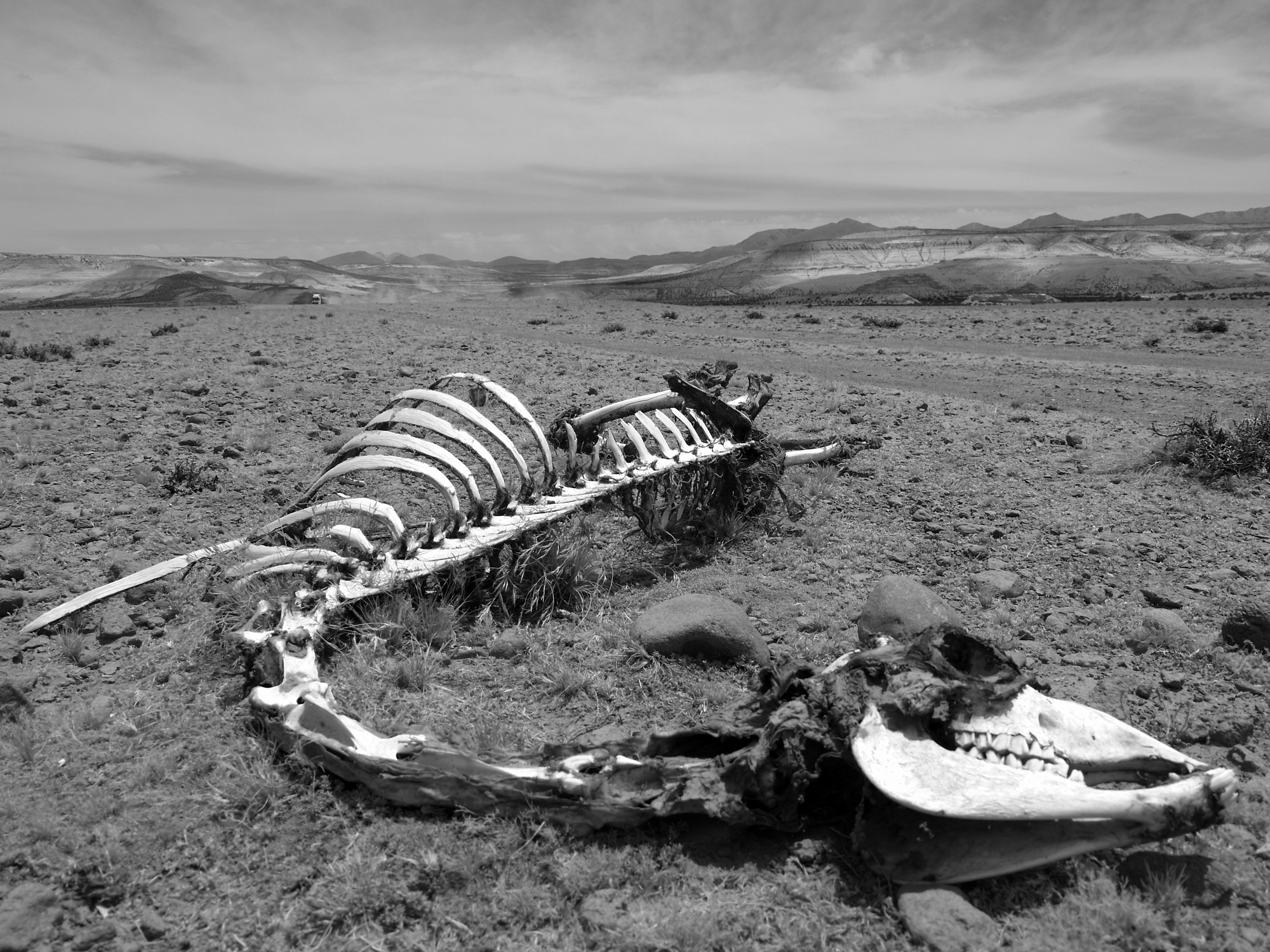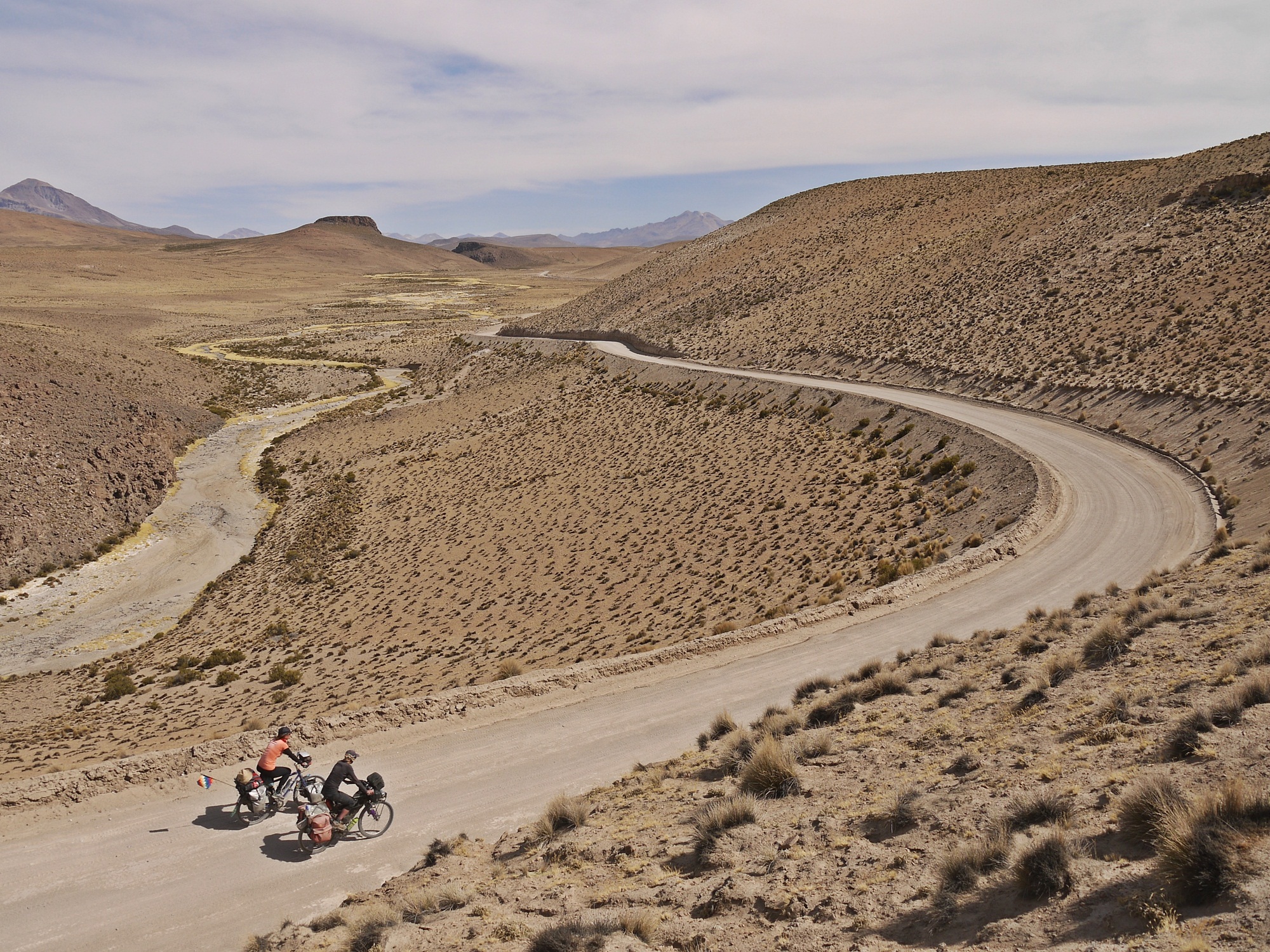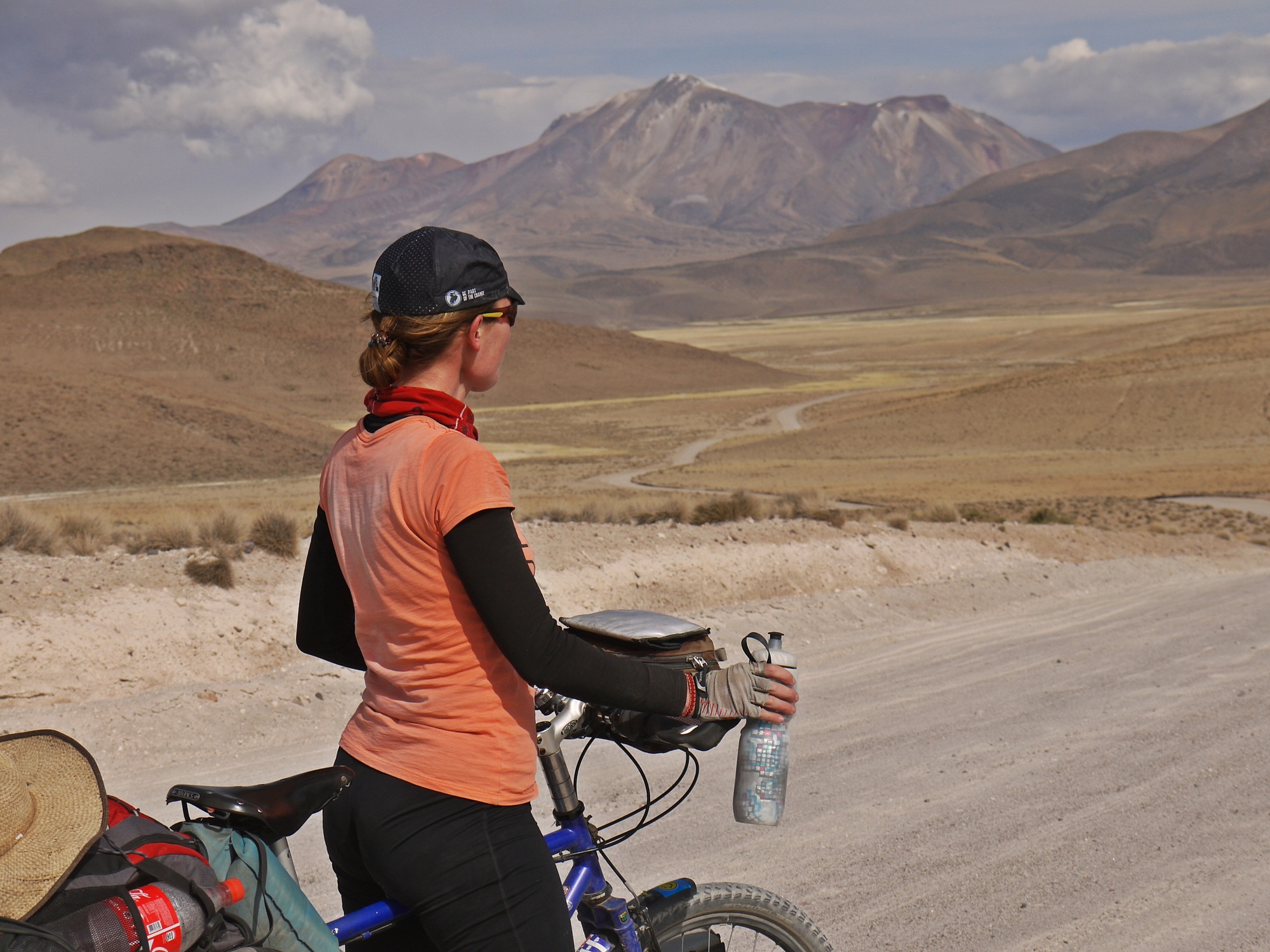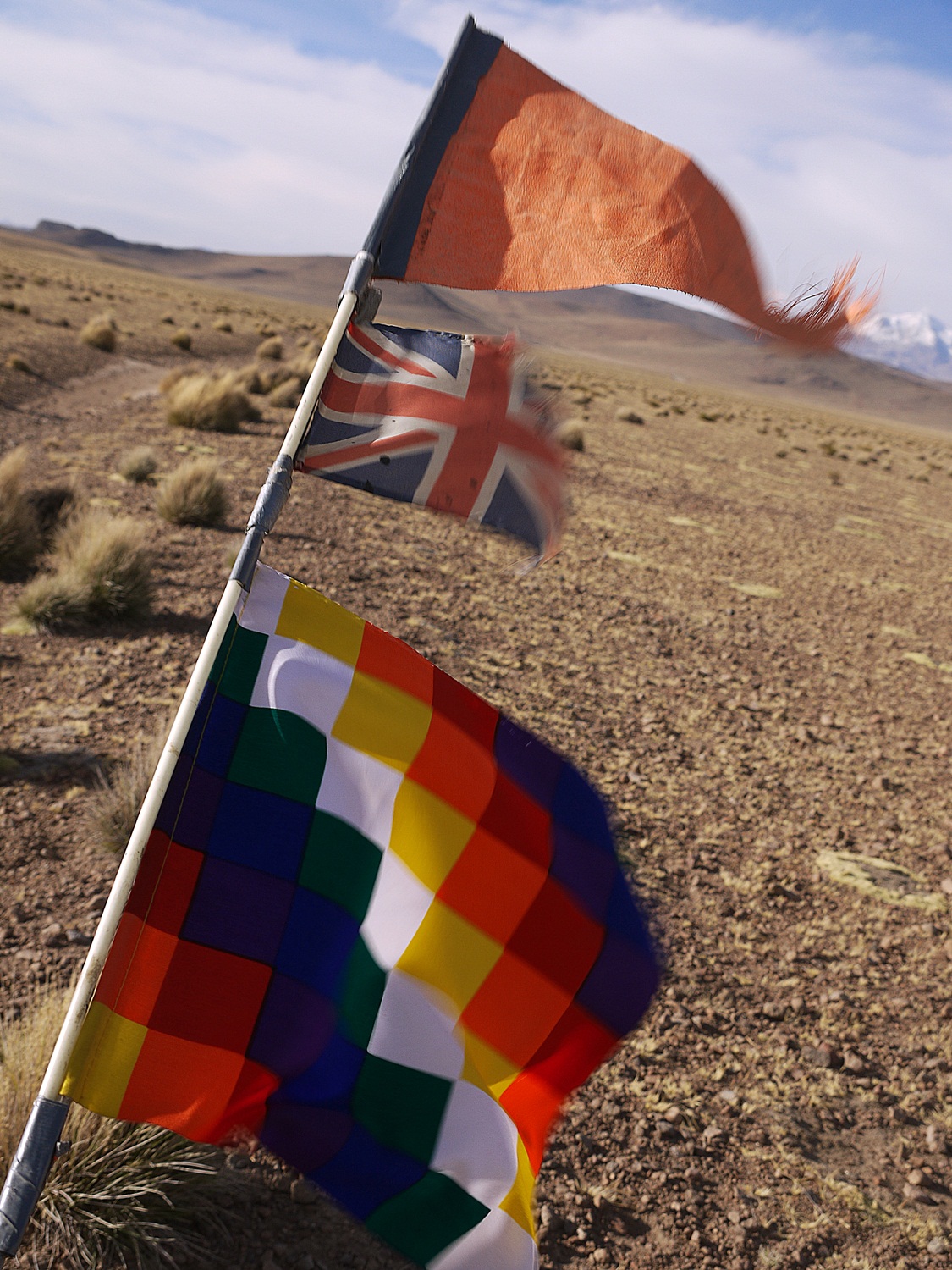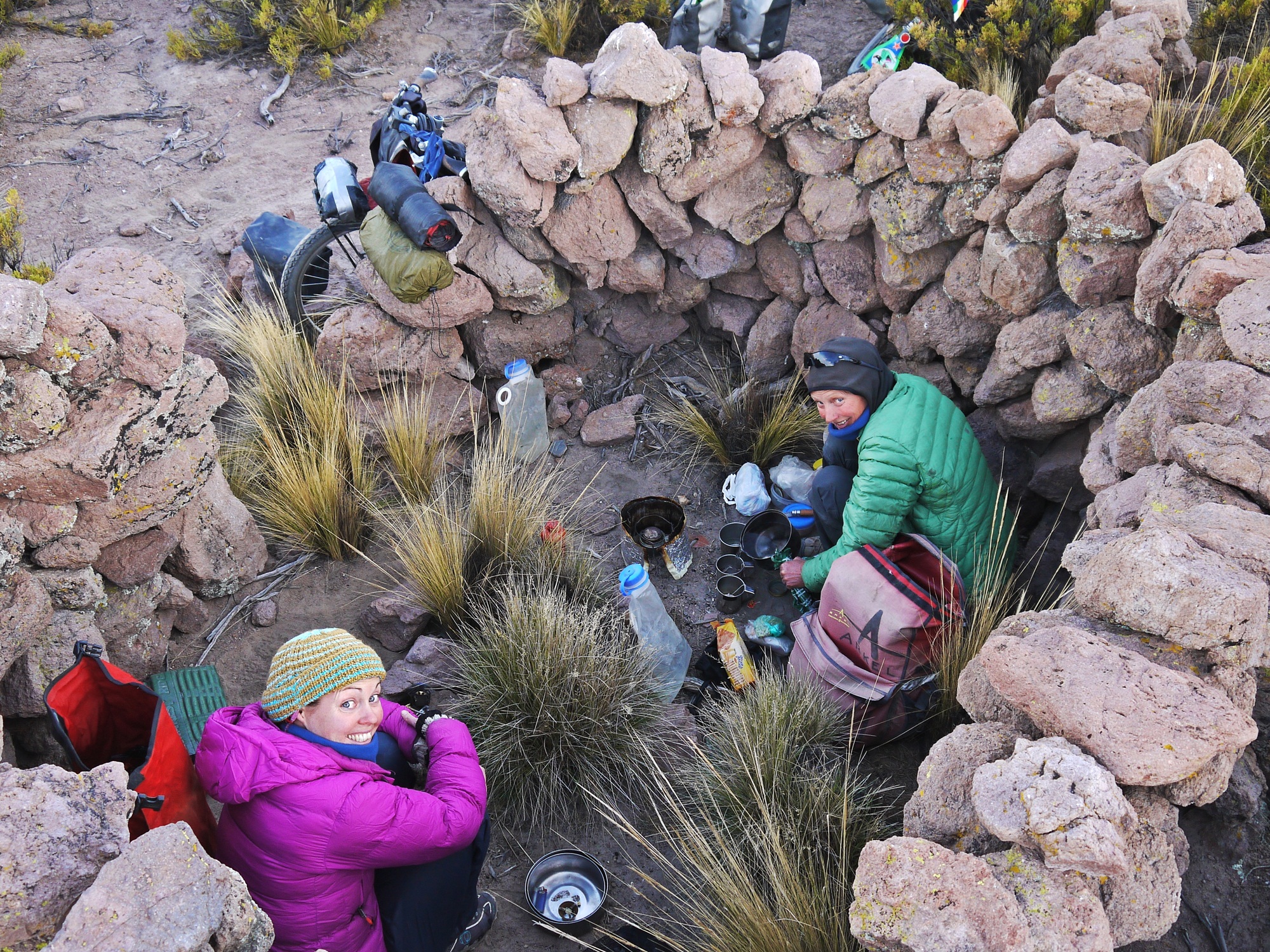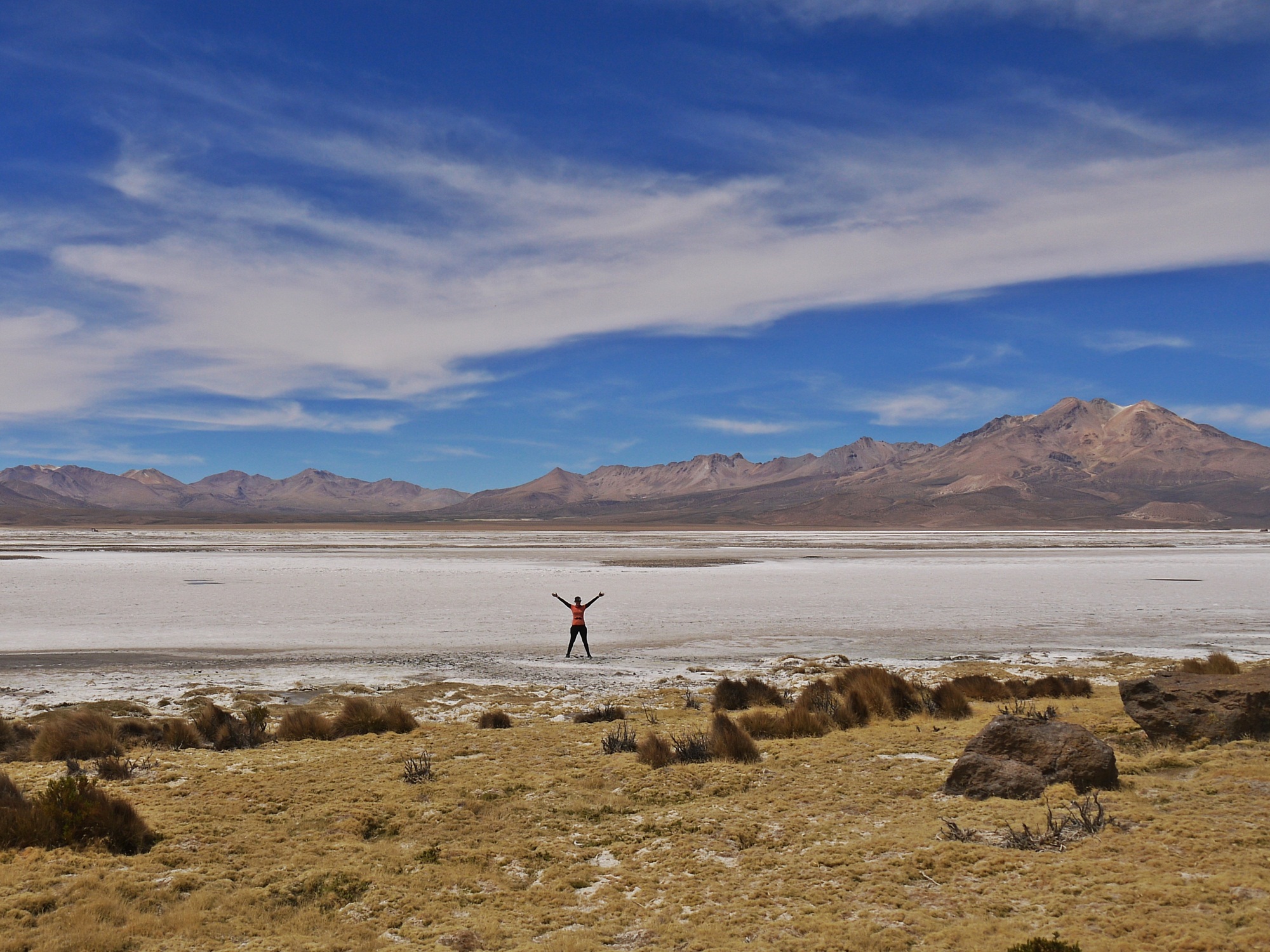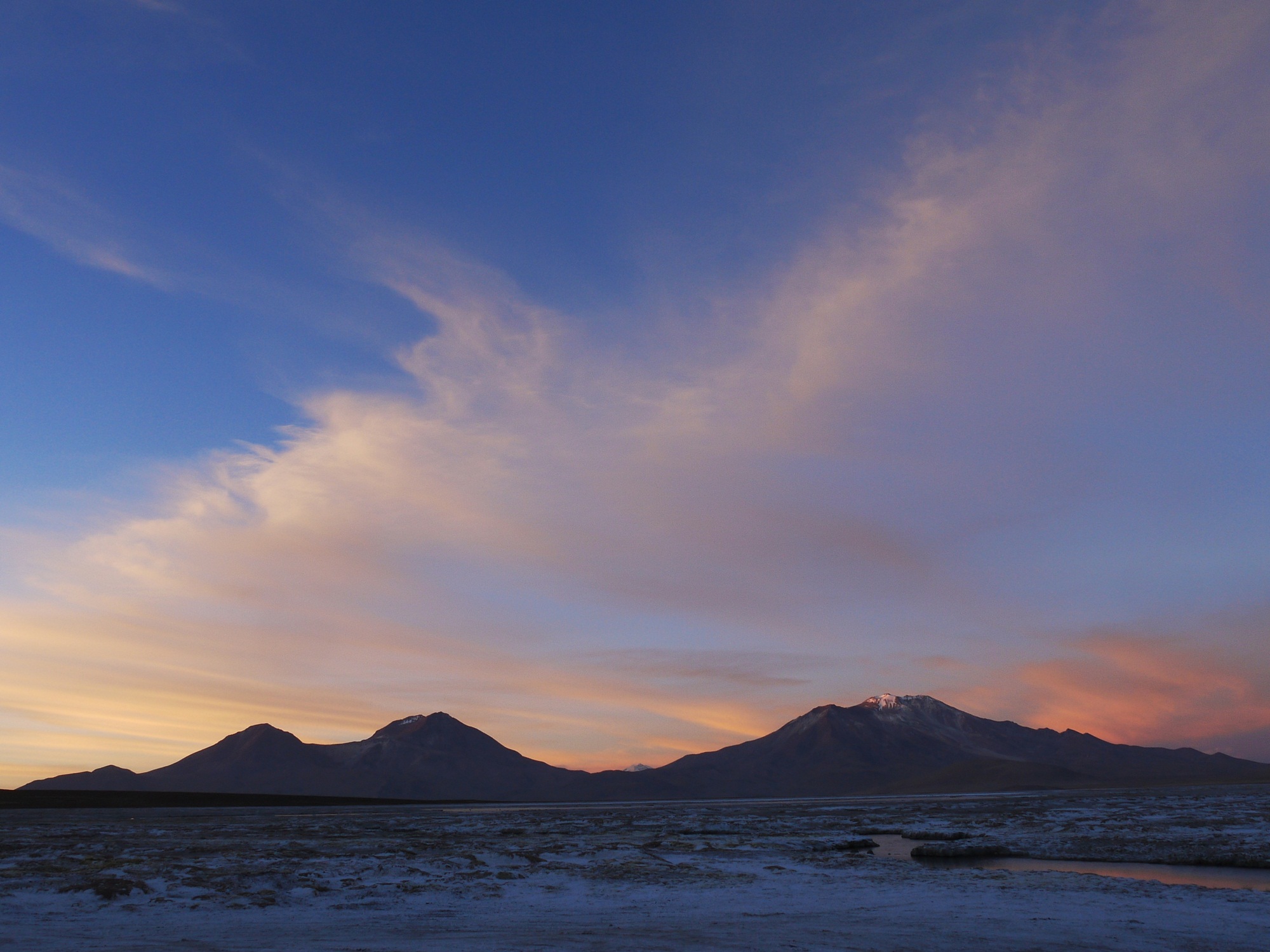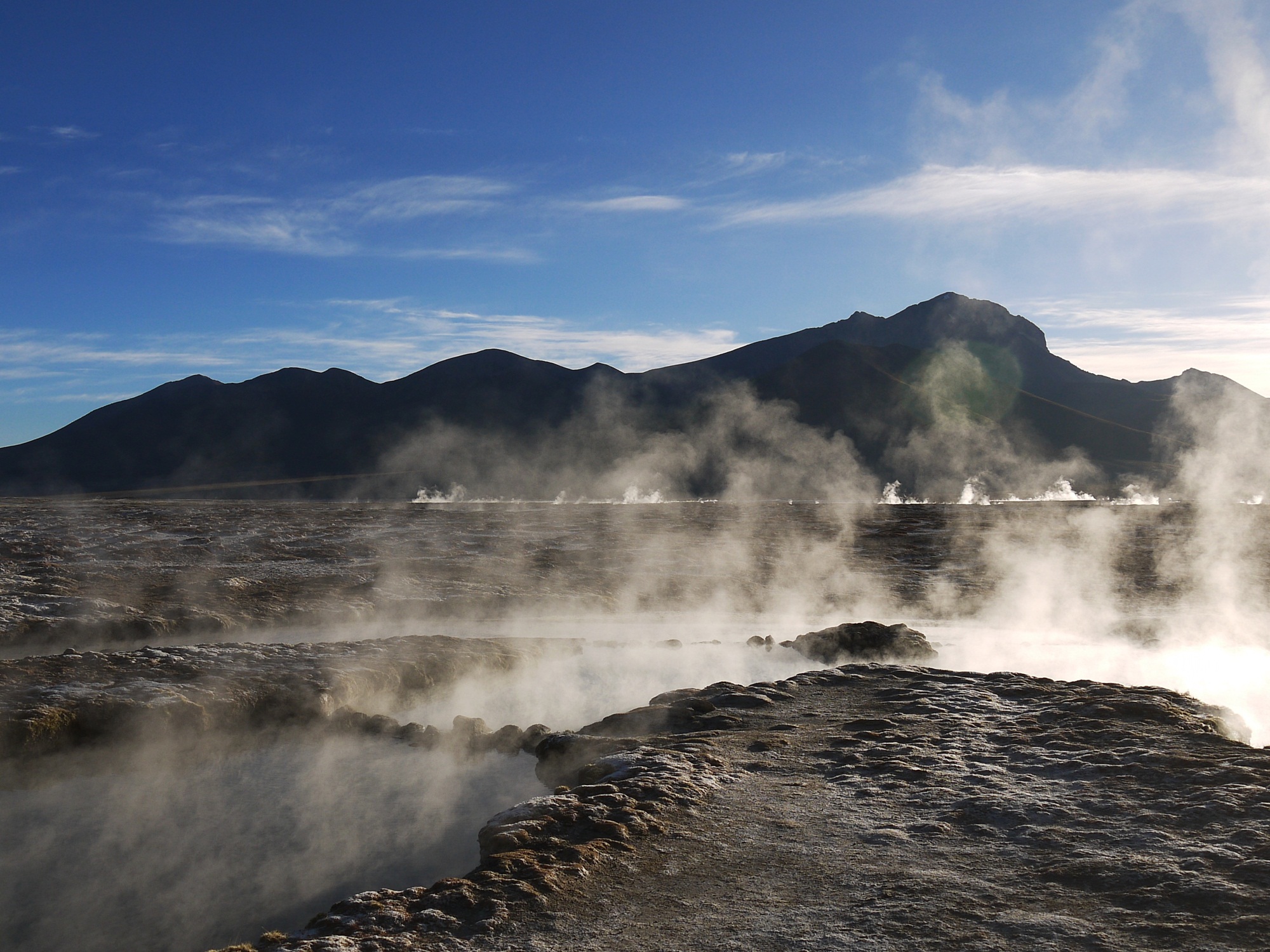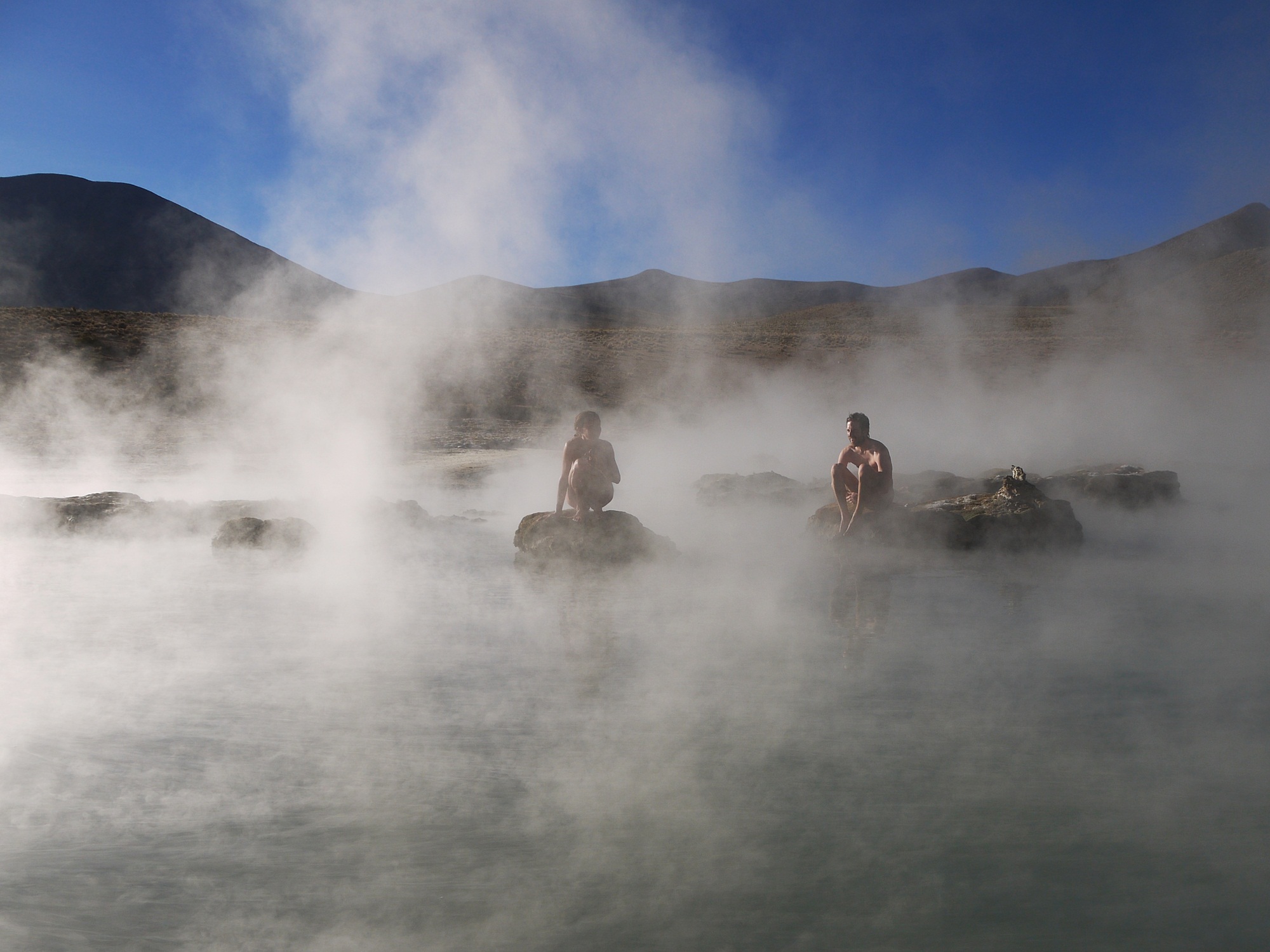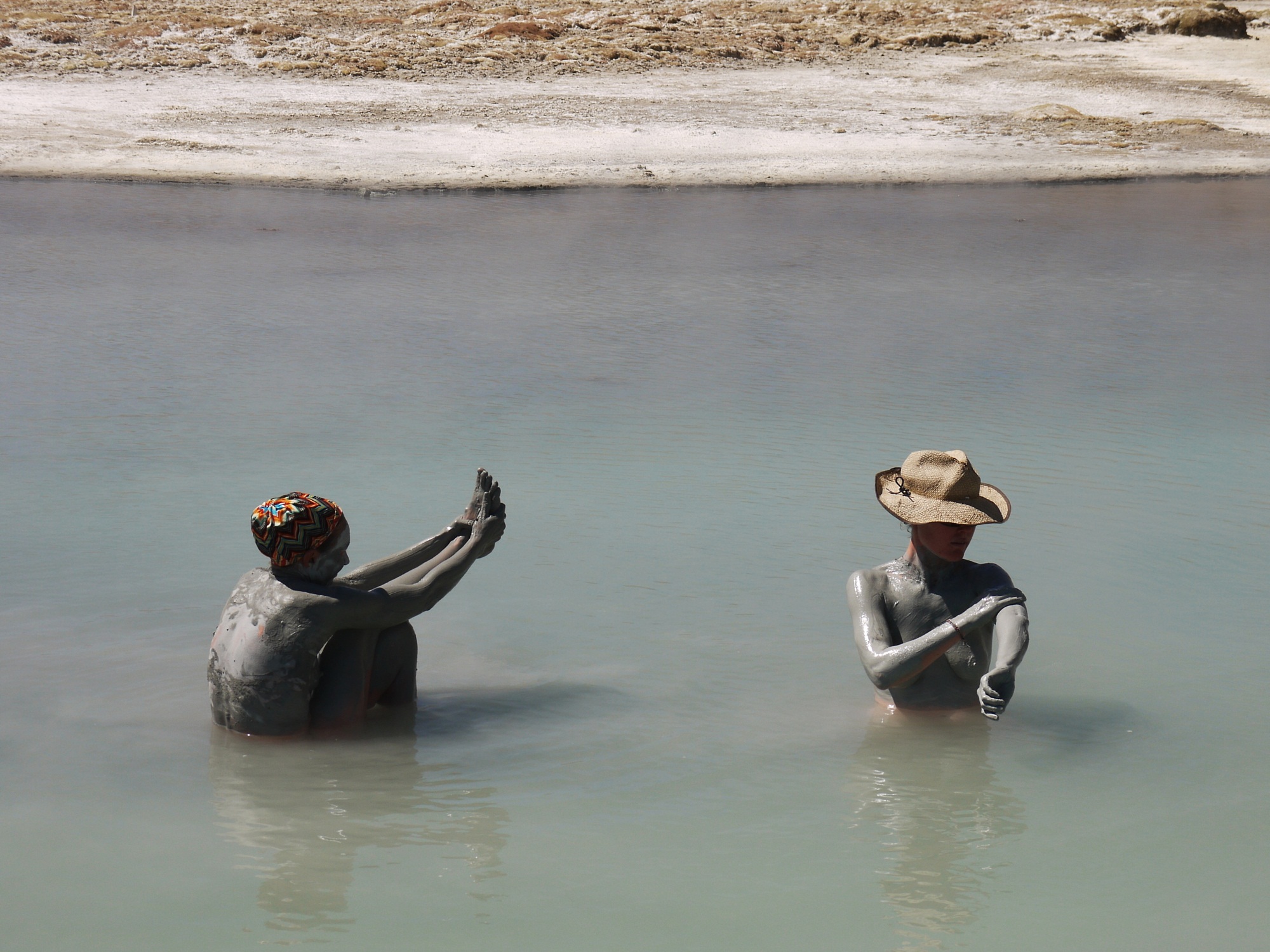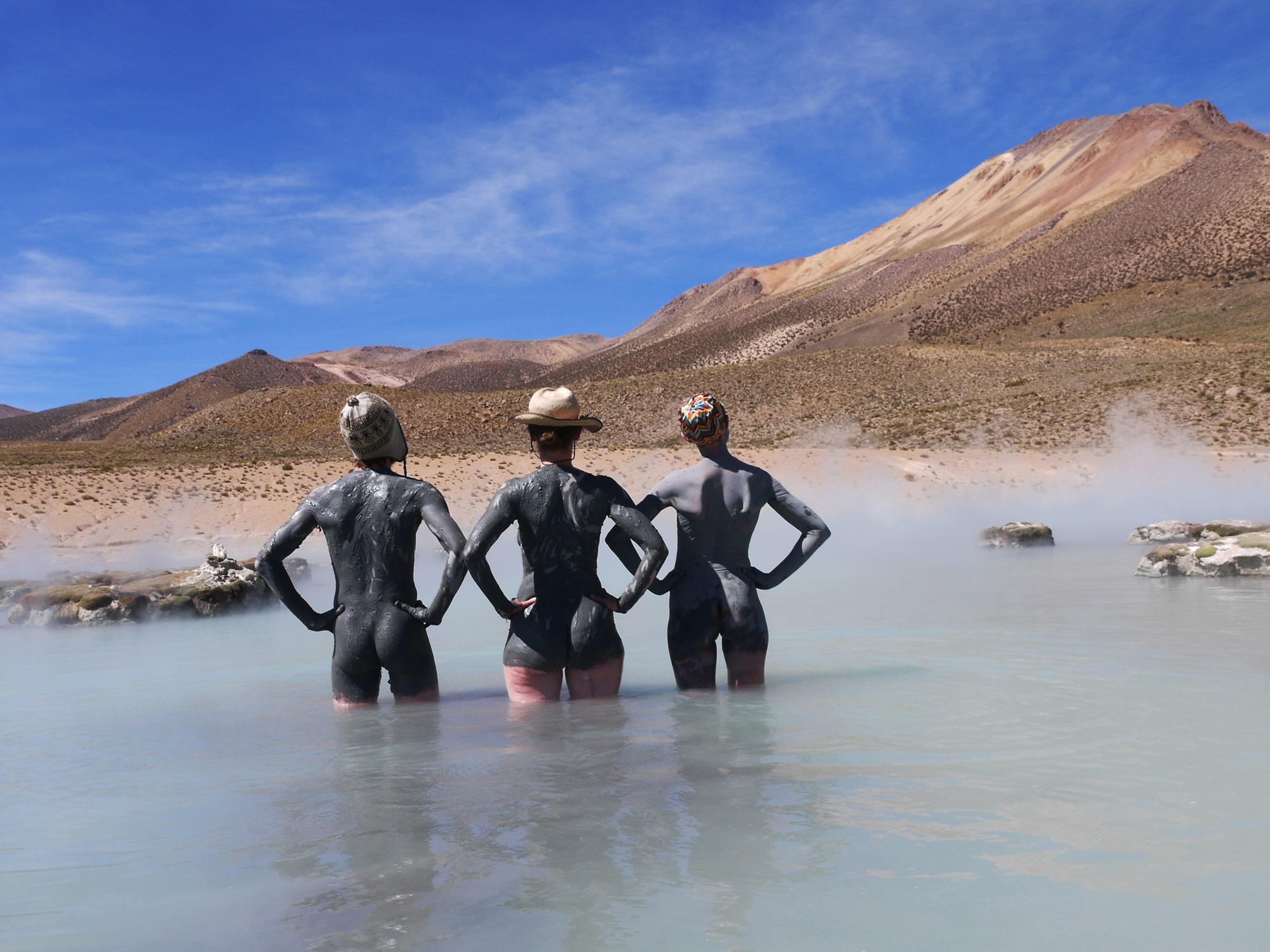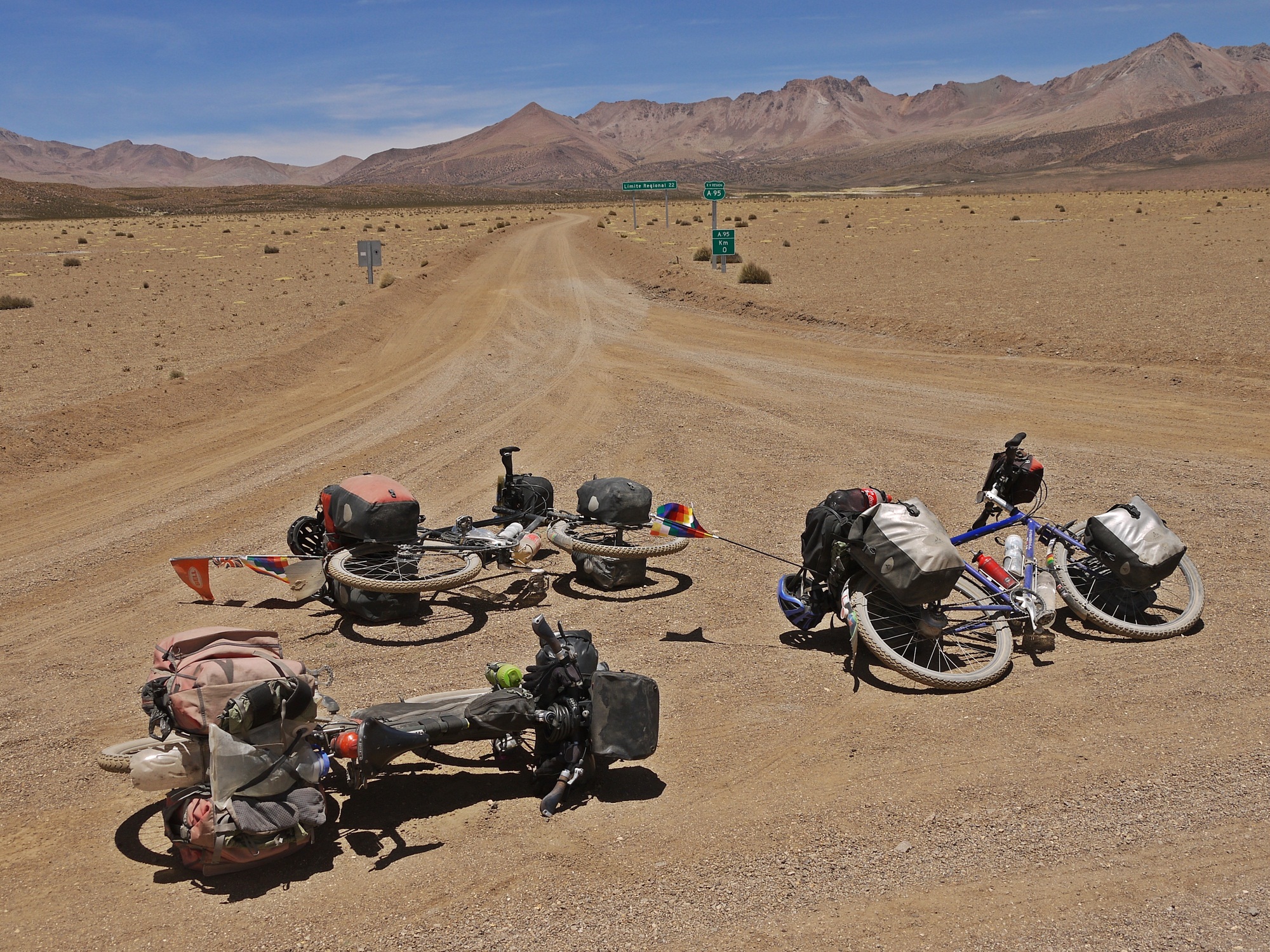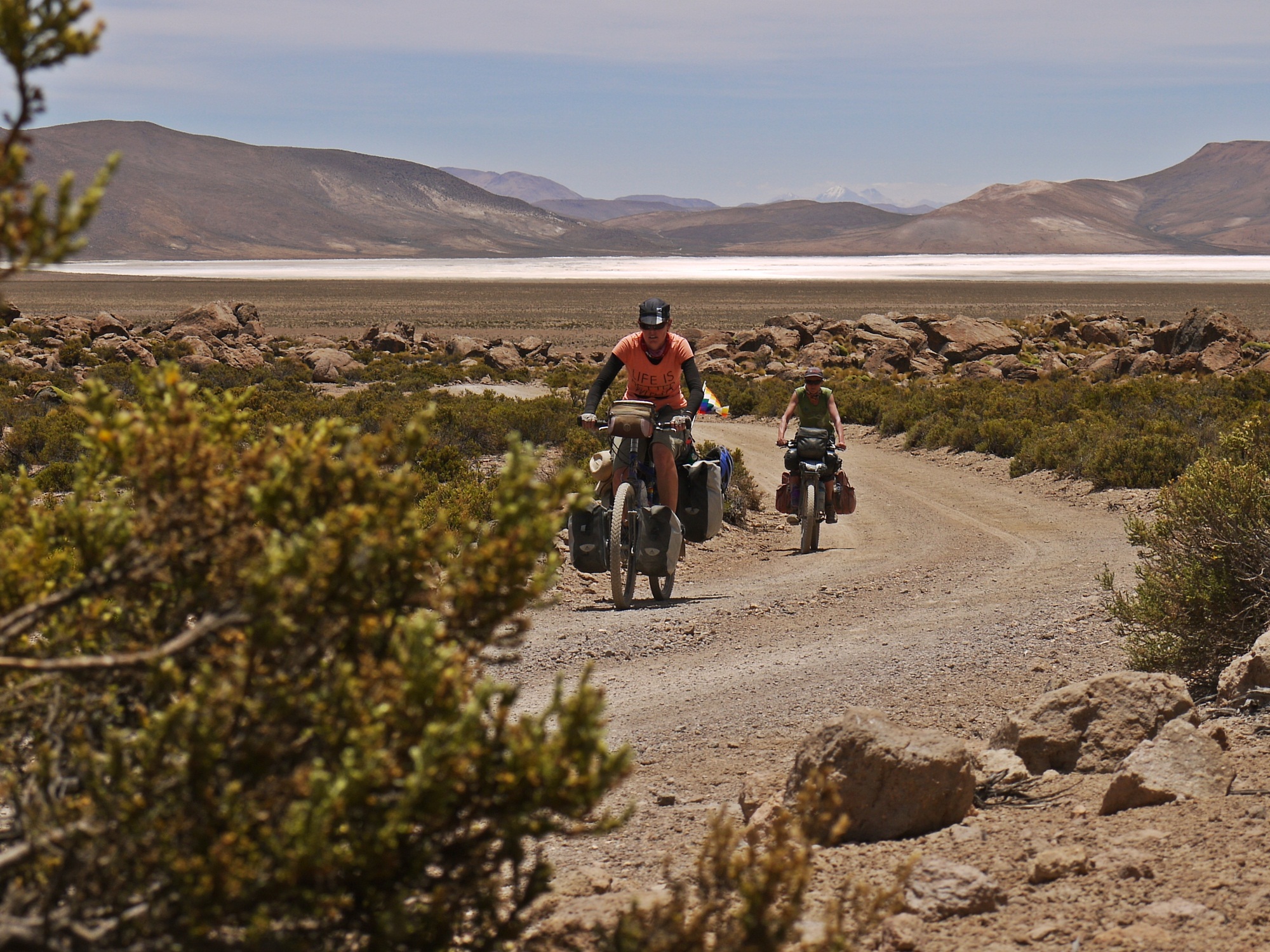Lake Titicaca – and Bolivia by the back door
October 1st, 2013
As we reshuffled our idea of descending into Arequipa’s canyons due to lack of time, our exit from Peru suddenly included visiting the famous Lake Titicaca. Sitting astride Peru’s and Bolivia’s border, the local joke goes something along the lines of “Peru got the titi and Bolivia got the caca” but our trip around the lake was equally enjoyable on both sides.
There is no immigration control on the far side of the lake, so from Lampa, we travelled by bus to get our passports stamped in Puno (more details at the end of this post) before visiting the Capachica peninsula and then riding the eastern side of the lake on quieter roads to the border at Tilali.
Sarah & James
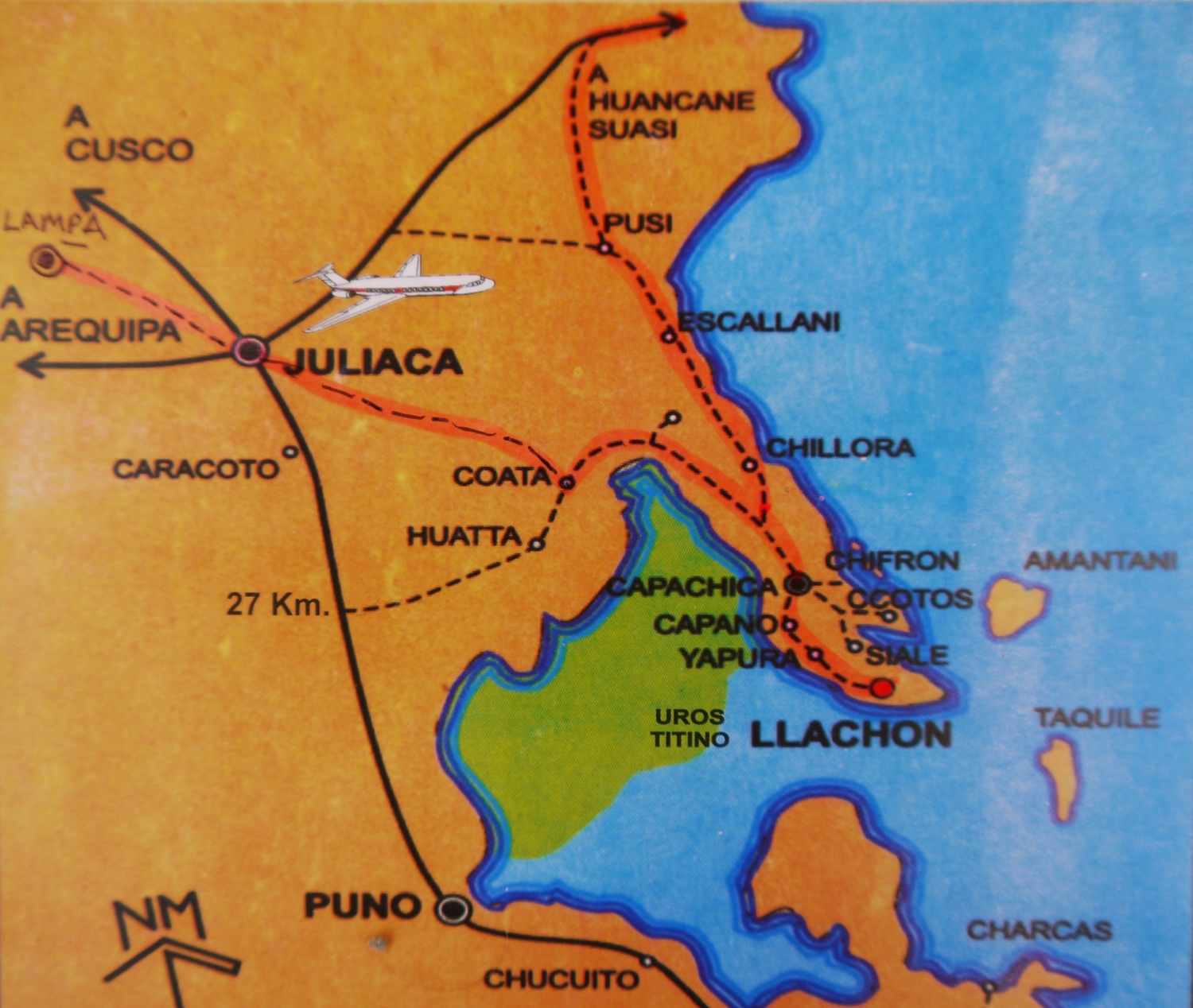
Our “high tech” map of the Capachica Peninsula (with our route marked in pink) which reaches out into the lake just to the east of Juliaca. We spend a few days here before heading towards Bolivia…
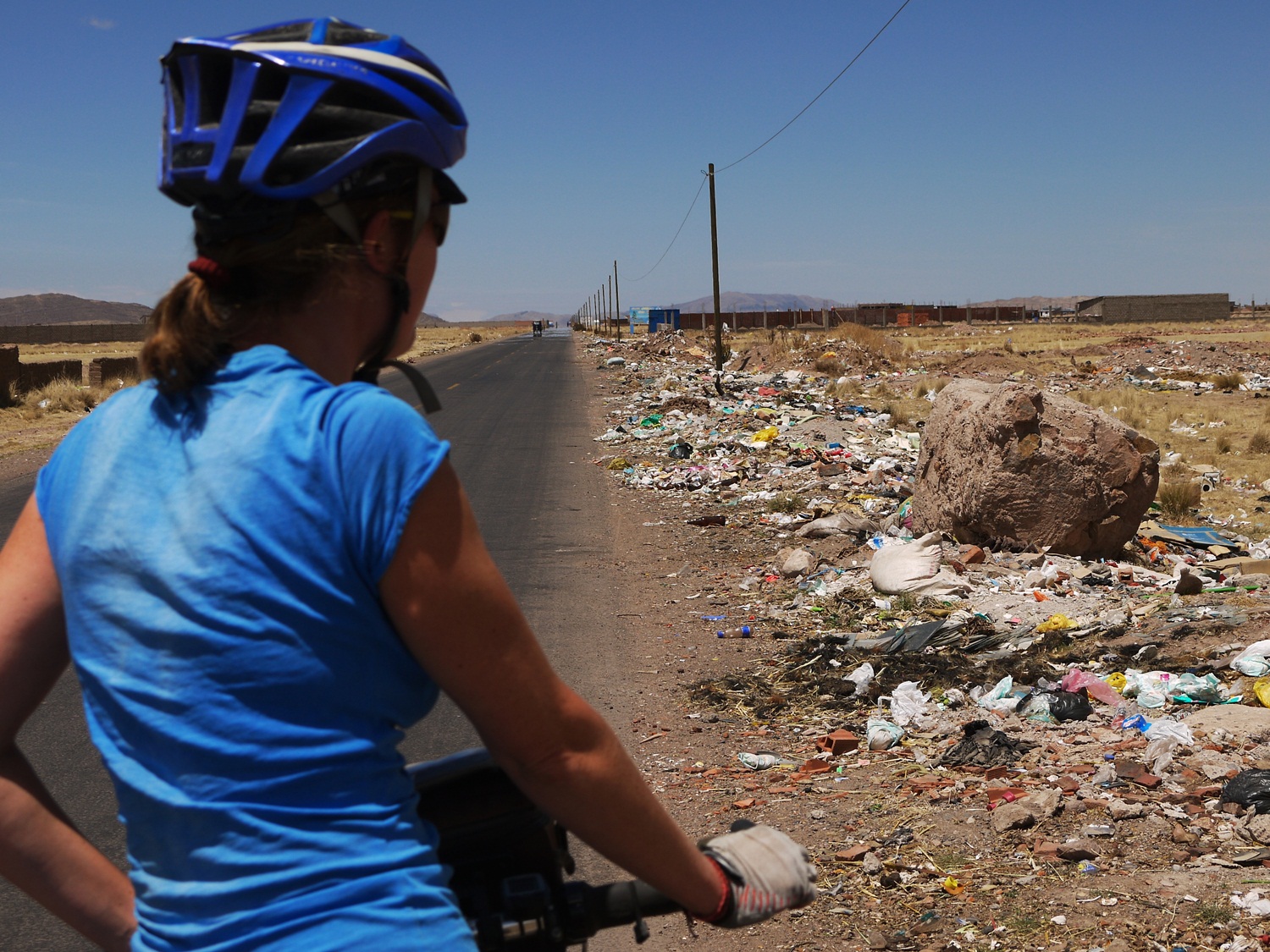
…but to get there, first we have to ride past this. Stretching out of Juliaca on the windswept altiplano is 15-20km of rubbish. Some brave souls sift through it for treasures to keep and sell but mostly it’s broken tvs and used nappies.
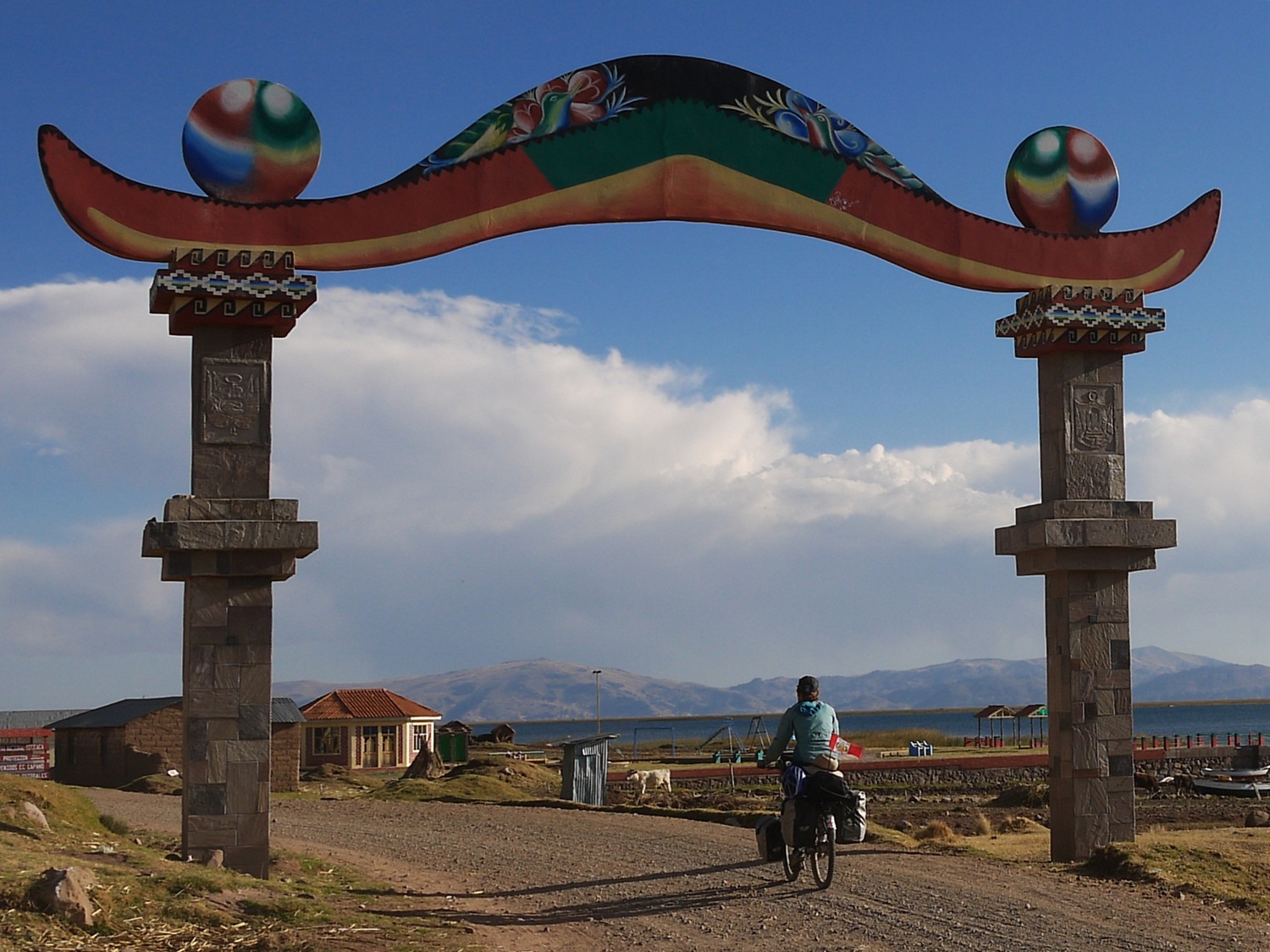
After riding through the town of Capachica, we reach a gate shaped as the hat typical to this region and we know we have arrived at the lake…
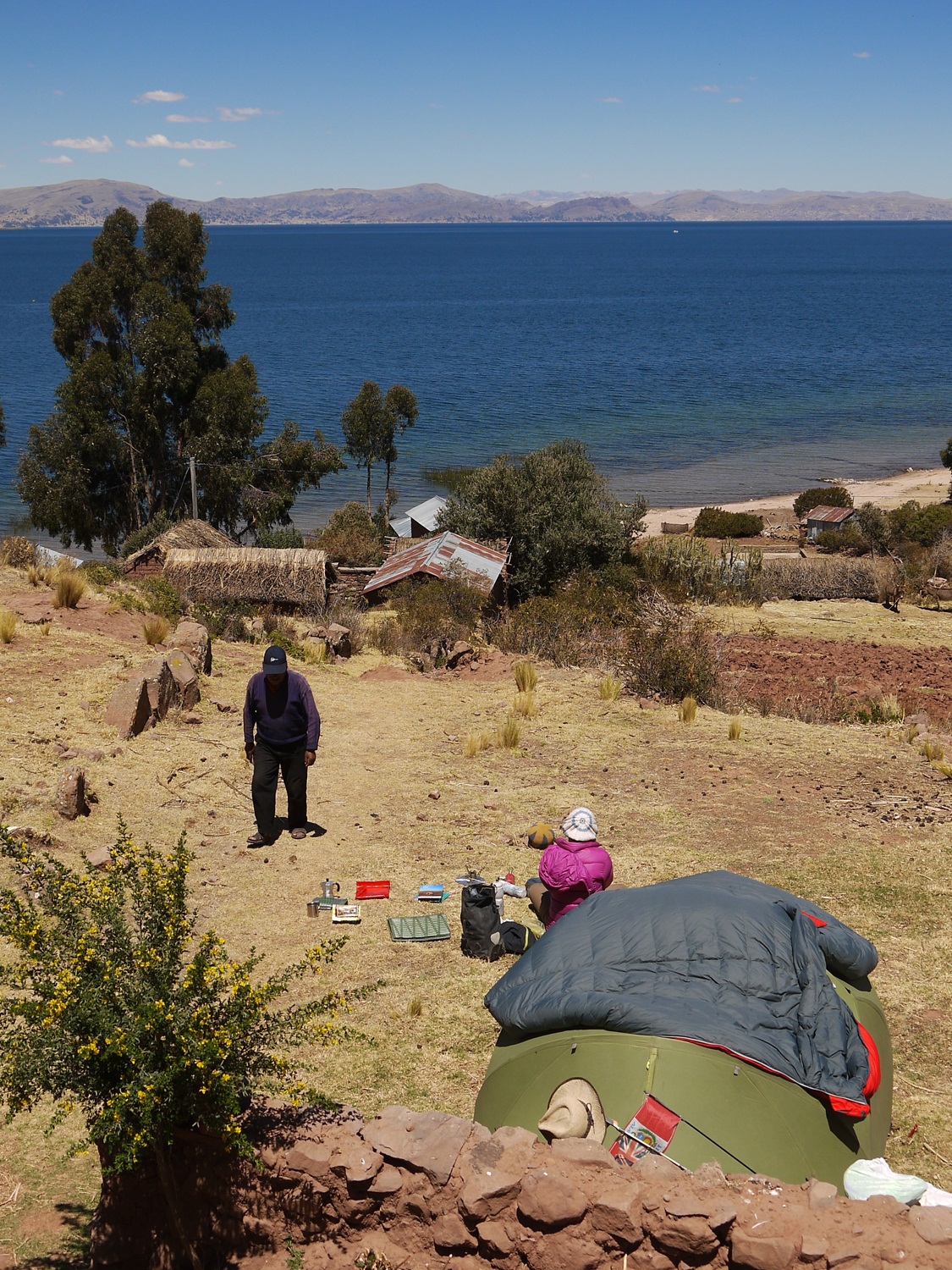
A rest day is prescribed and we pitch the tent at Kawai homestay near Llachón, overlooking the lake and back towards Puno…
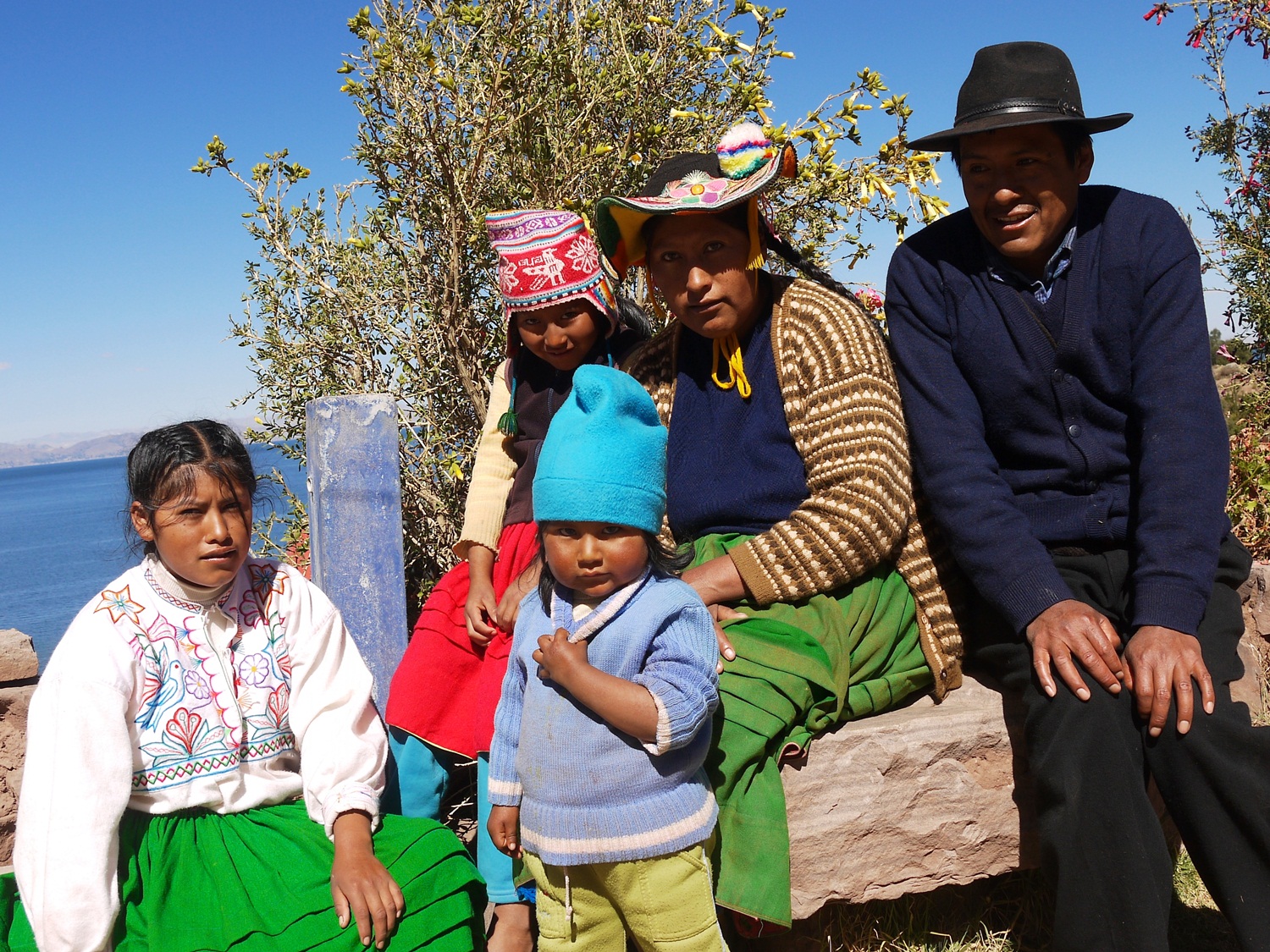
Kawai homestay: Magno and his family provide accomodation and tasty local meals overlooking the lake, just outside of the village of Llachón.

We drag ourselves out of the tent at 0430 and up to the highest point of the peninsula to see the sun rise over the lake. The magnificent views are more than enough reward for the effort – thanks for the tip Alfie!
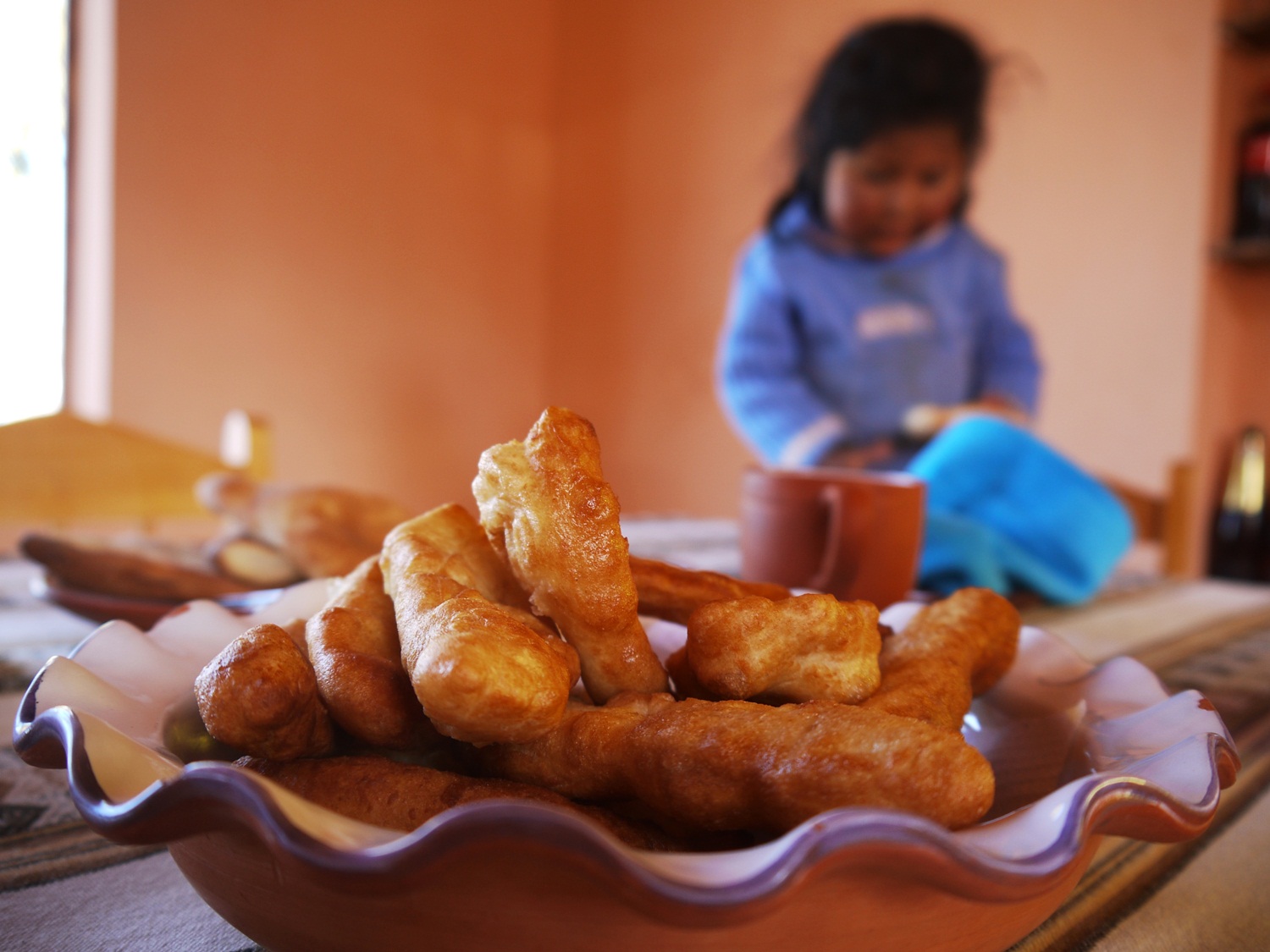
And we still make it back to the homestay in time for delicious fresh doughnuts and jam for breakfast.
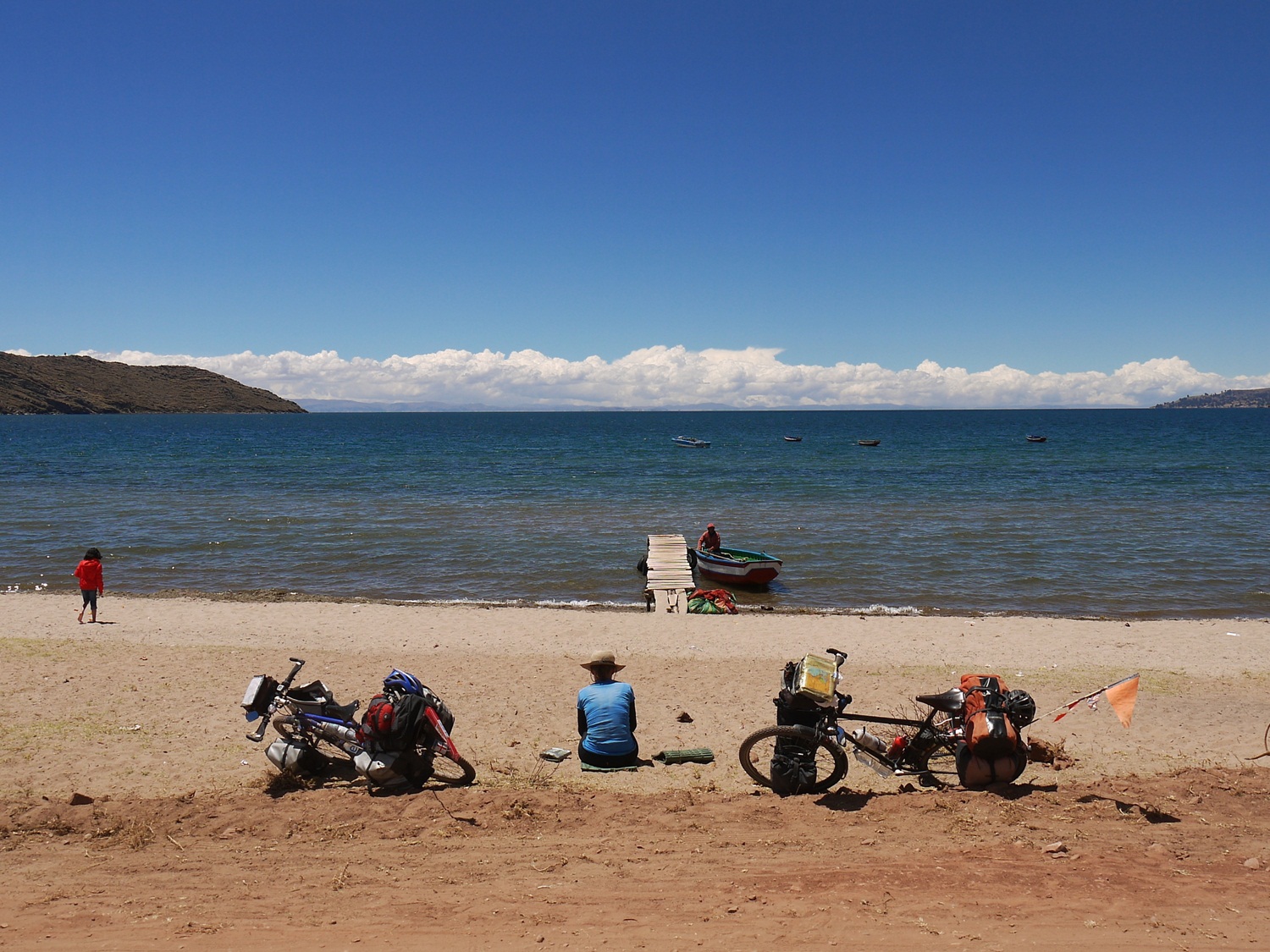
A leisurely ride around the rest of the peninsula and we are at Playa Chifrón just in time for lunch on the beach…
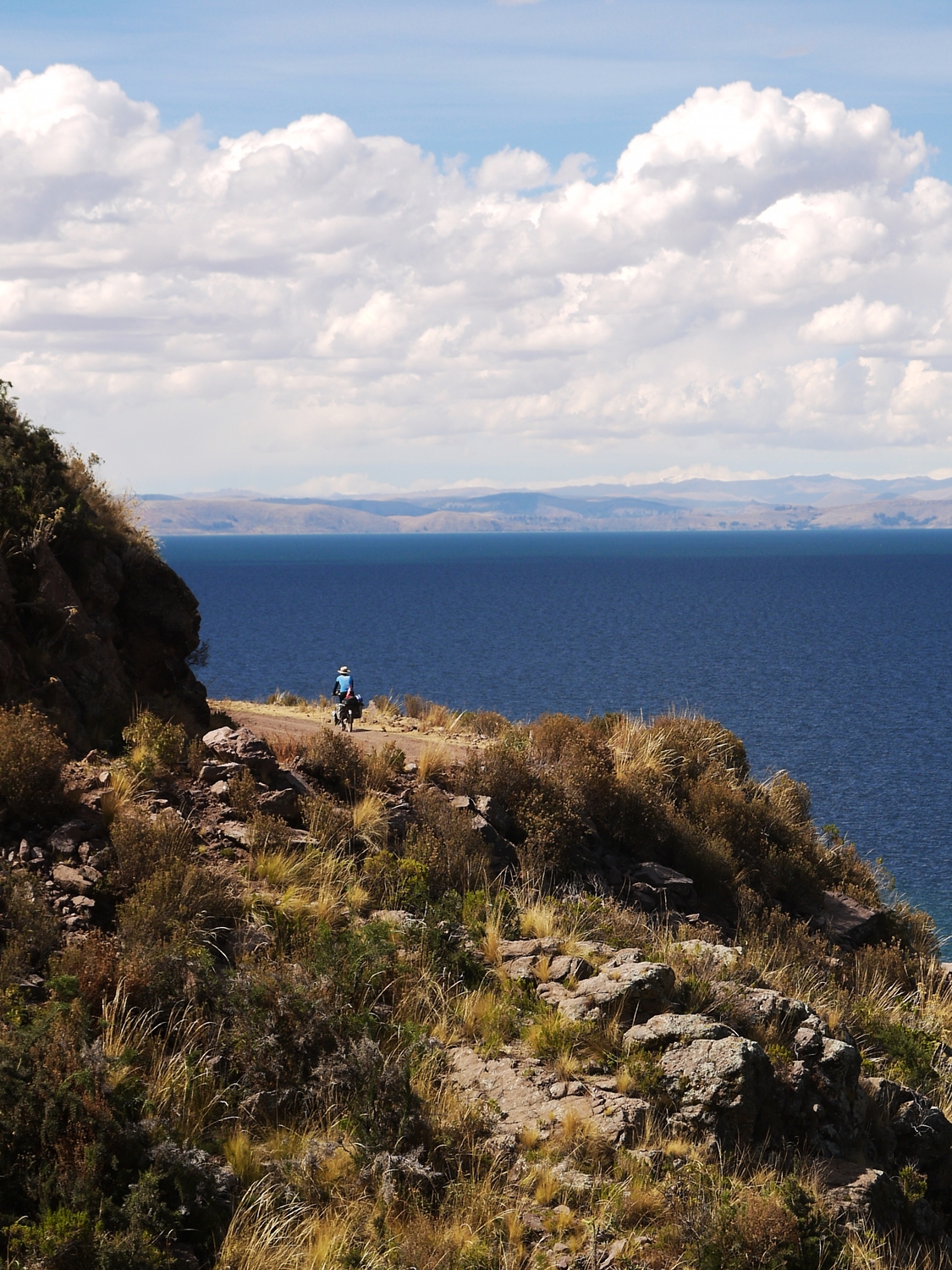
Riding away from the peninsula towards Escallani, we follow a wonderful dirt road that hugs the coastline…
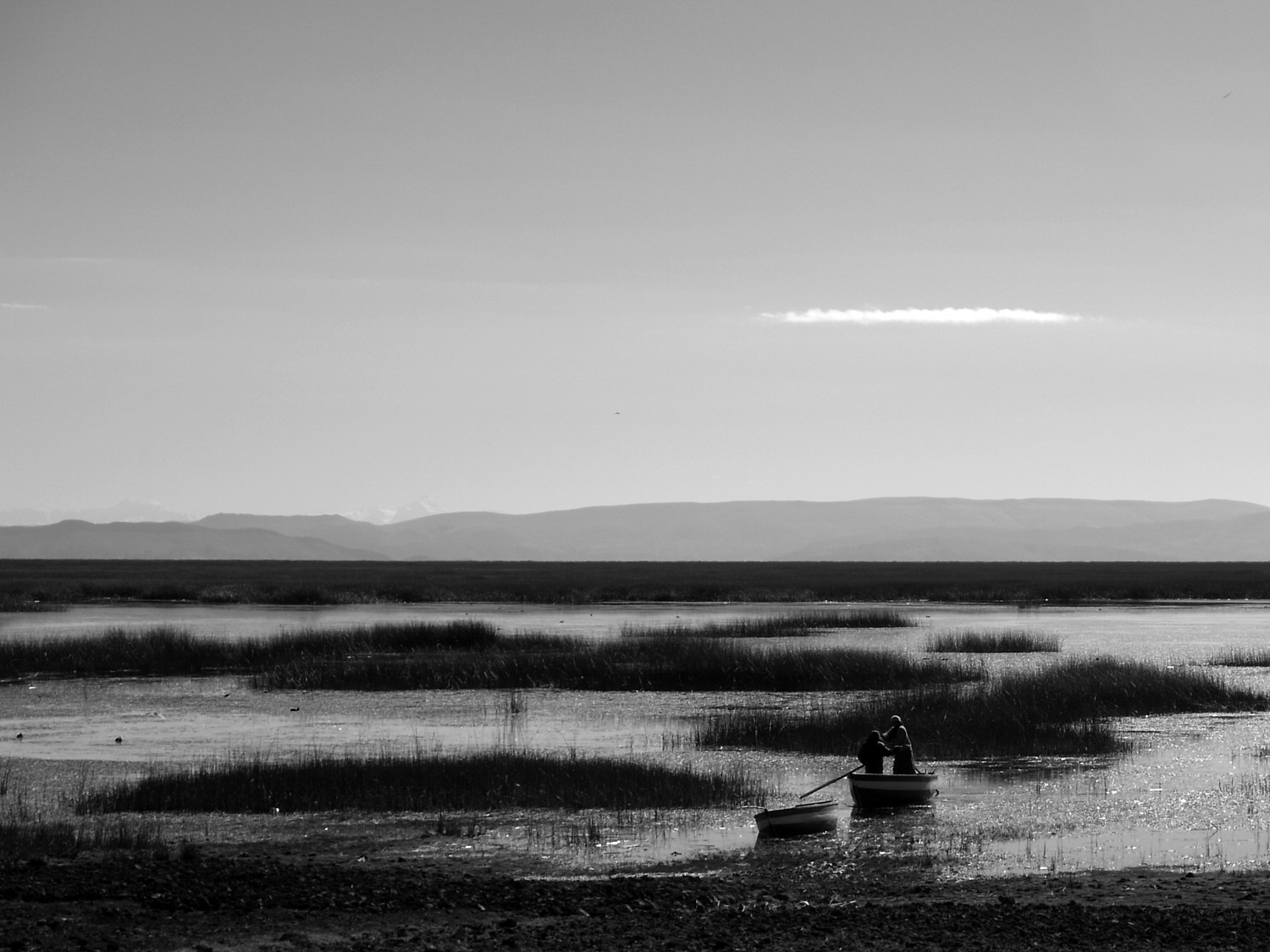
…and the boats are out collecting totora; the prolific reed that grows on the shore is used for everything from eating to weaving to animal fodder.
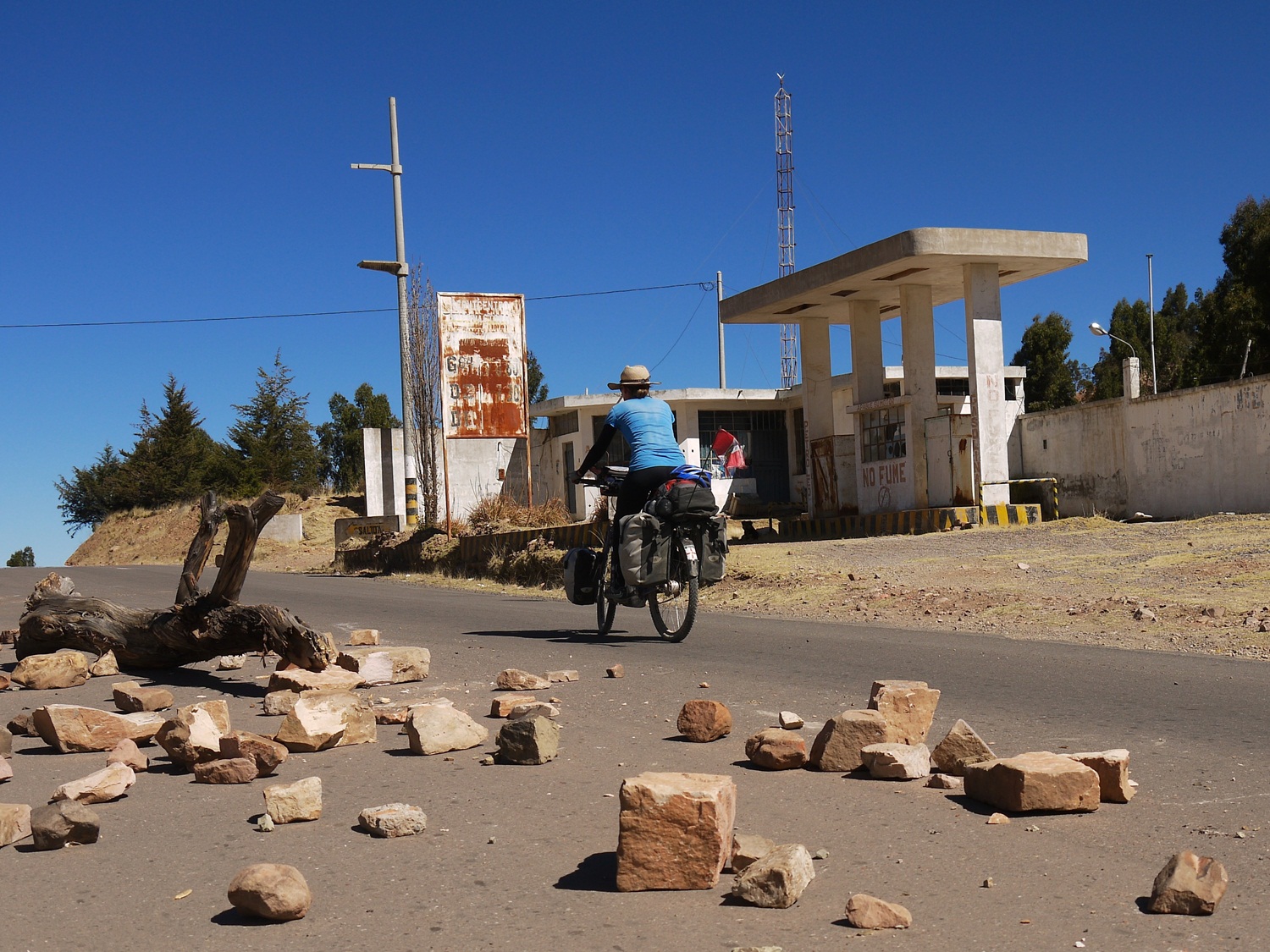
The people of Huancané, upset with their corrupt mayor, lay a road block in protest. Thankfully cyclists are allowed through…
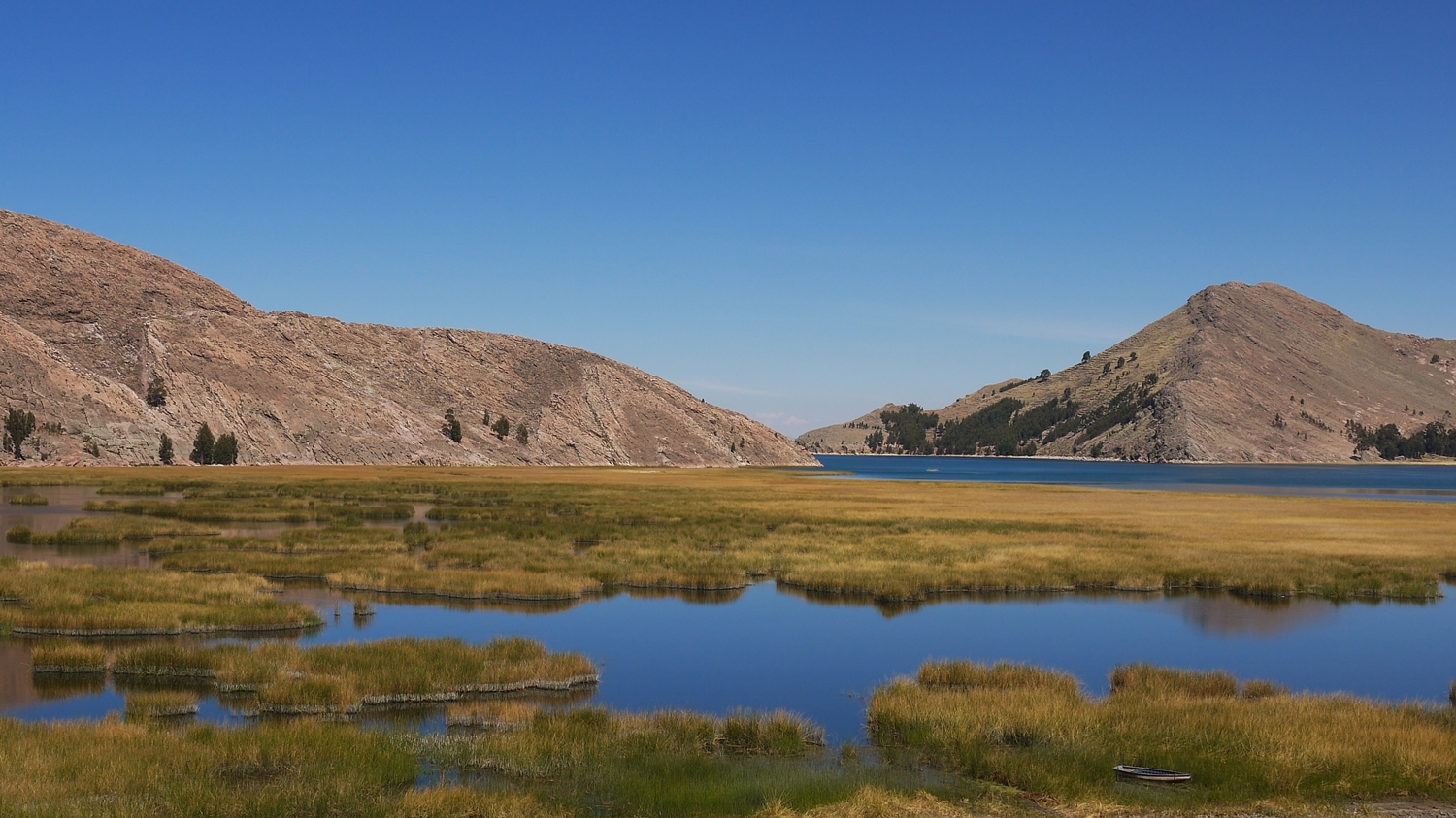
…and we reach the “other” side of the lake. Little traffic and beautiful views make it the perfect way to leave Peru.
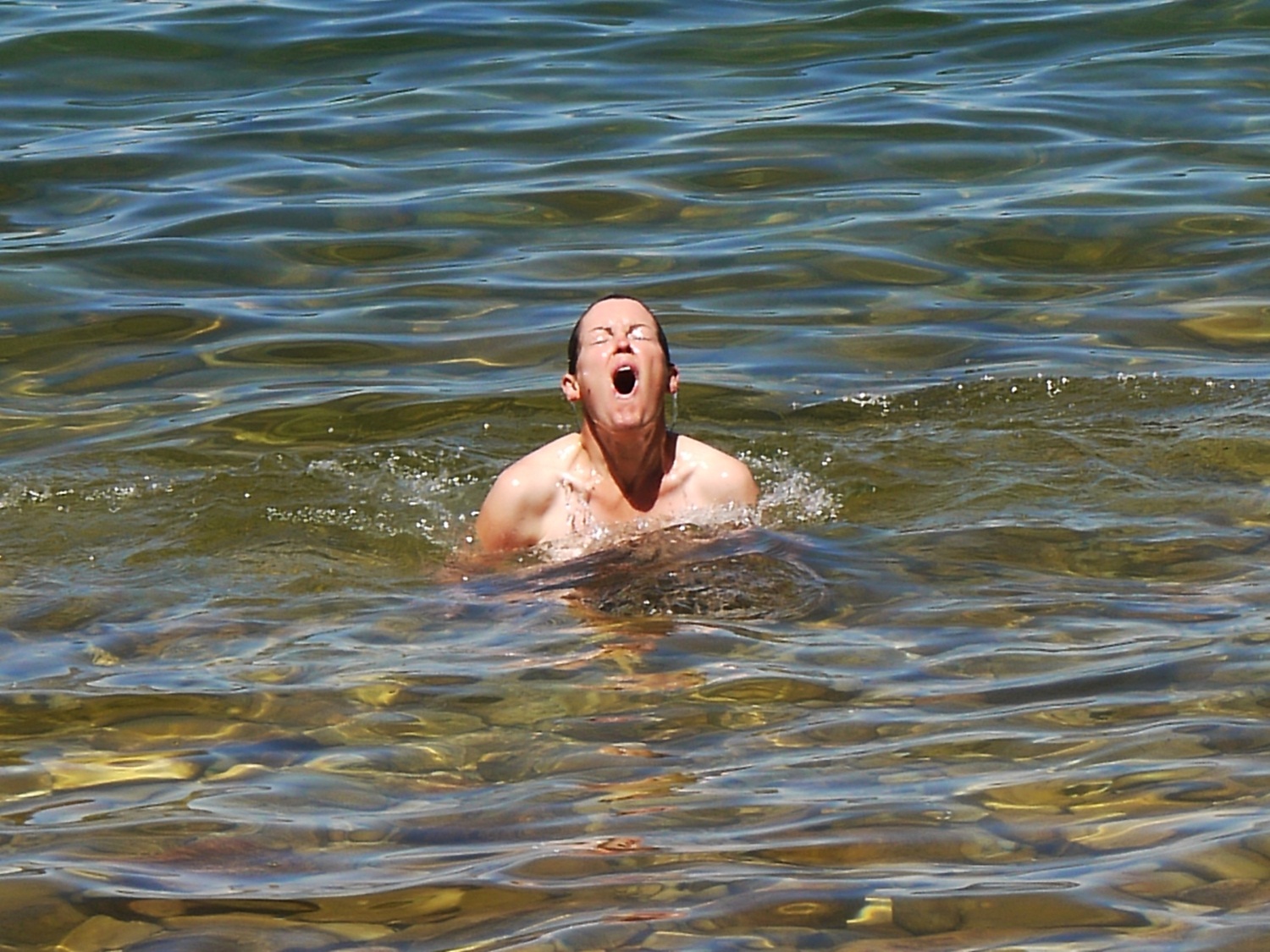
…nothing for it but to get stuck in. It freezes my brain! I am really not a fan of jumping into cold water but I can’t just sit on the beach and observe; this is Lake Titicaca after all.

We warm back up in the sun and enjoy sweet granadillas; this kind of tropical fruit will be harder to come by in Bolivia, we are told, so we eat as much as we can in our last few days in Peru.
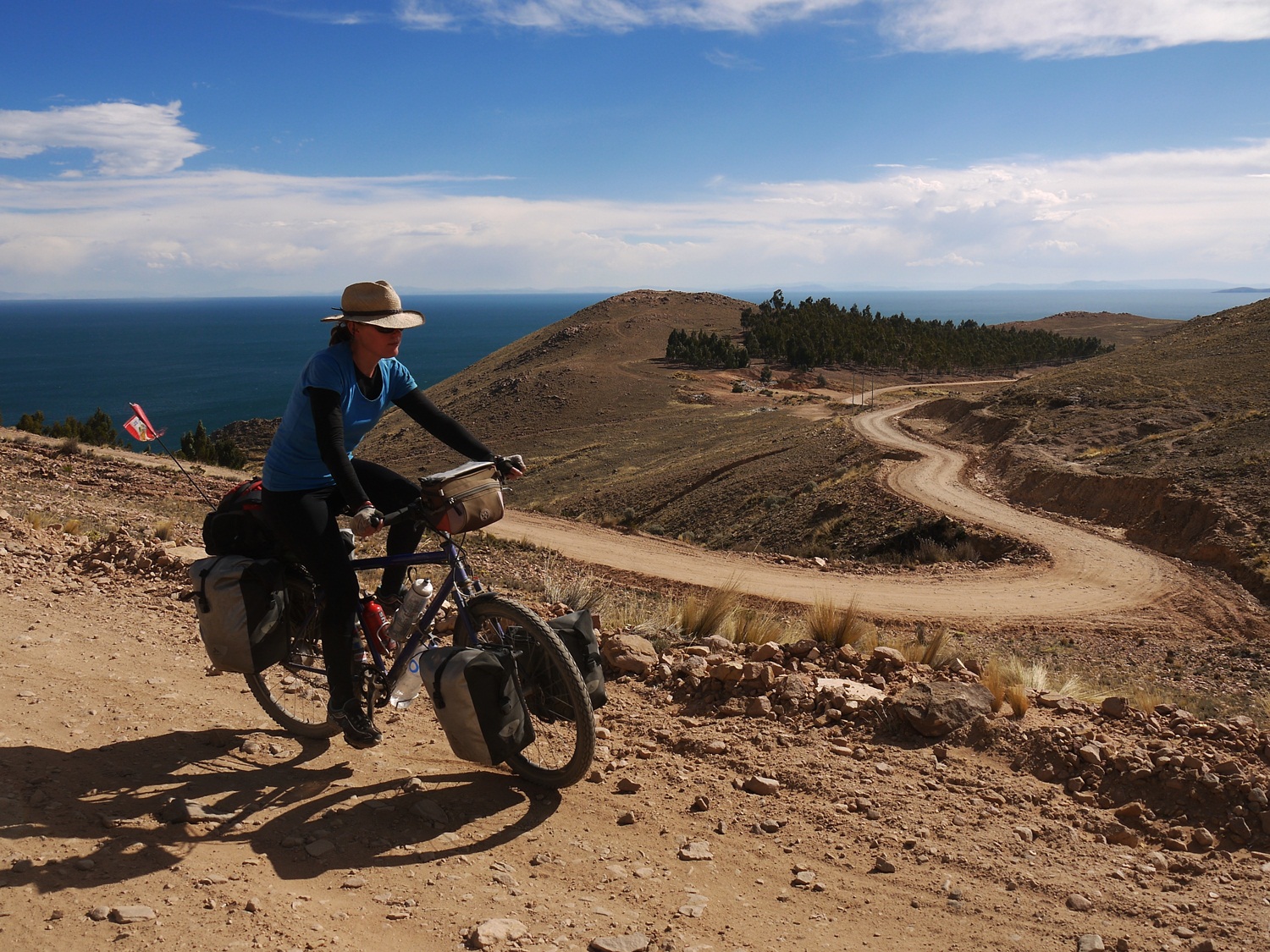
After passing the police checkpoint at Tilali, Peru has one tough climb left for us. I grumble all the way up and vow to make a case to the Office of International Border Crossings (there must be one, right?) that they do not always have to choose difficult dirt climbs to mark the territories between countries…or perhaps it’s just the particular borders we choose to cross at?
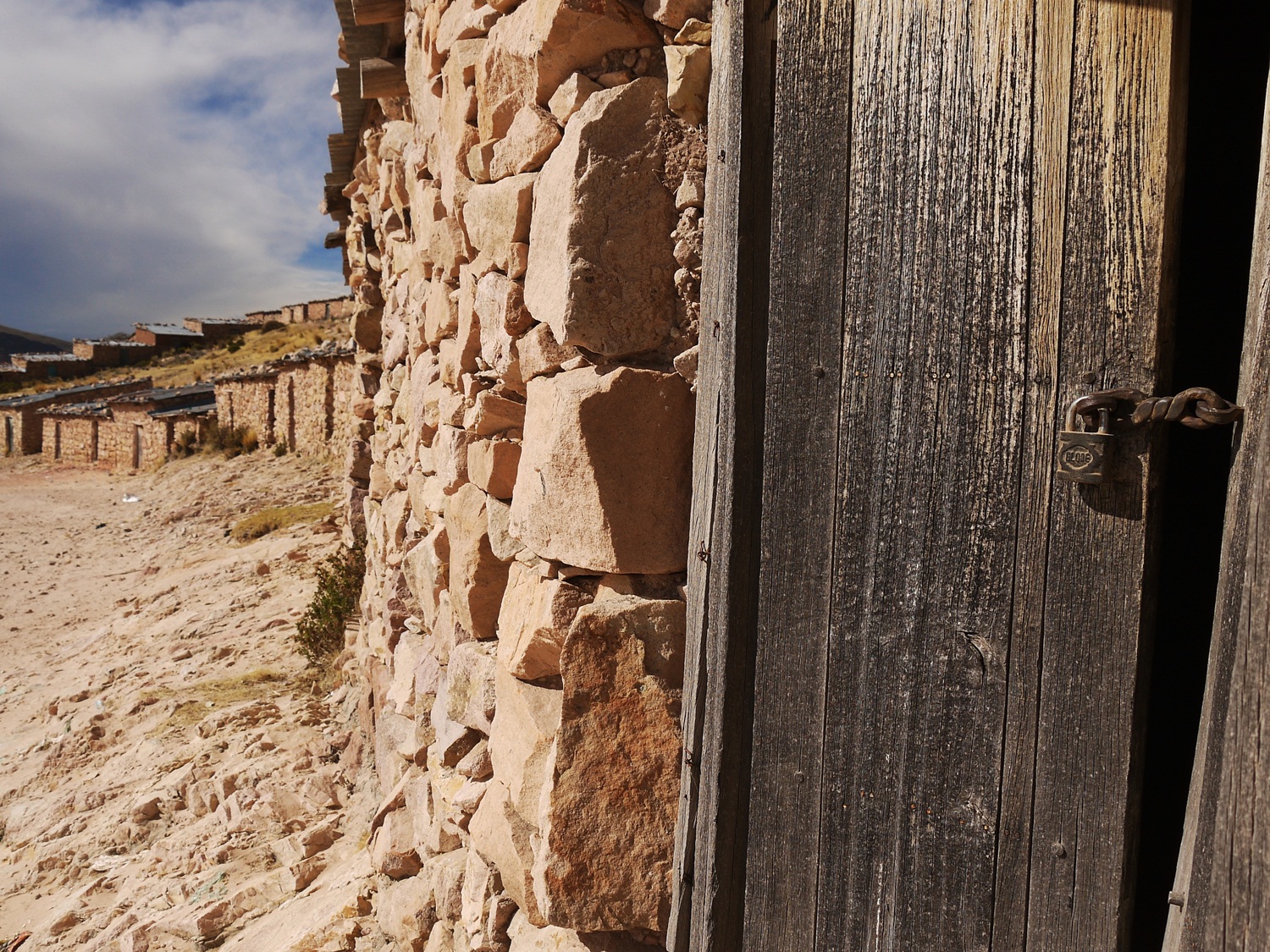
There’s no one else up here, just hundreds of empty buildings that are used on Wednesdays and Saturdays for a huge contraband market.
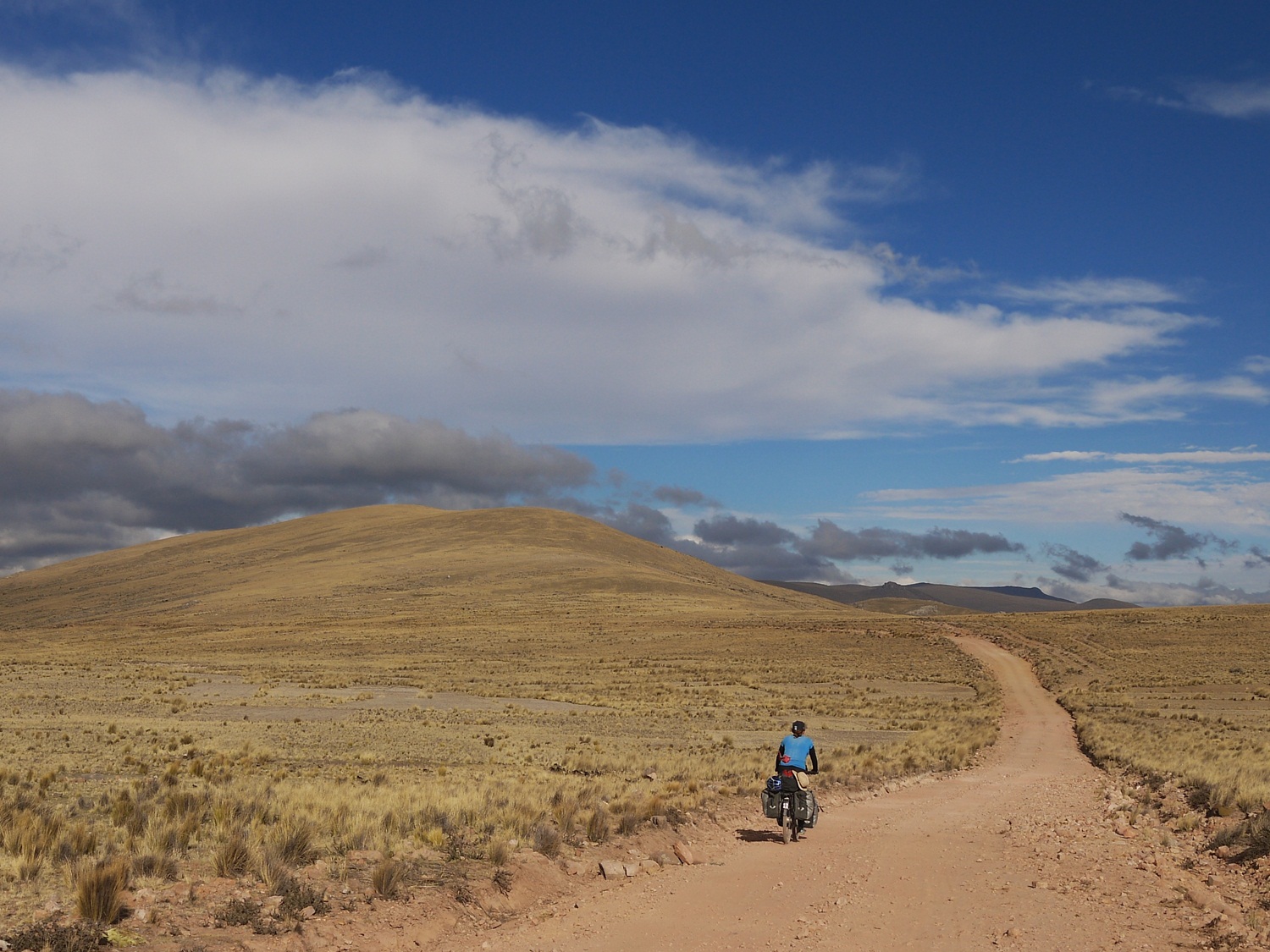
No-man’s land (and the climbing) continues much further than I anticipate; it’s an 18km slog from Tilali to Puerto Acosta, the first town on the Bolivian side. We arrive shattered and seek out dinner…
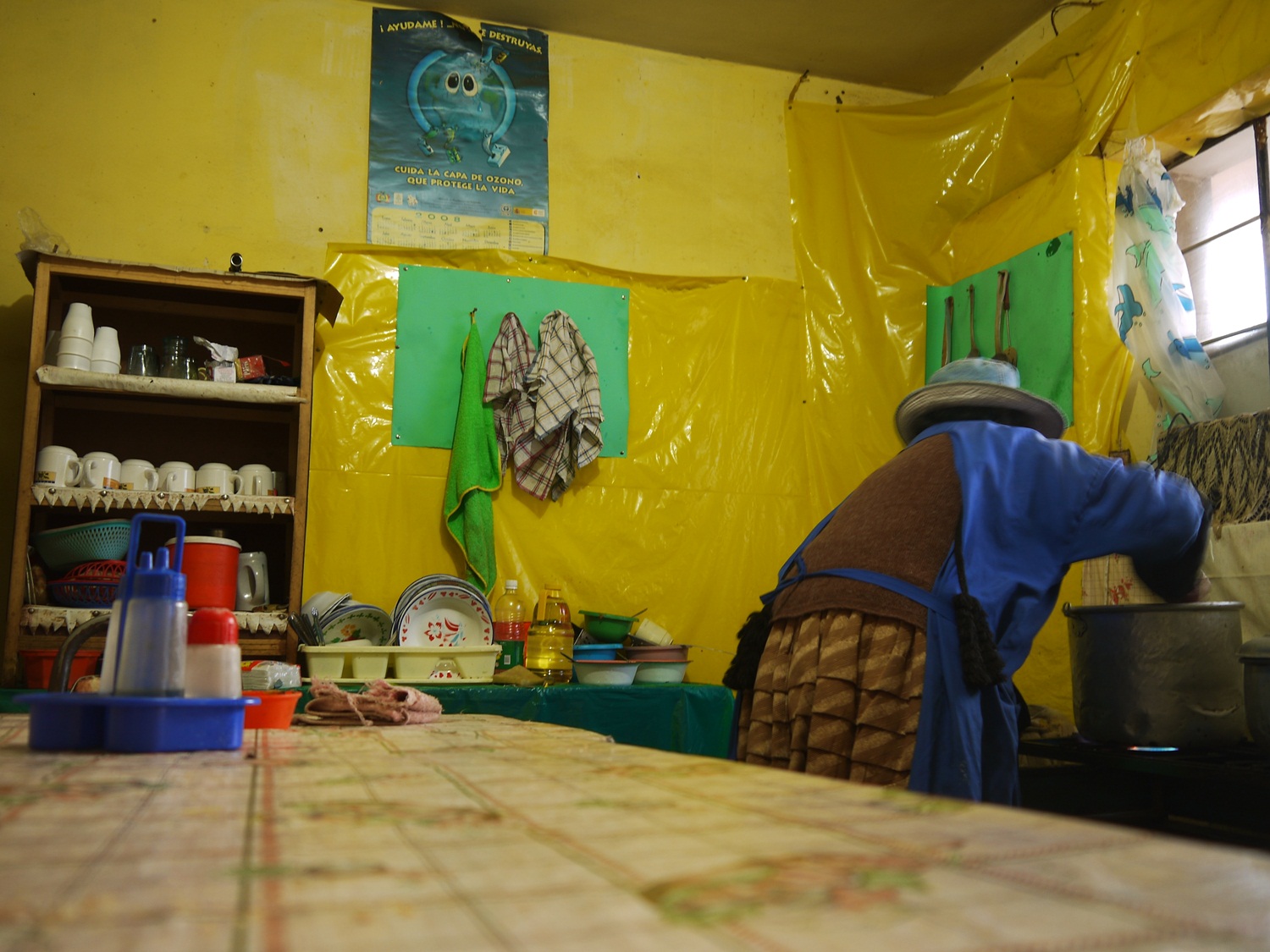
…which we find at a kiosko in a deserted square. First food impressions are positive: hot hearty soup followed by a heaped plate of rice, potatoes and minced beef for just over US$1. Exactly what is needed.
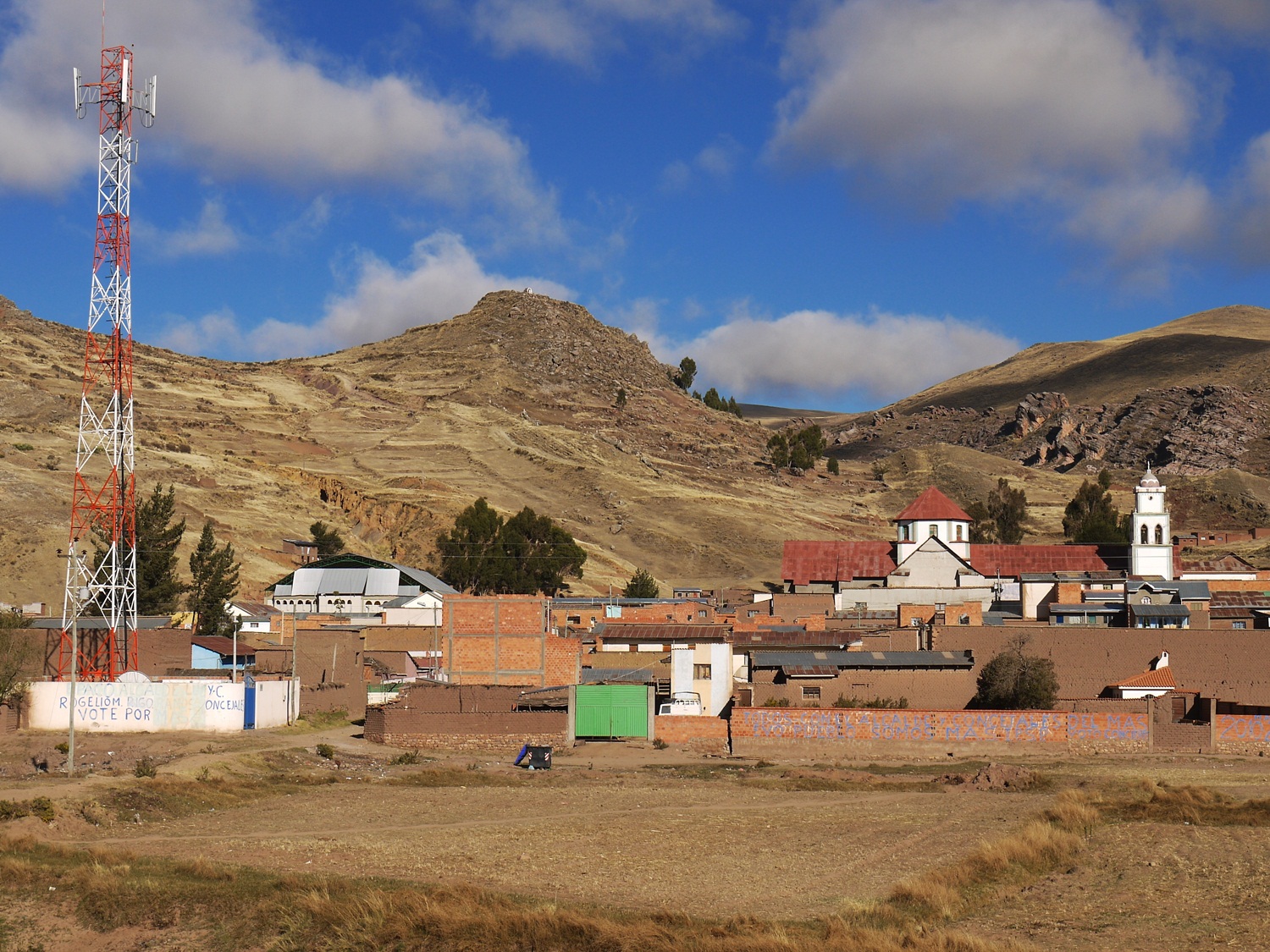
Our first impressions of Puerto Acosta on the otherhand are pretty bleak – we arrive as it’s getting dark and there is a bitter wind blowing around a town where seemingly no one lives. The following morning both the people and the sun emerge and it’s a much nicer place to be.
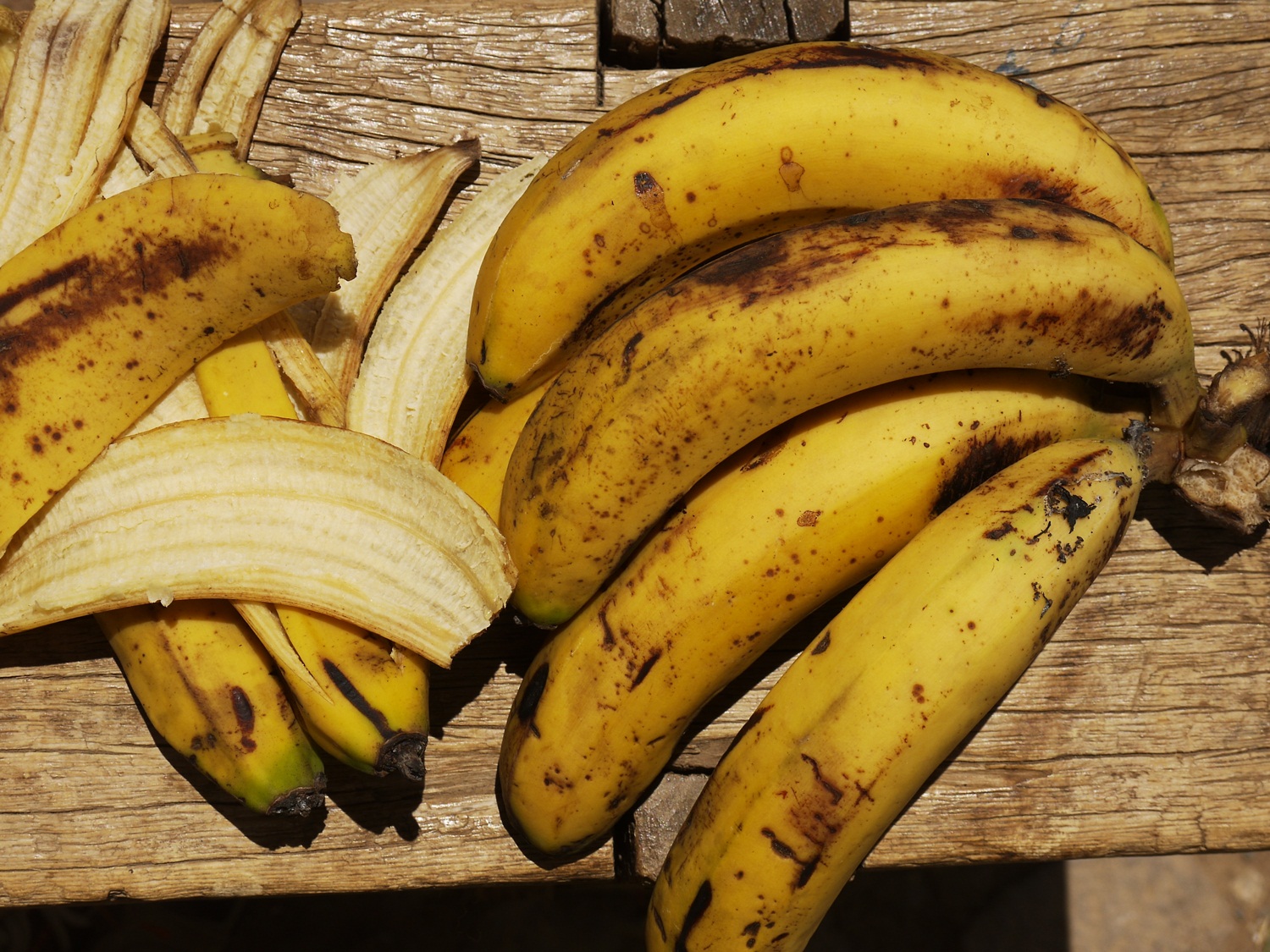
And our first impressions of bananas – the crucial staple food of cyclists – they’re cheap, really cheap. In Escoma, 4 bananas costs us 1 Boliviano…in sterling, that’s 44 bananas for £1!
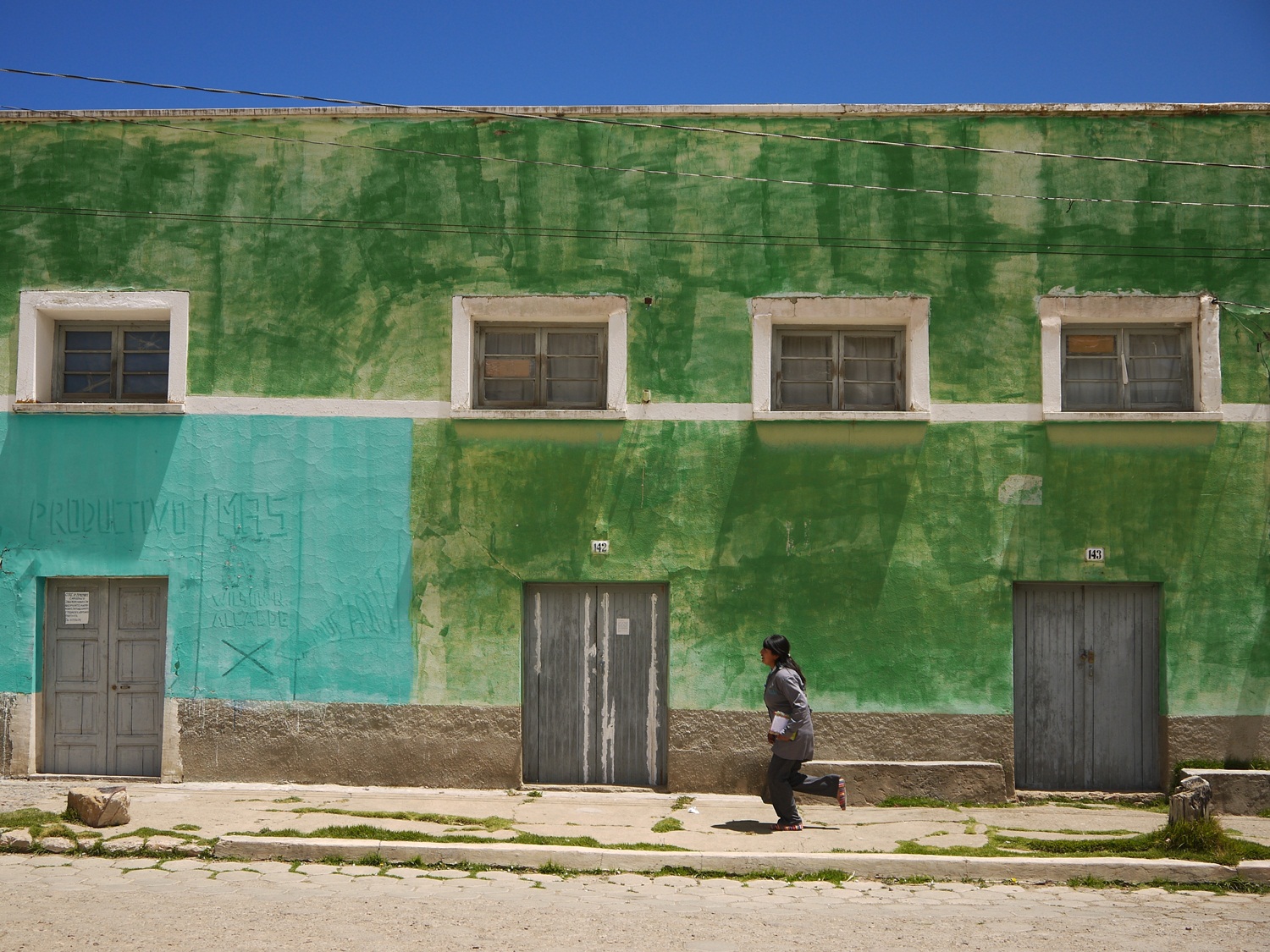
We continue to follow the lake on the Bolivian side, through peaceful villages where running is a rarity…
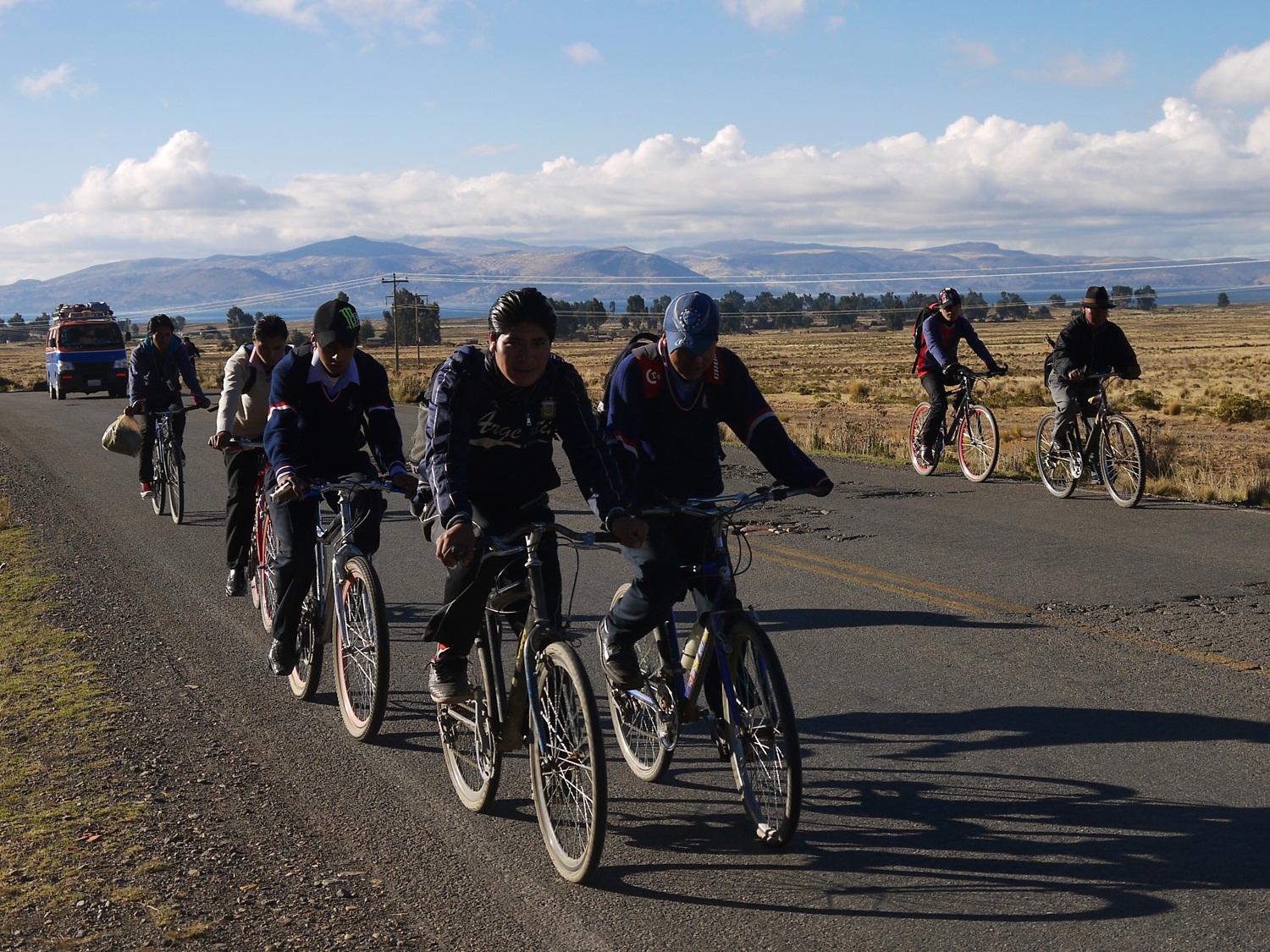
…on to Ancoraimes, now truly on the altiplano, where bicycles are the most common form of transport. We get swallowed up in the school commute.
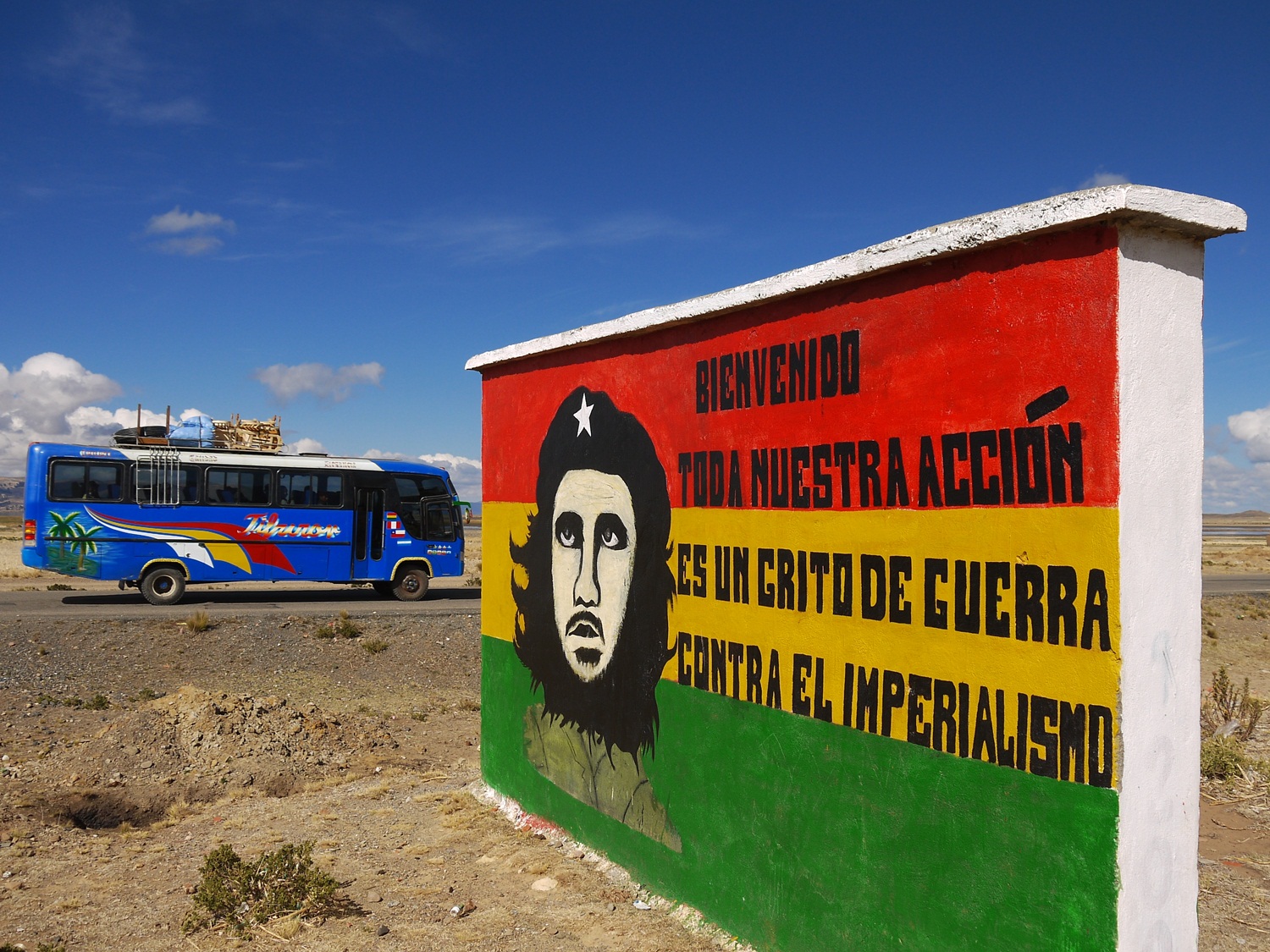
Ché propoganda reappears reminding us of our month in Cuba, nearly two years ago. His final guerilla campaign took place in Bolivia before he was captured and shot by the Bolivian army and CIA at Villagrande; his iconic face can be found everywhere here.
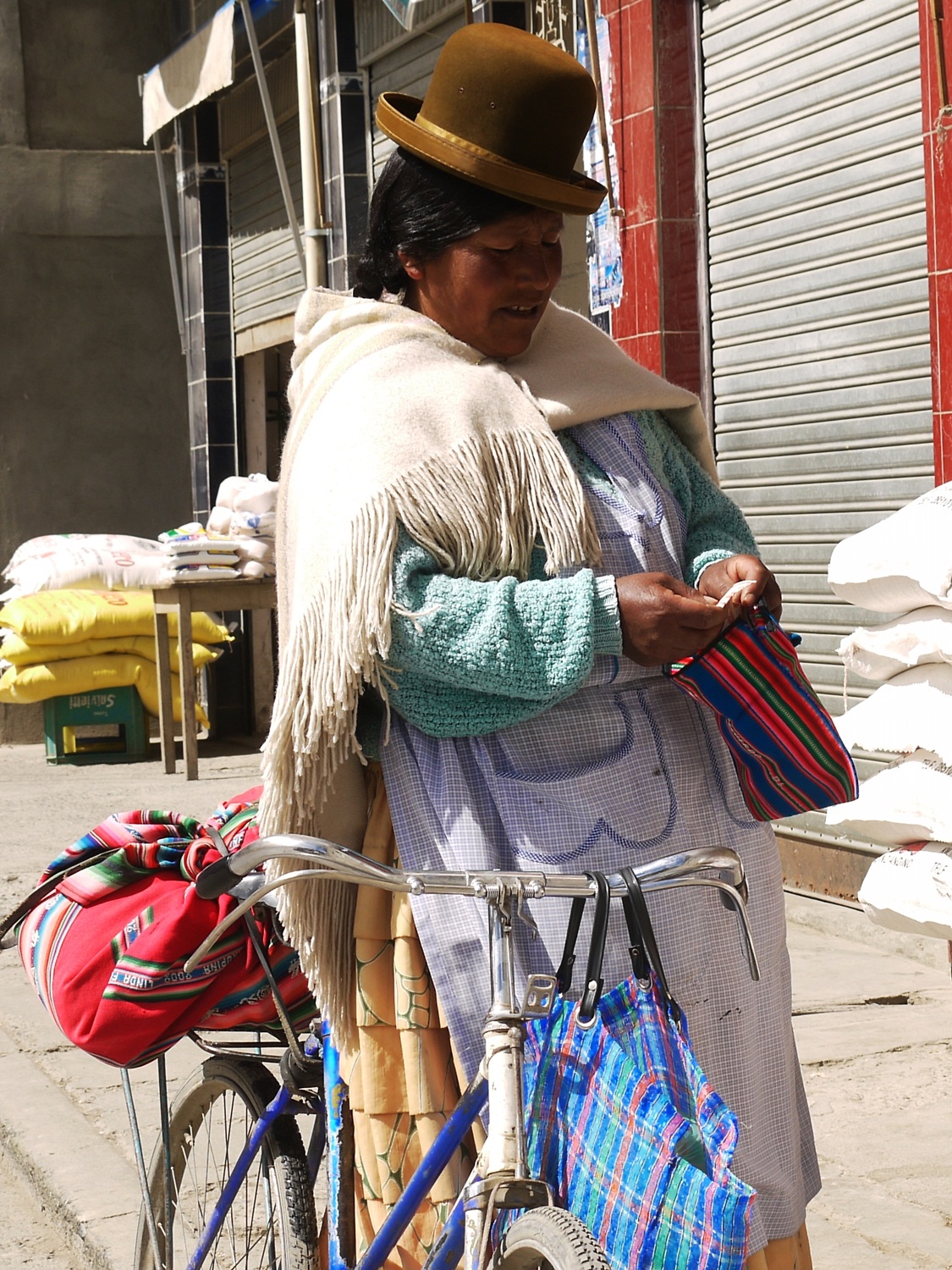
…and encounter more locals who opt for cycle transport. This cholita with trademark bowler hat balanced precariously and pleated skirt flowing, does her shopping by bike.
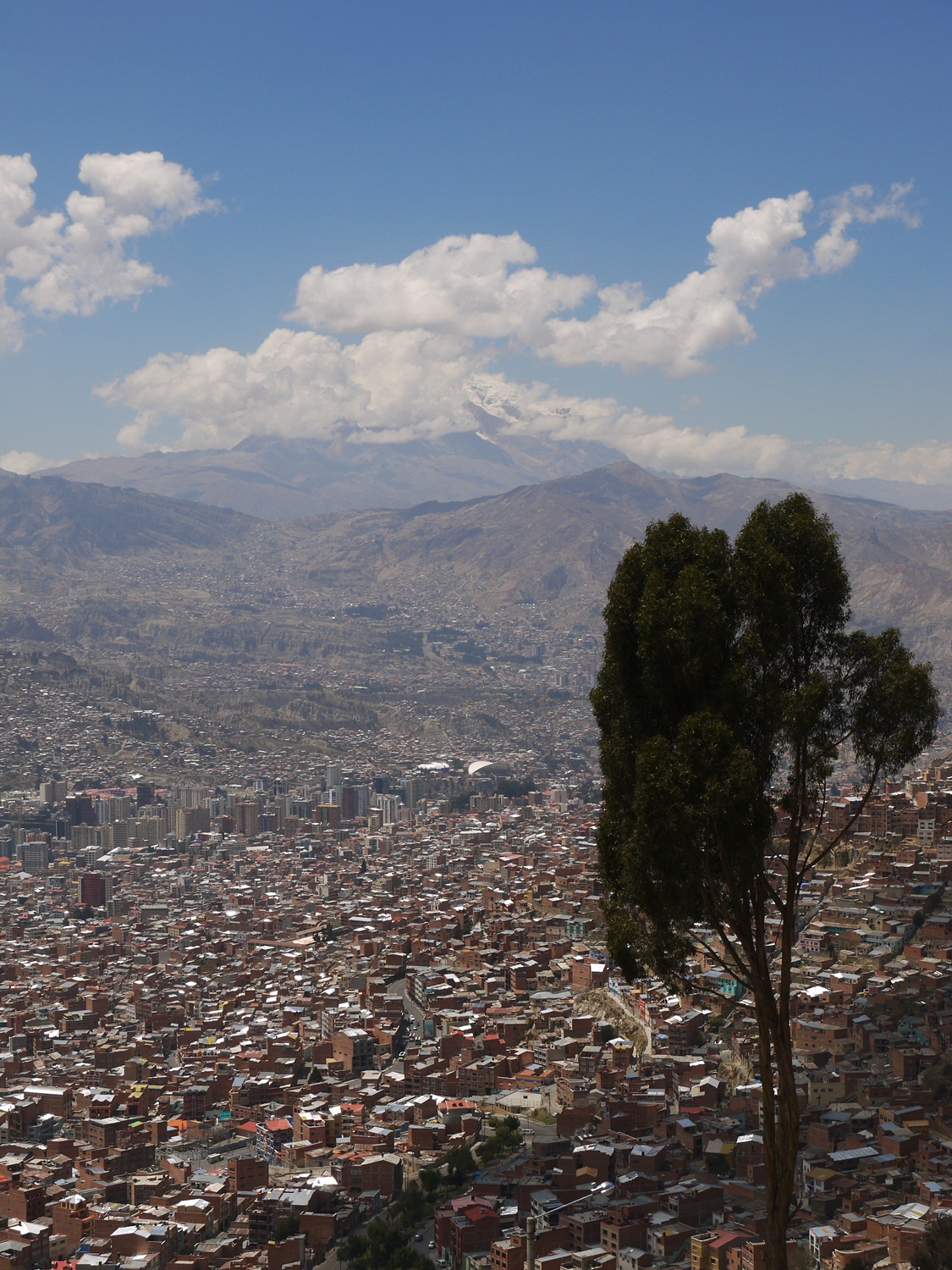
We make it to El Alto (the city above La Paz) in no time, practically free-wheeling along the pancake-flat altiplano. At the border between El Alto and La Paz known as La Ceja (“The Eyebrow”) we are treated to an unforgettable first view of the city with the snow capped peak of Illimani in the background. Time for a few days off to gather ourselves before we head back out onto the altiplano…
Route notes:
We followed the excellent information on Bicycle Nomad and from Harriet and Neil on the Andes by Bike blogs – here are a few additions and updates:
Lampa (35km NW of Juliaca on the secondary routes to and from Cusco) is undoubtedly a more pleasant base than Juliaca for the immigration trip to Puno. It’s 1½ hours each way in combi from Lampa – Puno with a change in Juliaca.
Peruvian immigration:
In Puno we were given our Peru exit stamp dated for that day. According to the immigration agreements between Peru and Bolivia, we were then told that we had to present ourselves to Bolivian immigration within 7 days. This was plenty of time to get to Puerto Acosta, even with our Capachica Peninsula detour.
Capachica Peninsula:
To access Capachica, ask in Juliaca for the road to Coata. The most spectacular section of the loop was the cliff-top ride from Chillora to Escallani on the eastern side, en-route to the main Juliaca-Huancané road at Taraco.
To take the coastal road from Moho (highly recommended), ask for the paved road to Tilani via Conima (38km total Moho-Tilali). Leaving Tilali, you pass through a final police checkpoint, and then climb up to the border line by the smugglers’ market. From here it’s a rough climb and descent into P.Acosta (18km total Tilali-P.Acosta).
Bolivian Immigration:
We were given a 30 day tourist visa in P.Acosta. We tried to get this extended to 90 days (apparently this is easy at more major crossings), but were told we had to go to La Paz to do this – which we did, free of charge and with no hassle.
Our total distance from Lampa-La Paz was 502km (it would have been 386km without the Capachica detour), and took us 6 days riding.
A Peruvian A-Z
October 10th, 2013
Ah, Peru. How we loved you, and – just occasionally – how we loved to moan about you. Peru will stick in the memory as a real montaña rusa (rollercoaster) of a country, giving us some of our biggest highs – both literal and metaphorical – as well as some of our most grumpy lows of the trip so far.
In riding terms, it will be hard to beat this country for the sheer variety of its incredible landscapes. Peru has it all, often compressed into a single day’s ride: the lush gorges and hilltop fortresses of Chachapoyas; the arid, Star Wars-esque canyons of Cajamarca; the starkly beautiful altiplano and lakes of Junín and Titicaca; and of course the snow-capped peaks of the Cordillera Blanca. And we didn’t even scratch the surface of this enormous country – by sticking stubbornly to the central ranges of the Andes we bypassed the Peruvian Amazon, the pre-Incan ruins of the coast, and the deep canyons and high volcanoes of Arequipa. If you like to go slow like we do, then even four months on a bike in Peru will leave you feeling like you’ve missed out.
But if Peru was at the front of the queue on the day when the natural spoils of South America were awarded, then there were times when we couldn’t help thinking it was stuck at the back (or maybe just didn’t bother turning up) when the personal charm and warmth were handed out. It’s not that we didn’t meet friendly, hospitable people. As always, away from the main roads and tourist honey pots and out on the back roads of the campo, we were grateful to the many Peruvians who helped us on our way with gifts of food, drink or a spot to camp for the night.
Yet there was still something missing: that magical human element, so hard to put your finger on, but which has been at the heart of some of our best experiences of the trip so far. Call us spoilt, but in Peru we missed that irresistible Latin American lust for life that we had come to love from some of our favourite countries so far. The spontaneous roadside encounters that send you on your way with a grin on your face. The random chats with curious old men about everything from left-wing politics to this year’s potato harvest, via The Beatles and Mr Bean. That sense that however bad things get, the best way to deal with it is to laugh, joke and dance your cares away with closely-knit family and friends. We’d grown used to life in Latin America being lived in full colour, but at times in Peru it felt like someone had flicked the switch into shades of grey.
It’s always telling to hear how people describe their own countries to you. In Colombia, a country where the last 50 years of civil war have left an estimated 220,000 people dead and up to 5.5 million displaced, people still never tired of telling us how blessed they were to be living in “paradise”. In Ecuador, people proudly told us of the steps forward their country has taken in the last few years under the leadership of President Rafael Correa. And in Peru? “Watch out for the ratones“, they told us over and over again: “This country is full of thieves.”
And to be honest, you can hardly blame them. Of all the countries in Latin America, Peru’s mineral wealth has meant that it has perhaps suffered most from foreign pillaging – firstly at the brutal hands of the conquistadores, and then more recently at the more airbrushed (but ultimately no less brutal) hands of foreign mining companies. Peru is one of the world’s richest countries in terms of natural resources, but of course the average Peruvian sees none of this wealth. After centuries of exploitation, life here remains undeniably tough. It’s no surprise then that most Peruvians are ambiguous at best about the most recent influx of foreign invaders, this time clutching digital cameras and sporting matching “I’ve been to Machu Picchu” hats. Tourism might have become a mainstay of the economy, but that doesn’t mean Peruvians are about to start receiving us with hugs and kisses.
Nevertheless, our four months in Peru will undoubtedly go down as some of the most memorable of our trip. Peru made our knees go weak with its climbs, our fists clench from time to time with its very un-Latin American miserablism, and our jaws regularly hit the floor at its amazing landscapes. Summing it all up is pretty much impossible, so in the spirit of our Mexico A-Z, here are some of our most memorable Peruvian moments in (sometimes highly dubious) alphabetical order.
James
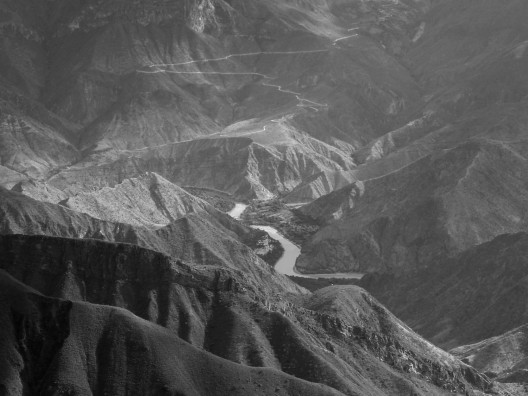
Andes. For us, Peru was all about the Andes – and this was the moment we knew that we had arrived: gazing down at our 60km, almost three vertical kilometre descent to Balsas and the next day’s 45km climb to Celendín. After a while, spending two days climbing a mountain followed by two hours freewheeling down the other side became quite normal…
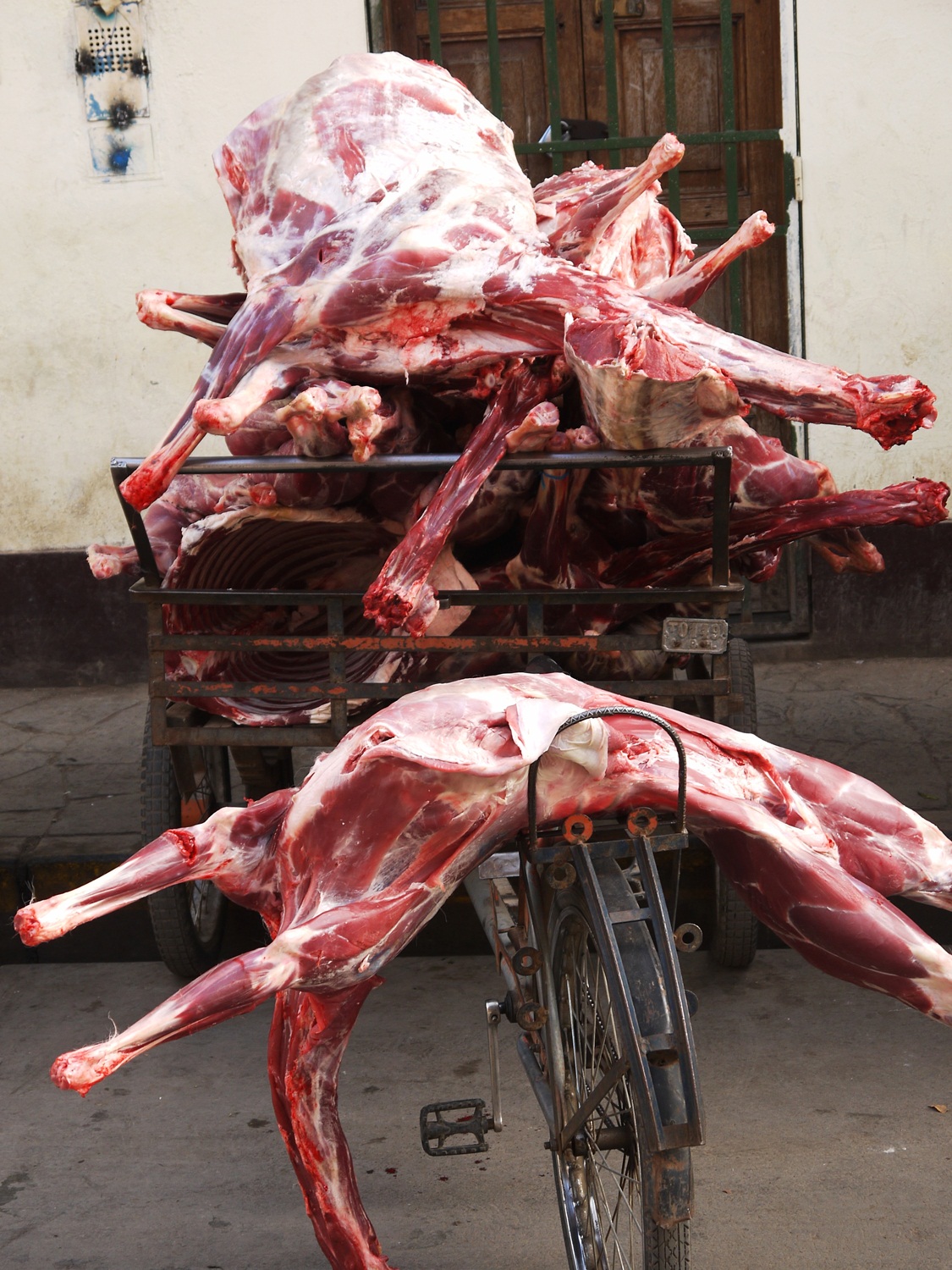
Butchers Bike. Markets are always the first place we head for in a new town, and Peru had some of the best we had seen since Mexico. Hang around the entrance and you’ll find the true bike heroes of Latin America, transporting everything from mountains of mandarins to a pile of freshly slaughtered goats by pedal power.
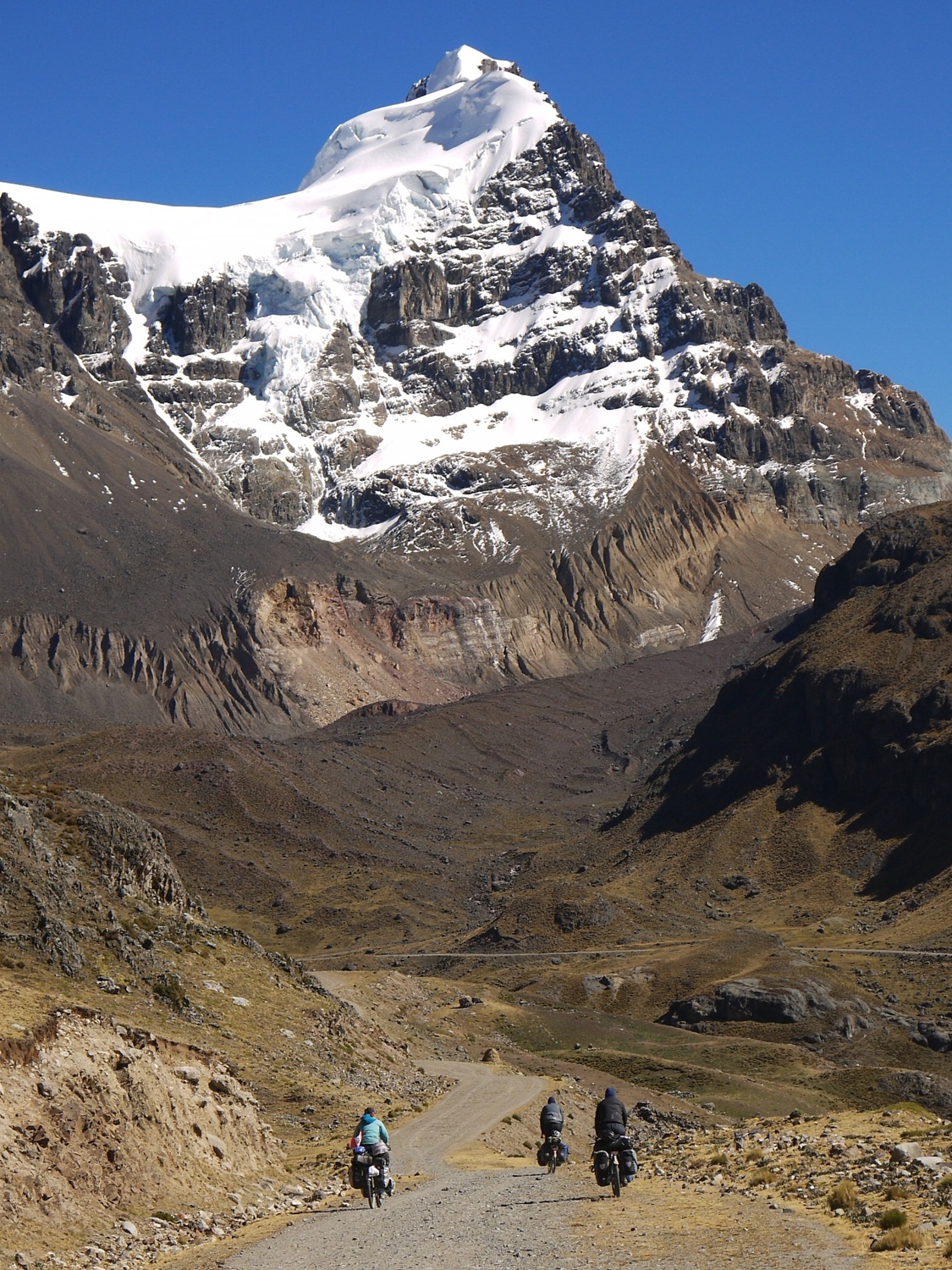
Cordillera Blanca. If we’re honest, then this was what we were really waiting for in Peru – and we weren’t disappointed. Our loop around Punta Olímpica and the Portachuelo de Llanganuco went straight into our top five rides of the trip so far and to the top of our list of places to return.
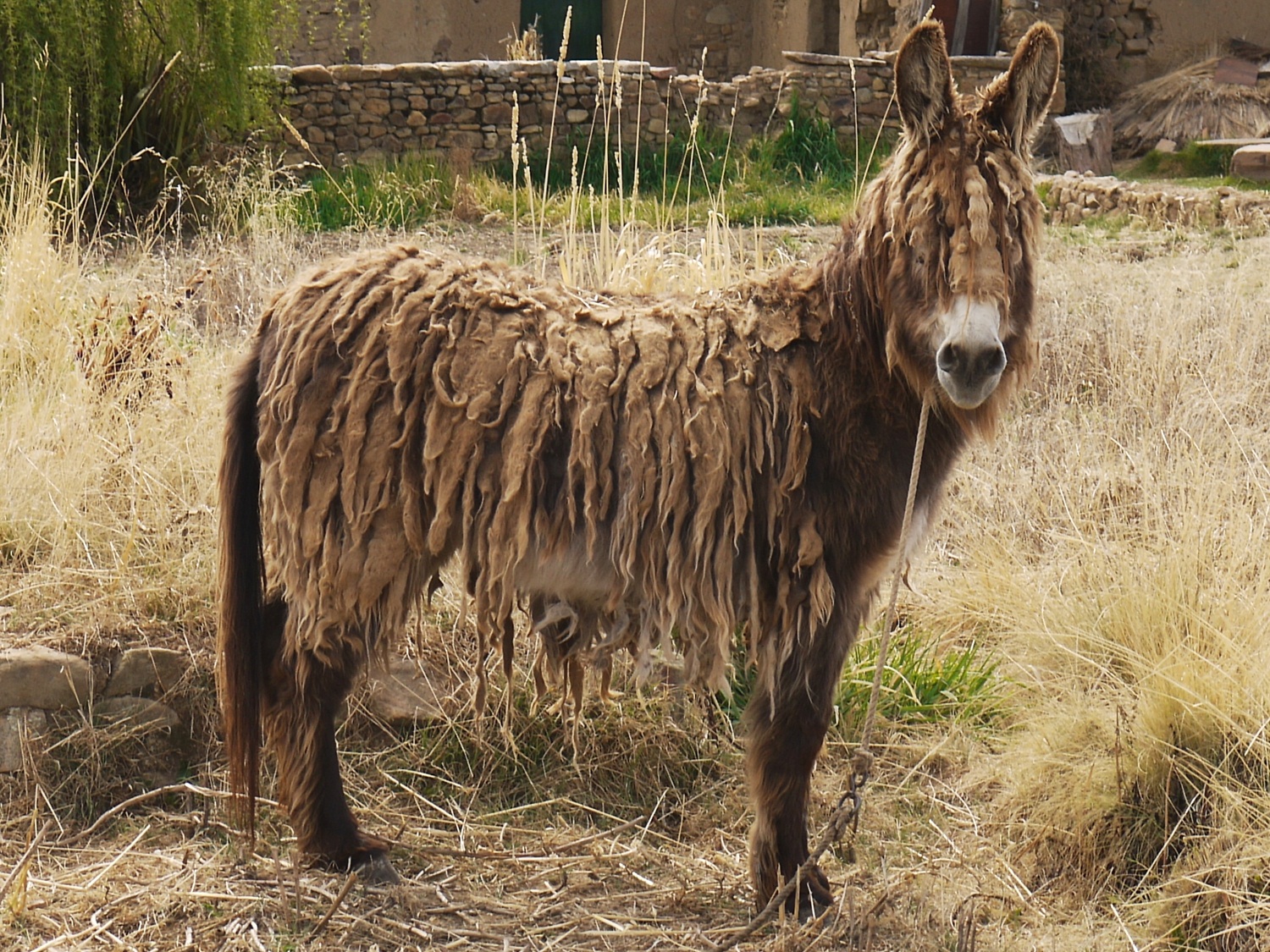
Dreadlocked. We might have been far from the Caribbean, but dreds are all the rage amongst the farm animals of rural Peru. Most were dogs, but this donkey was a show-stopper.
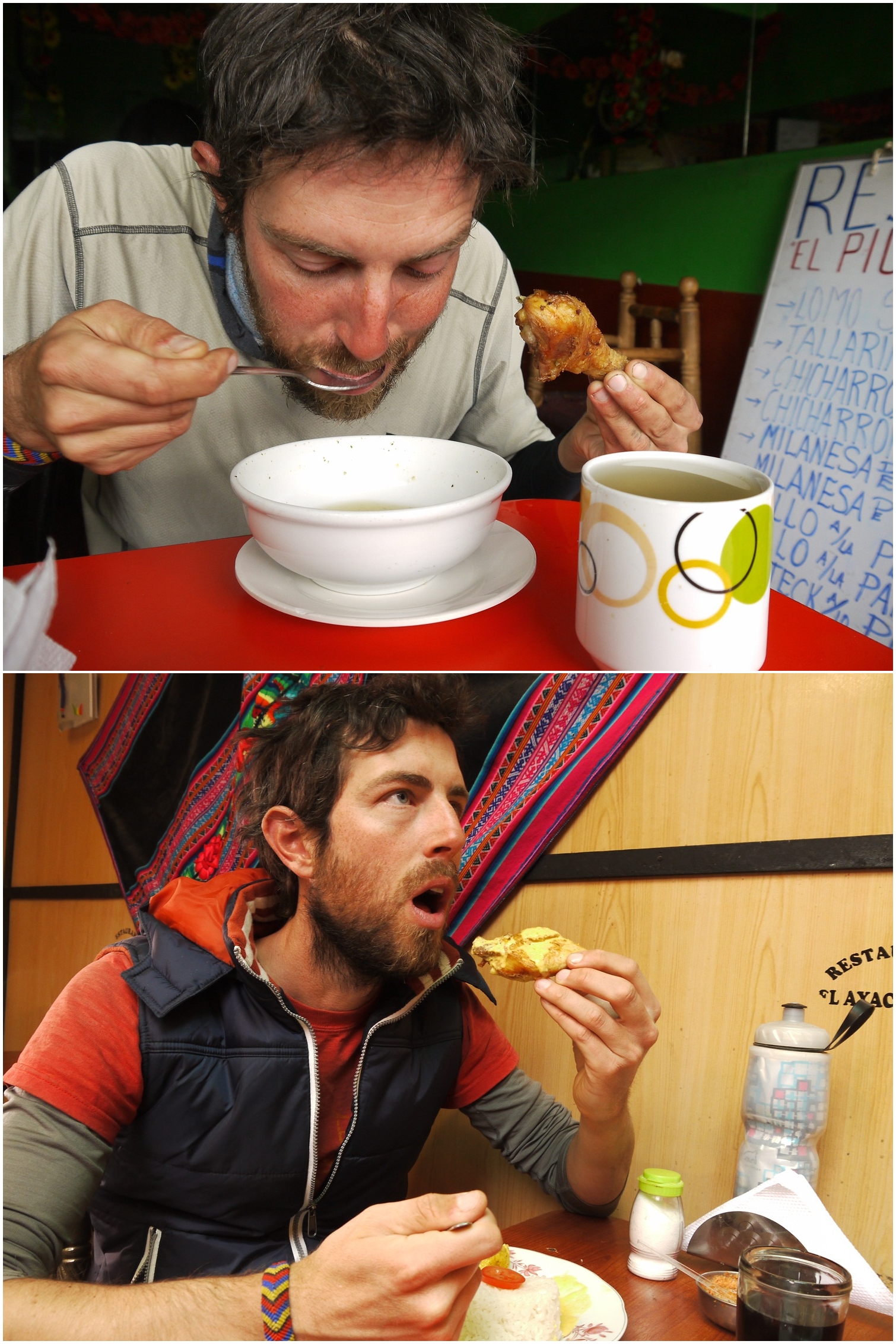
Eating etiquette. We quickly learnt that mealtimes in Peru have a strict etiquette. Step 1: Soup. Crouch low over bowl and spoon it in as quickly as possible. Step 2: Main dish. Maintaining piece of chicken in one hand, stare vacantly at large screen TV (ensure volume at maximum) while shovelling in rice. Note: Avoid eye contact with other patrons at all times, and never betray any pleasure in the process of eating.
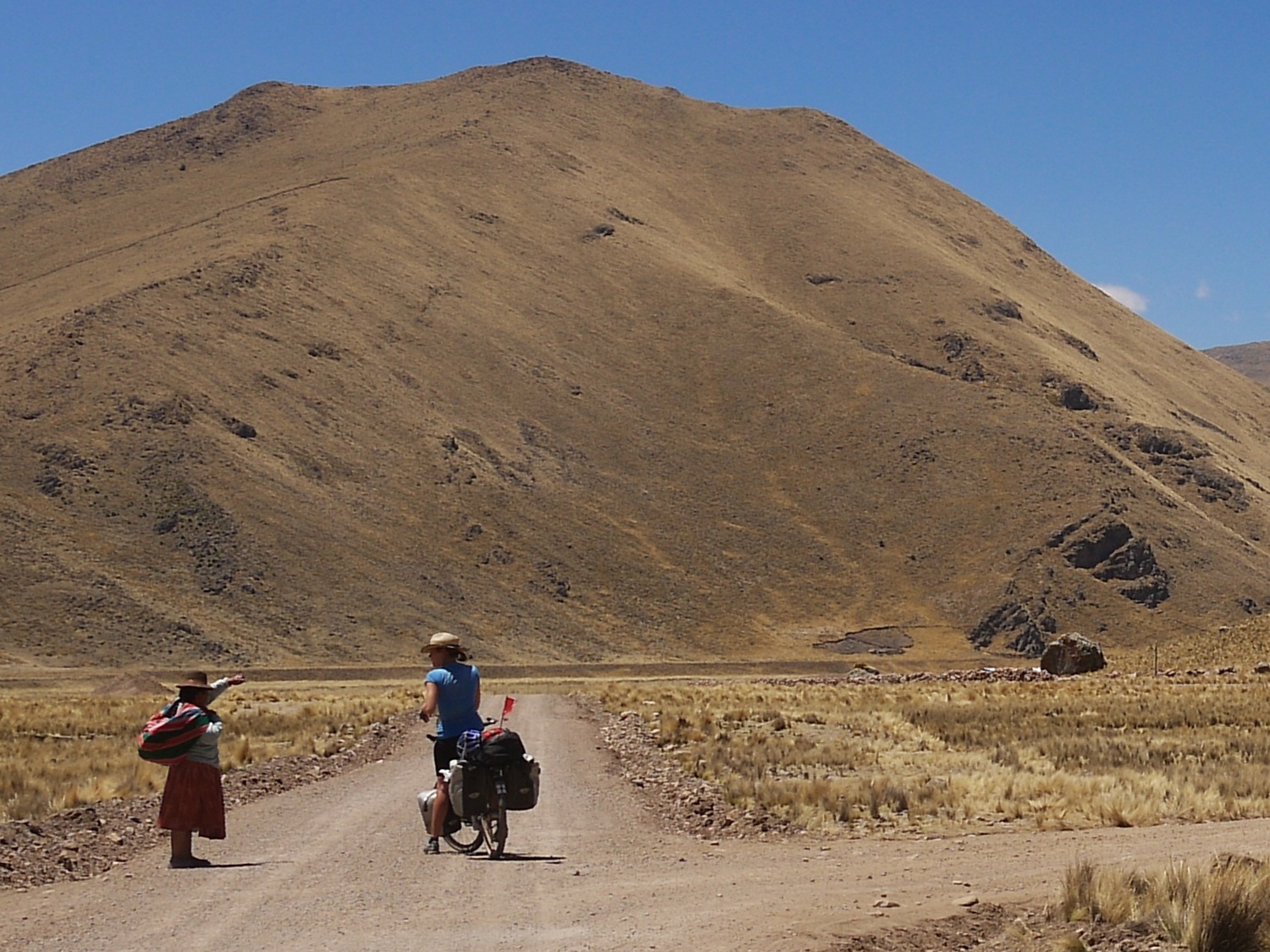
“De Freeeeeente!” It didn’t seem to matter where we were heading in Peru, the directions were always the same. “De Frente!” (“Straight ahead!”) they would say – even when we were standing at a junction with our only options being to turn left or right. No wonder it took us four months to get across Peru…
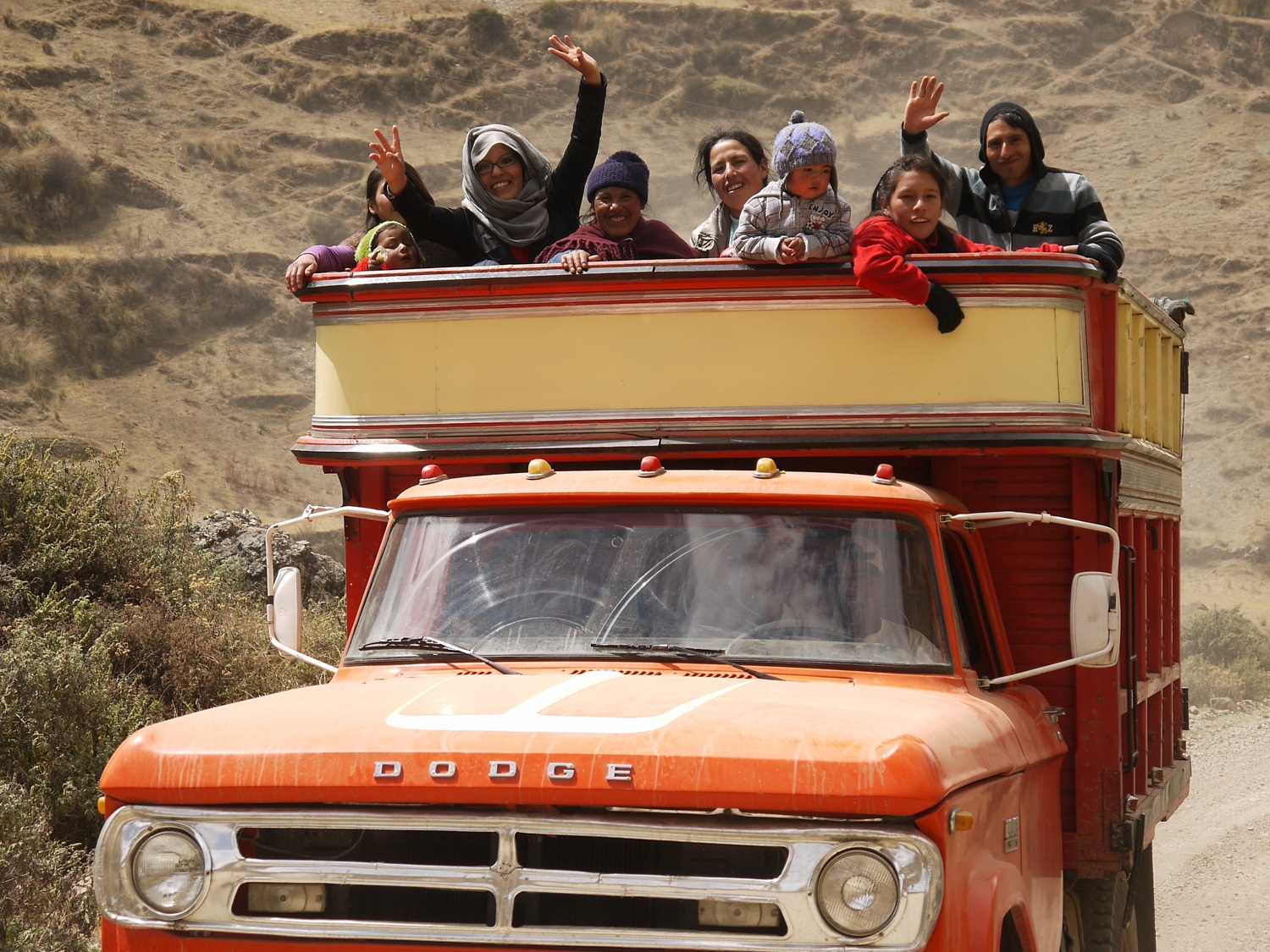
“Griiiiiiiingo!” Forget Andean music, this was the real soundtrack to Peru, shouted from the roadside and from passing cars wherever we went, accompanied by giggles and hoots of laughter once we were safely past. Cyclists – especially Europeans – tend to get their knickers in a twist about it, but resistence is useless: in Peru, if you’re not Peruvian, then you’re a gringo. It might not win them any prizes for geographical knowledge, but at least it was usually accompanied by smiles and waves.
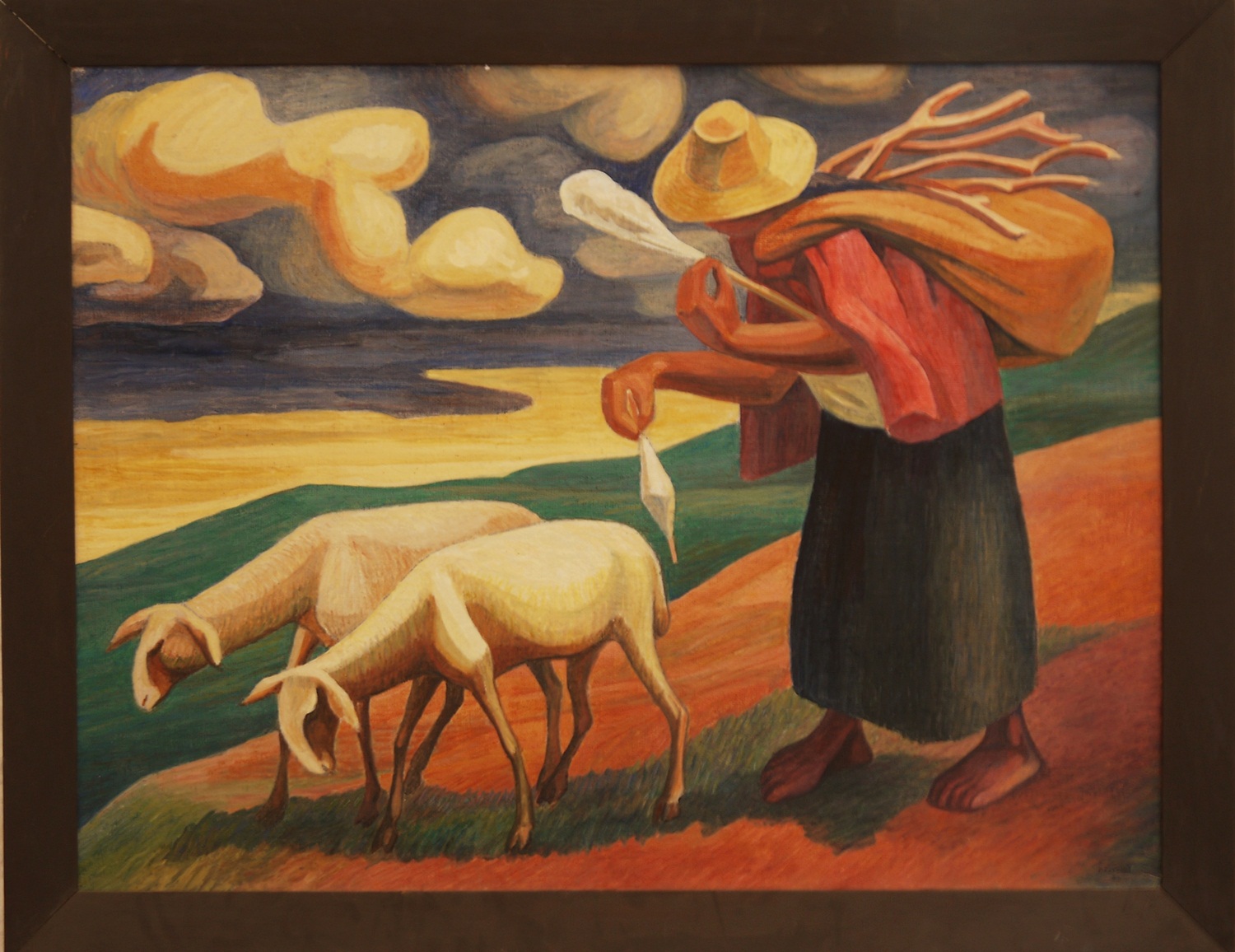
Hunched abuelitas. For some people, it’s the stray dogs in Peru that break their heart. For us, it was the abuelitas (old ladies) that we wanted to scoop up and take home: toothless, bent double under an enormous bundle of firewood, leading a flock of sheep, cattle, llamas and pigs home for the night and spinning wool as they go. This is rural, highland Peru – a life of harsh poverty and little opportunity, unchanged for hundreds of years.

Inescapable. “Just wait for Peru”, people told us when we moaned about the lack of food flavour ever since Mexico. “It’s the culinary capital of South America”. And what did we find? Chicken. Everywhere – for breakfast, lunch and dinner. To be fair, in between the chicken, there were a few food highlights, but in general Peru failed to break the “filling but bland” Latin-American mould, and was something of a food anti-climax.
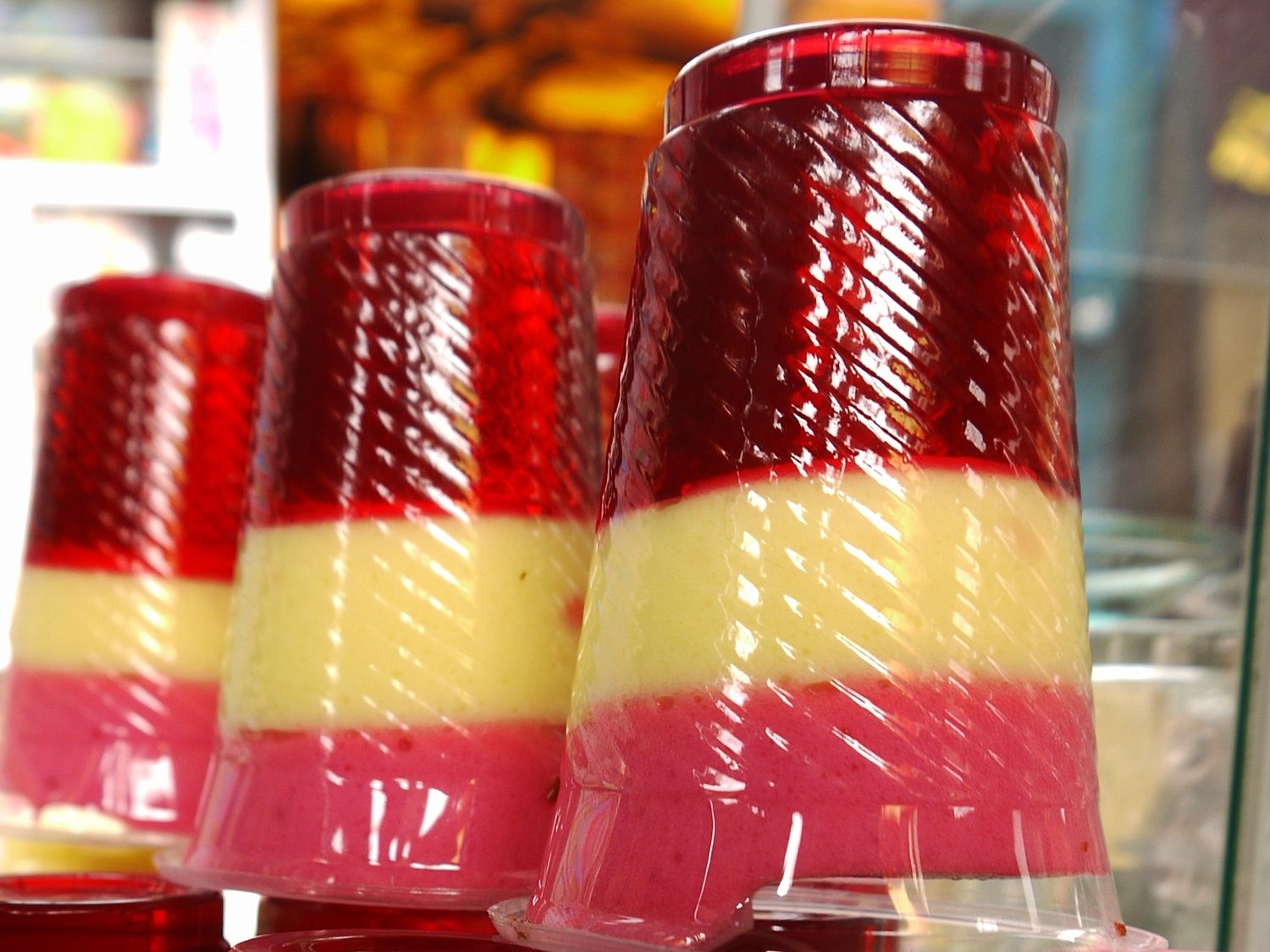
Jelly. And the ubiquitous Peruvian sweetner to follow the chicken? Jelly, of course. We never quite worked out why: was it just that Peruvians never grew out of the kids’ birthday party habit? Or was it the general lack of teeth in the Peruvian population that made it such a food favourite? Either way…
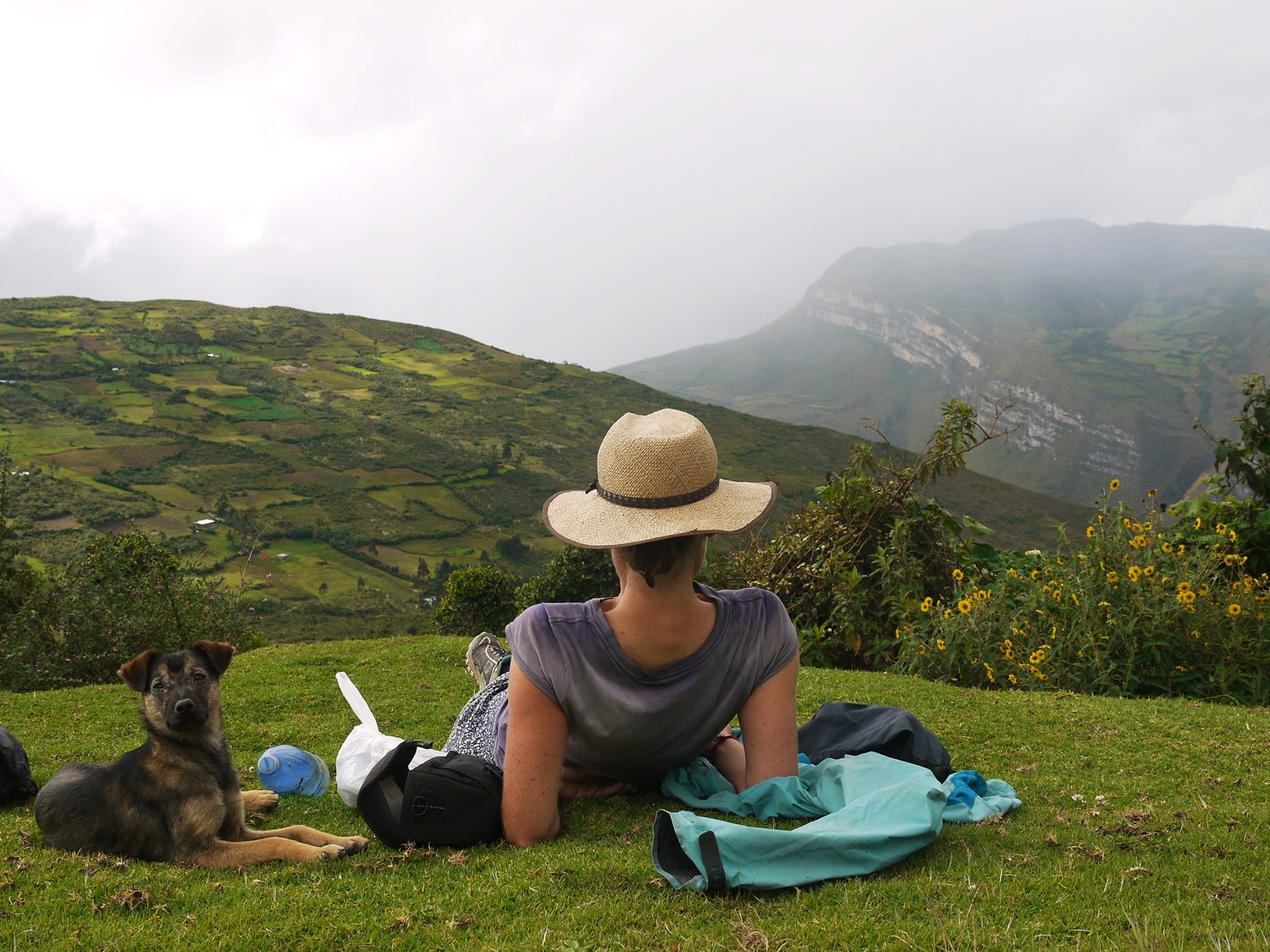
Kuelap. Away from the crowds and manicured lawns of Machu Picchu and the Sacred Valley, this was our favourite ruin in one of our favourte parts of Peru – the misty valleys of Chachapoyas, in the north. Abandoned to nature, and with an incredible 360 degree view into the valleys below, you really could imagine back to when this was a pre-Incan hilltop fortress.
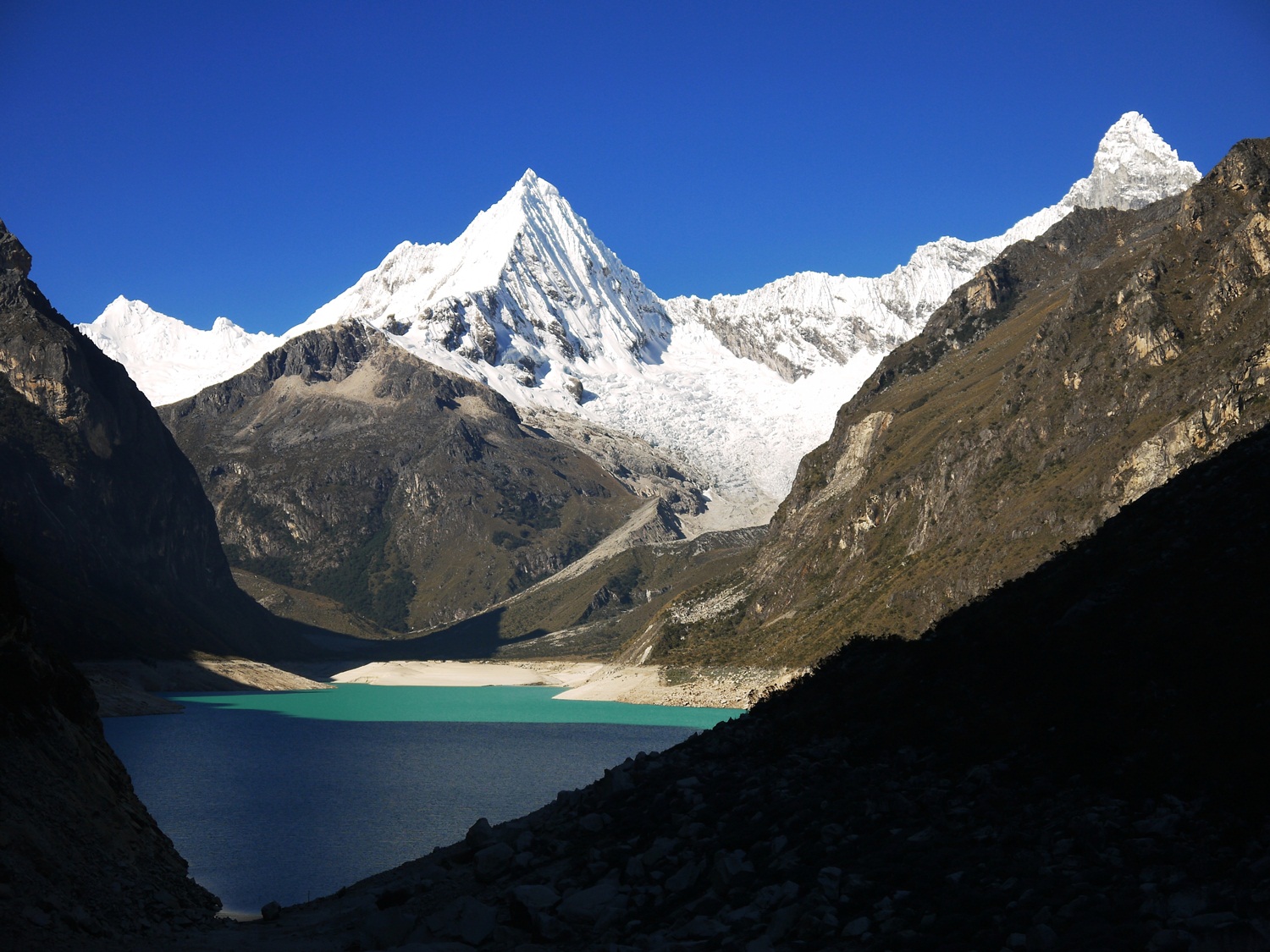
Lakes. Peru had an incredible variety of lakes of all sizes and types: from the icy turquoise of Laguna Parón in the Cordillera Blanca…
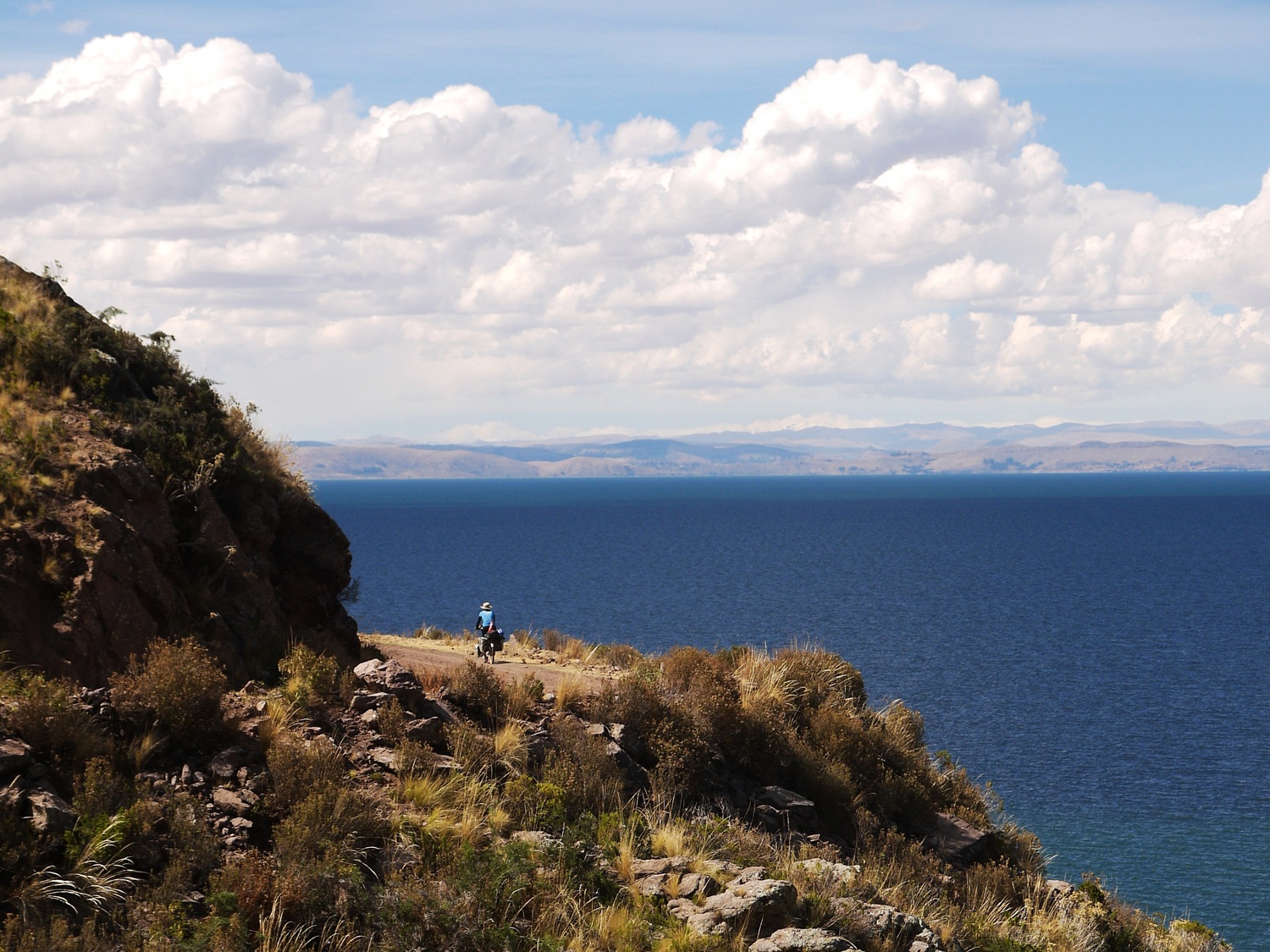
…to the slightly warmer blues of Lago Titicaca on the southern altiplano – where at times you could almost forget you were four vertical kilometres above sea level, and convince yourself you were actually pedalling along the shores of the Mediterranean.

Menú. Bland it may have often been, but for calories-for-cash value it was hard to turn down the Peruvian menú: a lunch of soup, a mountain of rice, chicken (of course) and a drink for less than US$2. Breakfast, on the other hand, was easy to pass by – faced with a choice like this between “cow’s head soup” or “cow’s hoof soup”, even our increasingly tedious breakfast porridge routine suddenly became appetising once again…
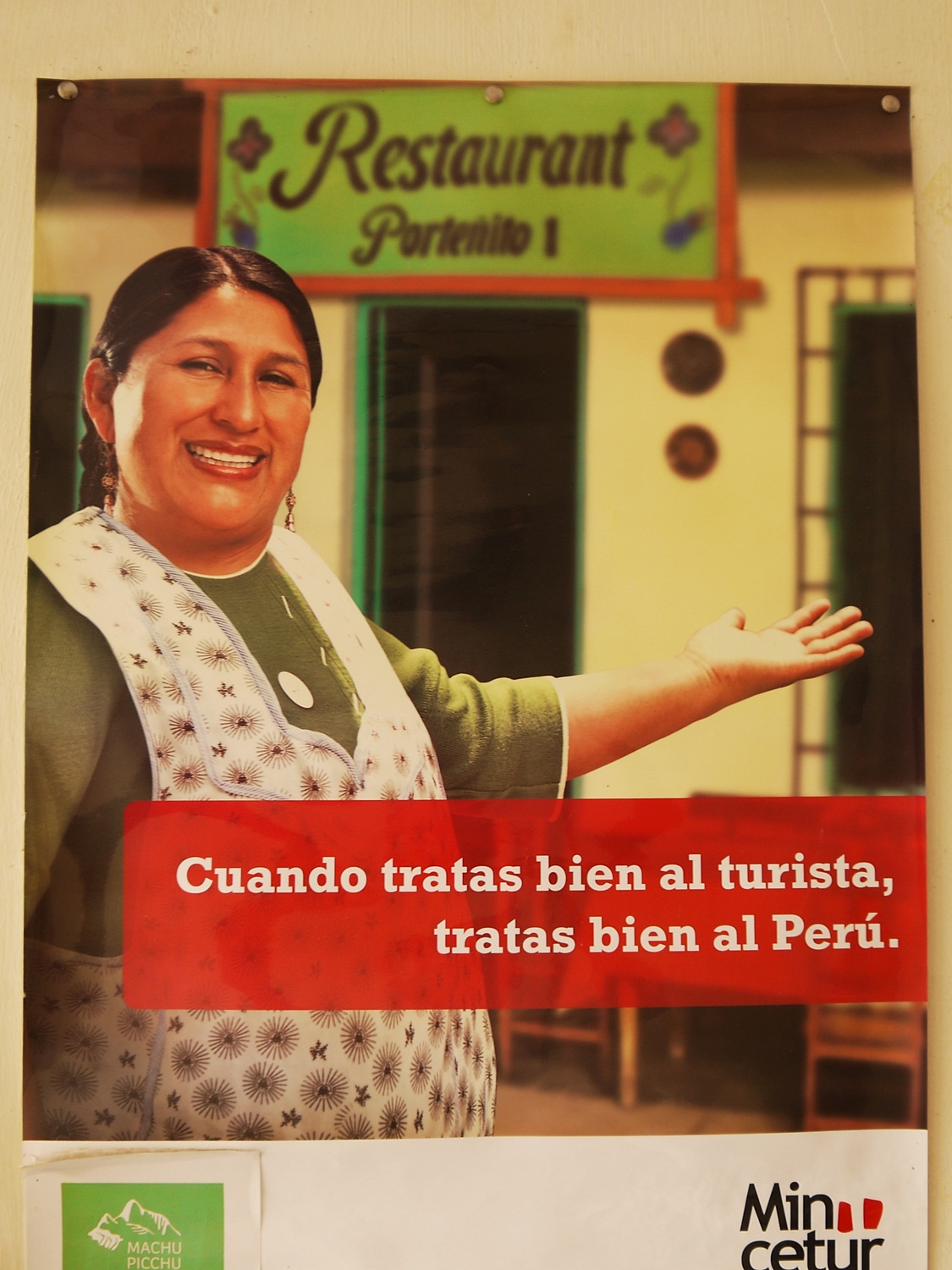
“No hay!” While we met plenty of smiling, friendly people in Peru, “No hay!” (“We haven’t got any!”) was its counterpoint – barked moodily from behind shop counters and hotel receptions. This was definitely the first place in Latin America where we’d seen a government campaign like this one having to remind people that “when you treat a tourist well, you’re treating Peru well.”

Oro. “Yes to water, no to gold!” – so say the residents of Cajamarca, where a massive new mining project threatens to pollute their precious water supply. Since the time of the Spanish conquest, mining has been a topic of furious debate in Peru – it might bring in much-needed foreign investment, but continues to leave behind massive environmental and social problems for local people.
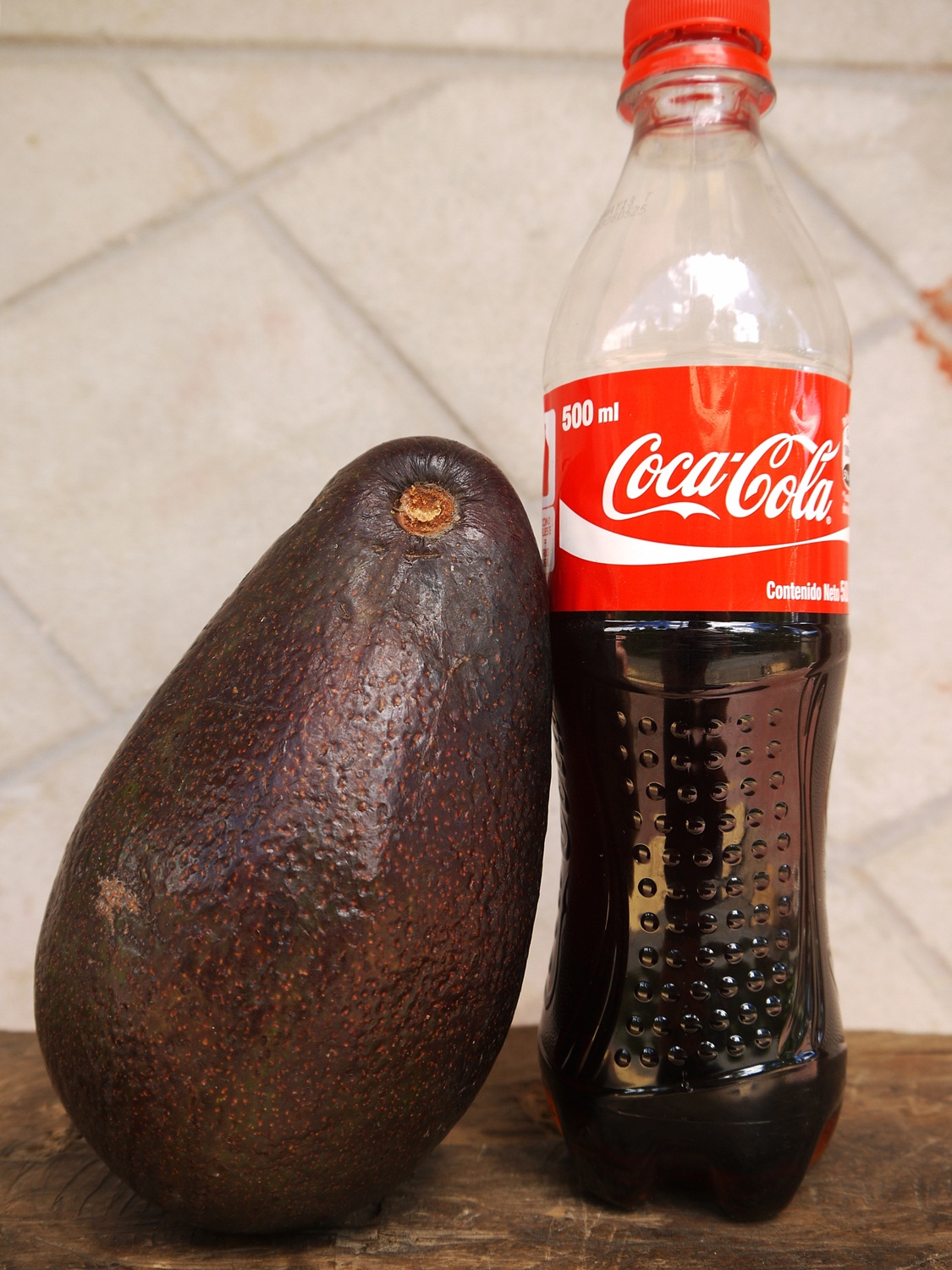
Palta. For the days when we couldn’t face menú just before an all-afternoon climb, there was always palta (avocado) – and Peru had some of the best we’ve eaten on the whole trip. This really is a food of the gods – rich, filling and full of healthy fats. I’m just not sure we will ever re-adjust to the expensive, hard golf balls that pass for avocados at home…
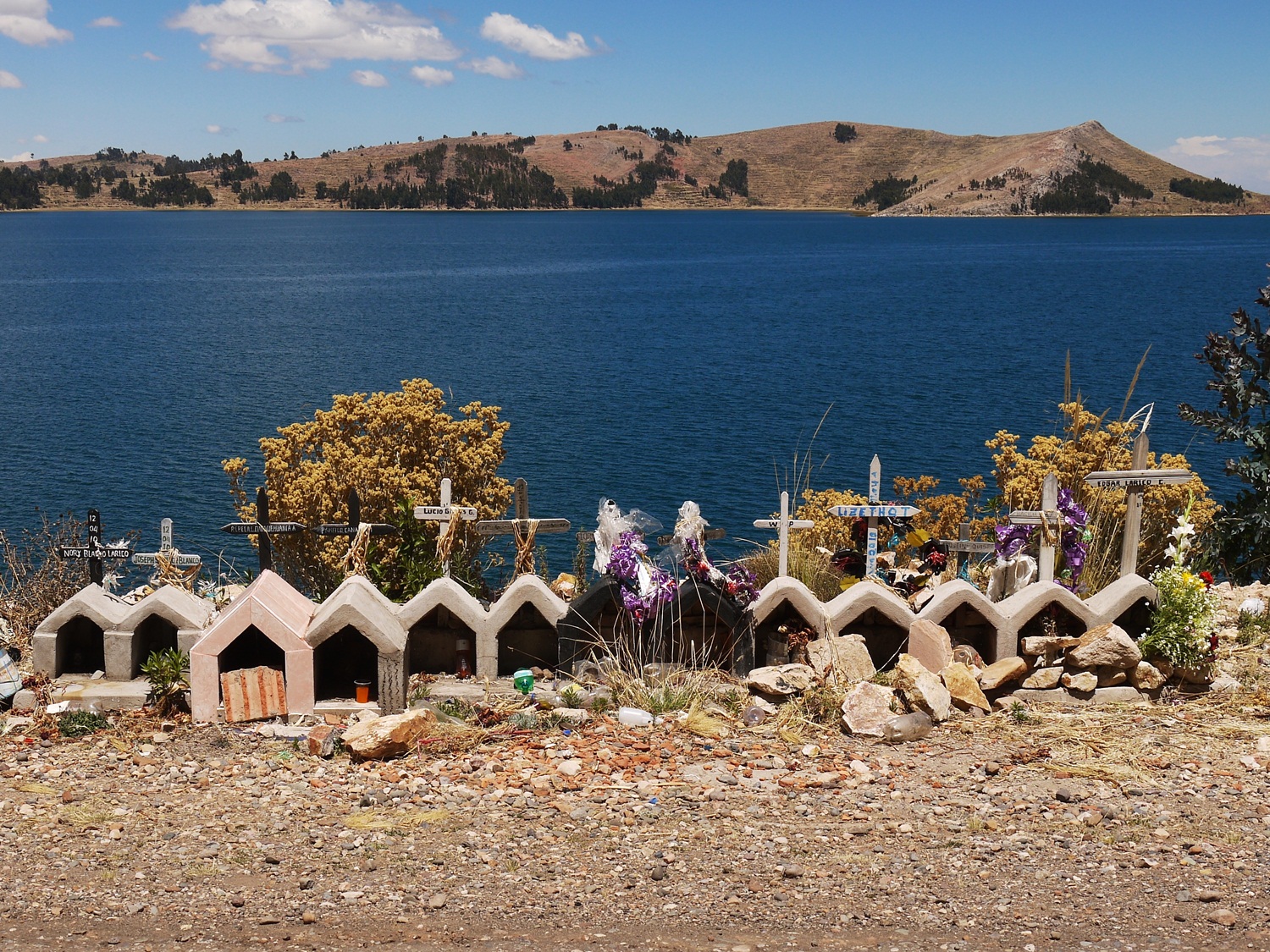
Que en paz descanse (“RIP”). “I ride with Jesus, and if I don’t come back I’ve gone with him”, say the window stickers on Peruvian minibuses, in one stroke absolving their drivers of any responsibility for their driving. If they were more honest, they should probably read: “I drive like a cretin, and if I don’t come back it’s probably because I’ve driven myself and my passengers off the edge of a cliff while overtaking on a blind bend at 100km/h.” Peruvians’ erratic driving may have brought on the red mist every time we misguidedly ventured onto a main road, but more than that it made us incredibly sad to see so many Peruvians needlessly killing each other.
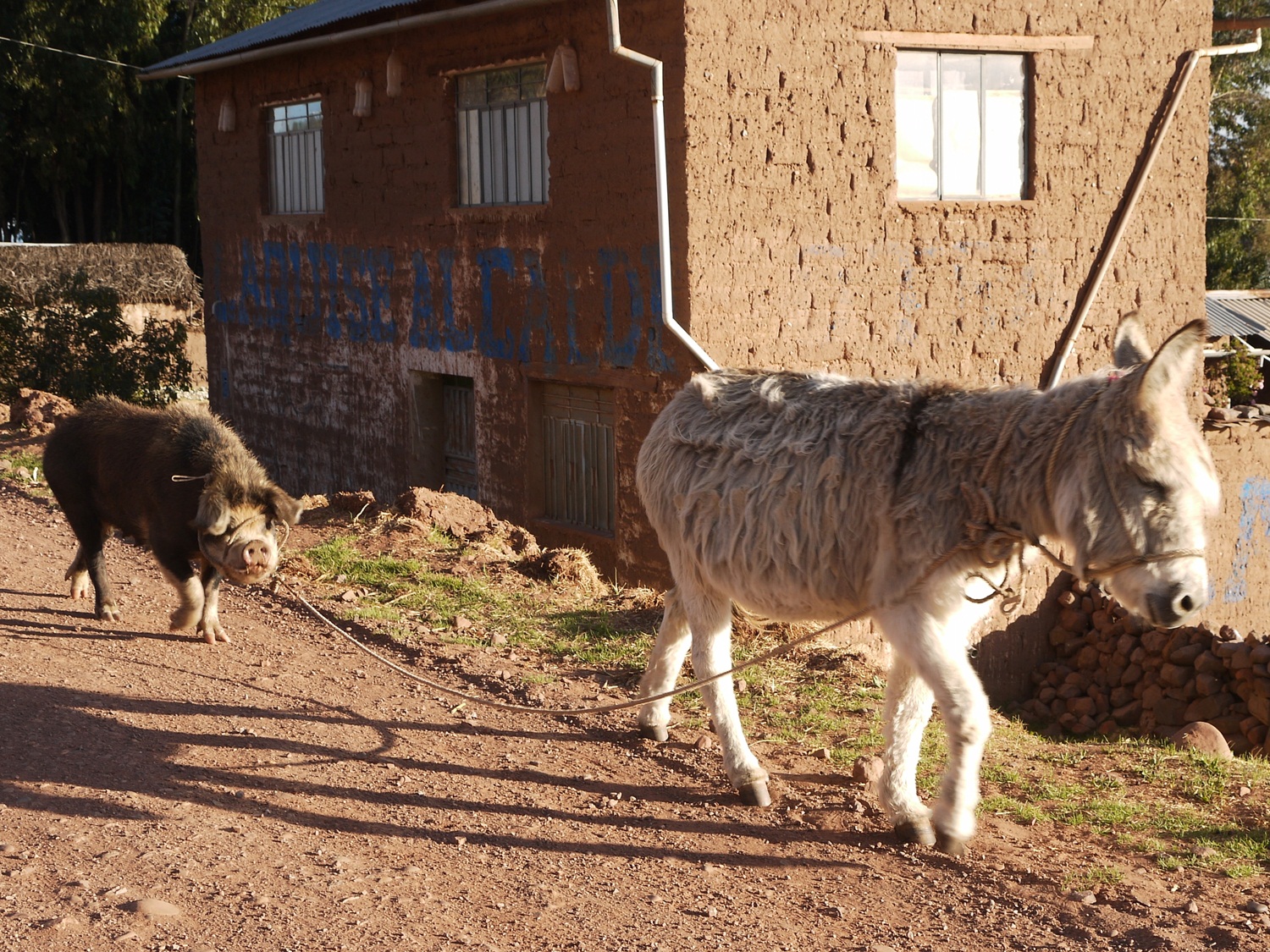
Rush hour. Away from the blaring horns and slalom course of the main roads, rush hour on the Peruvian back roads was of a more sedate kind, as people led enormous mixed groups of llamas, alpacas, sheep and pigs back from the fields for the day. This was undoubtedly my favourite Peruvian “long vehicle”: a donkey leading a pig home for the night as if it was the most natural thing in the world, its owner nowhere to be seen.
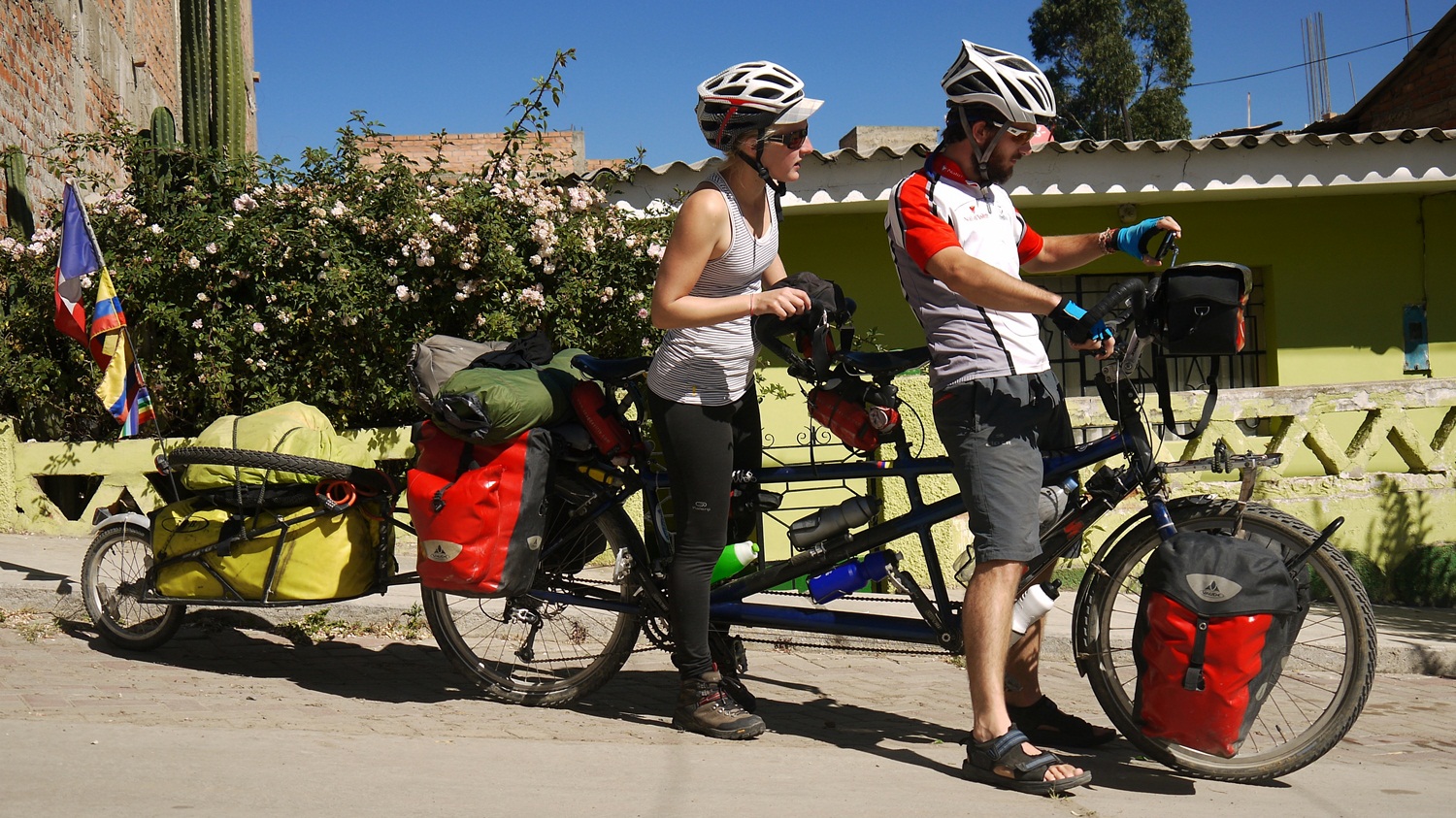
Sociable. Our ride through Peru coincided with the peak season for cyclists heading south, making it a sociable place to catch up with new and old friends from the road – focused of course on eating and drinking: trufa munching with the French tandem duo Artur and Caro; more caffeine hunting with our friend Anna; polishing off our Dairy Milk supply with the Genners; and Spanish tortilla making with Salva and his girlfriend Lorelí.
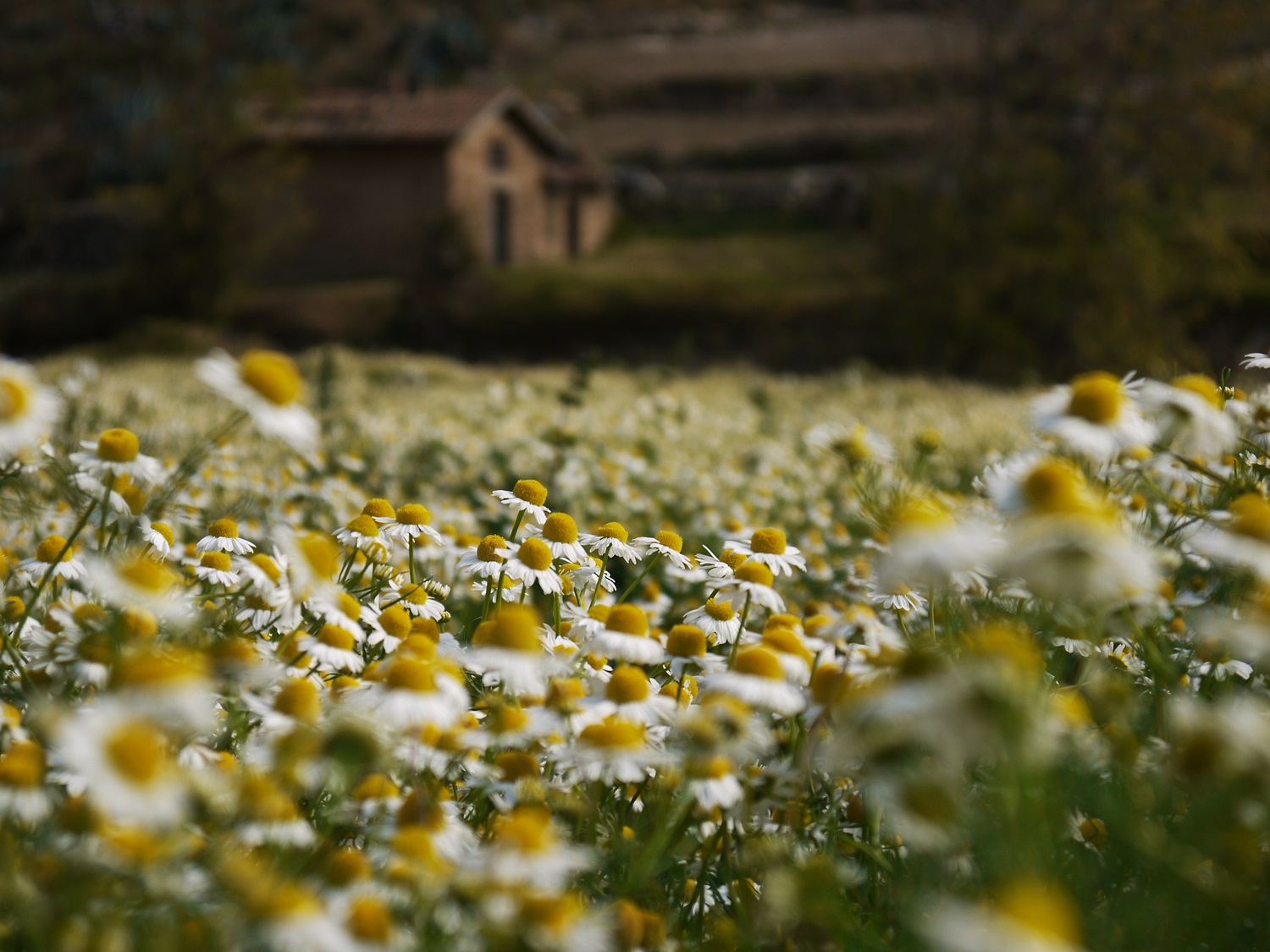
Tea. Of course, for us no country since Mexico would be complete without at least one attack from our parasite friends forcing us off the bike. On long bike trips, some people suffer with bikes that fall apart, while others struggle with injuries. It seems that our weak point is our stomachs, which stubbornly refuse to adapt to foreign invaders in the way our legs have to all-day climbs. Luckily Peru had an abundance of stomach-calming manazanilla (camomile) to sooth our stomachs and keep us pedalling.
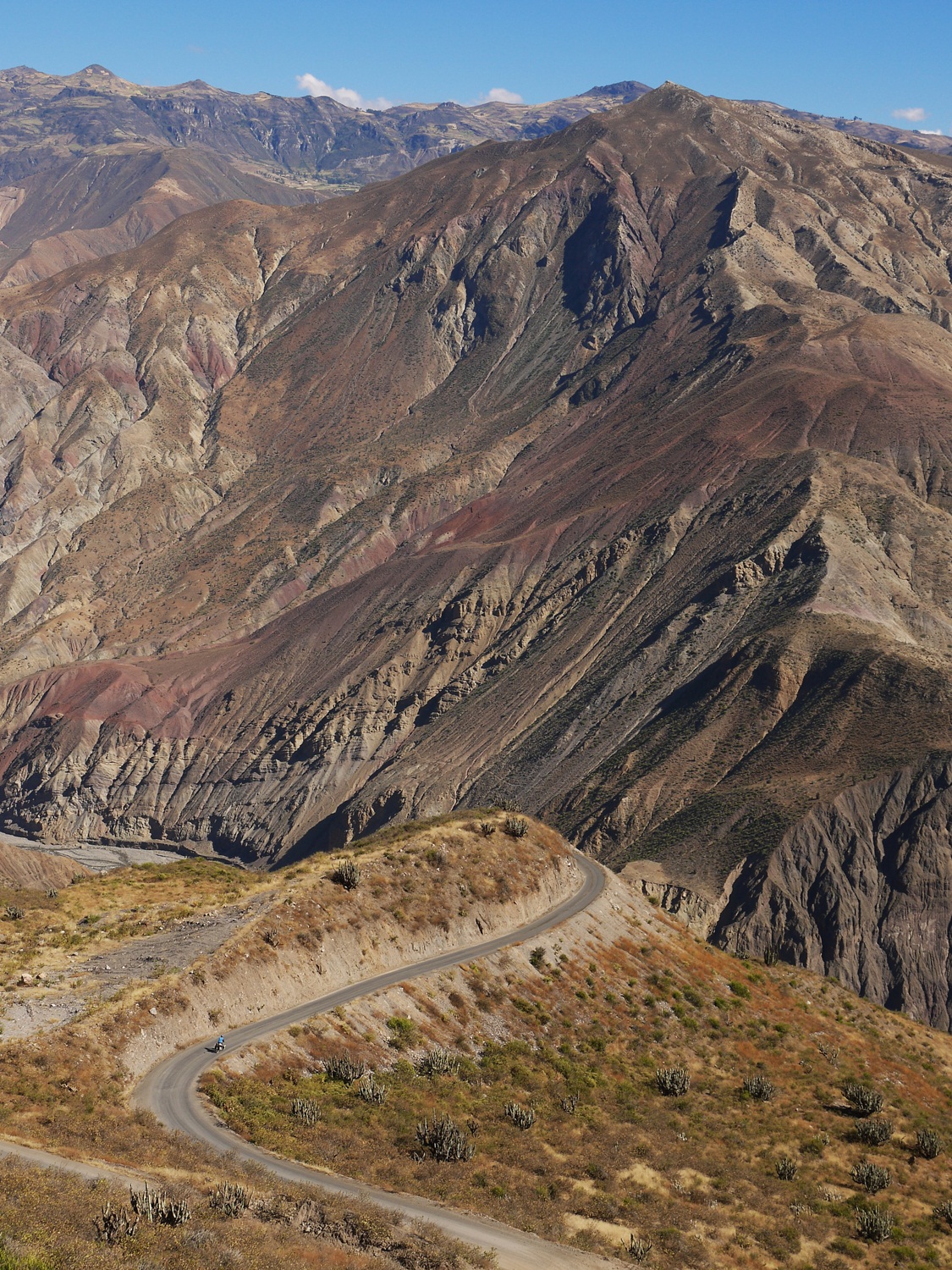
U-shaped. Peru: land of the switchback. Where Ecuador goes for direct and steep when faced with a mountain to climb, Peru goes for long and spaghetti-like – making for steady climbs and long descents with plenty of time to take in the views. This was one of our favourites, descending from Pallasca into the Río Santo gorge in northern Peru.
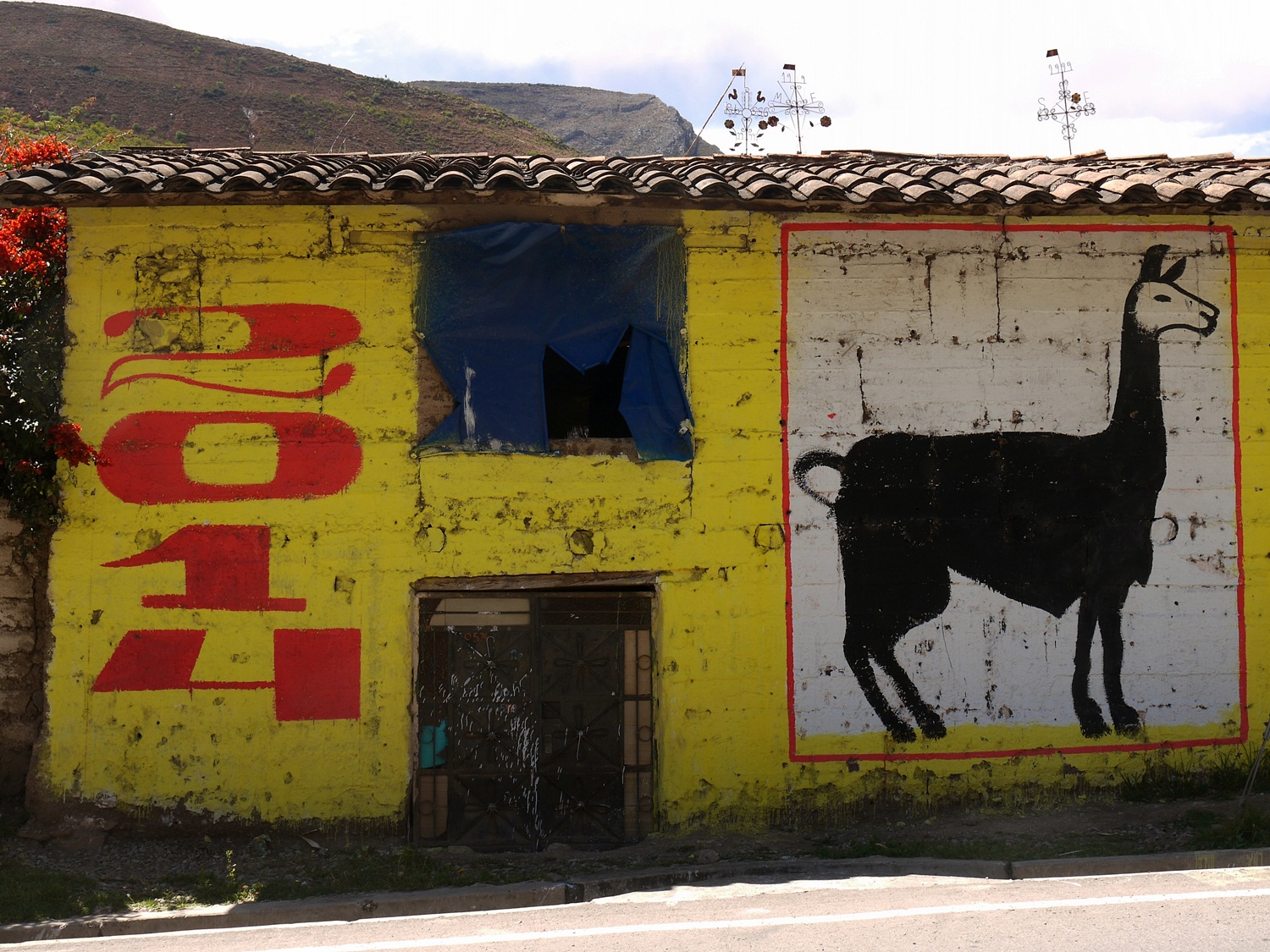
Vote for me. In Peru – like much of Latin America – you’ll struggle to find an abandoned building or wall which doesn’t feature a sign urging you to vote for Edwin, Alan or Alvaro. Except the uniquely Peruvian twist on political propaganda is that each candidate chooses an image to represent their campaign – ranging from a sombrero to a bulldozer to one of our favourites, this llama.
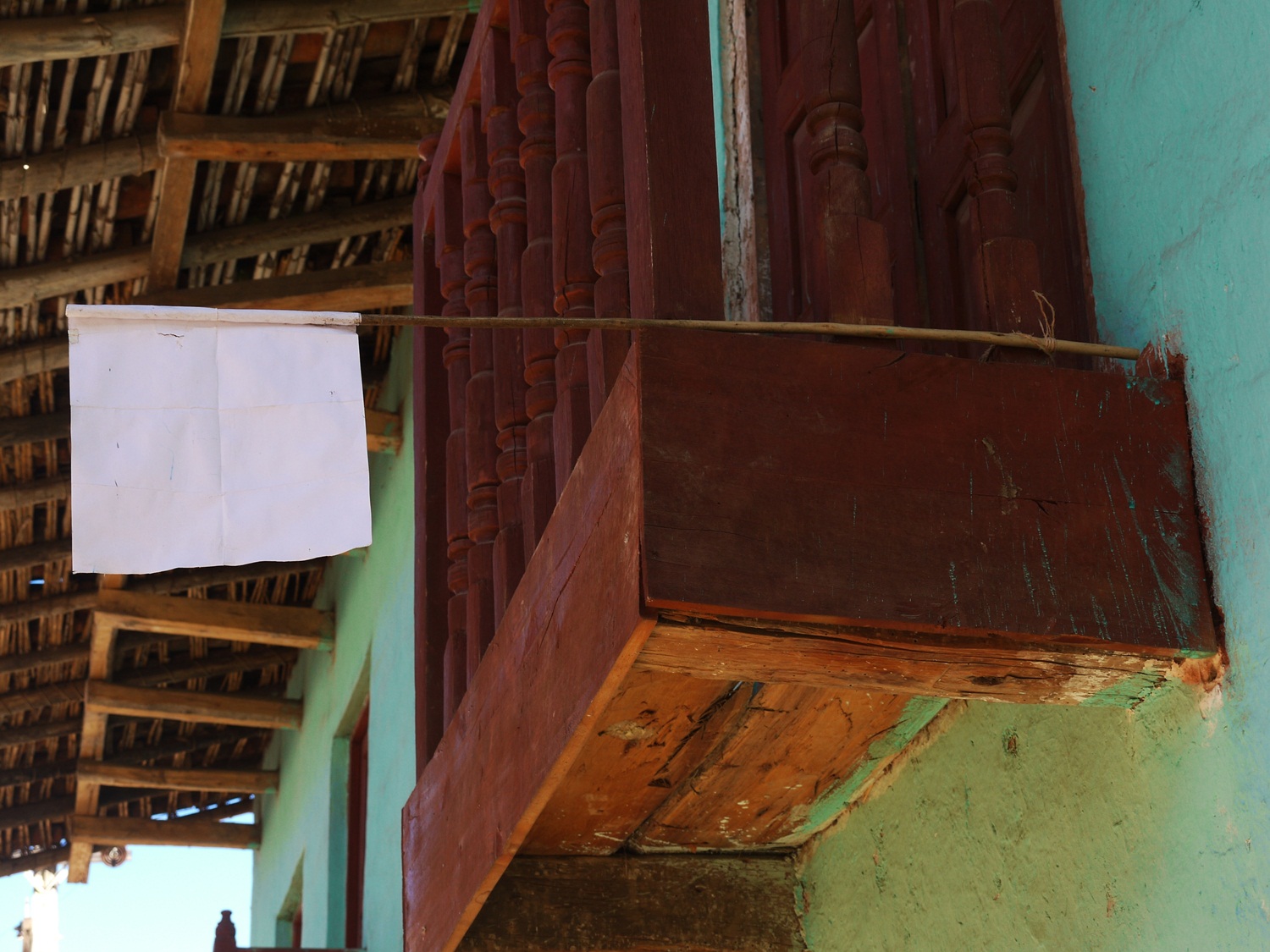
White flag. No, not the white flag of surrender when faced with another monster Peruvian climb, but one of salvation for the hungry cyclist. We quickly learned that a white flag hanging outside a house in rural Peru meant that they had freshly baked bread for sale – a lifeline when often the only thing the tiny local shops had on offer was out-of-date crackers and yesterday’s jelly.
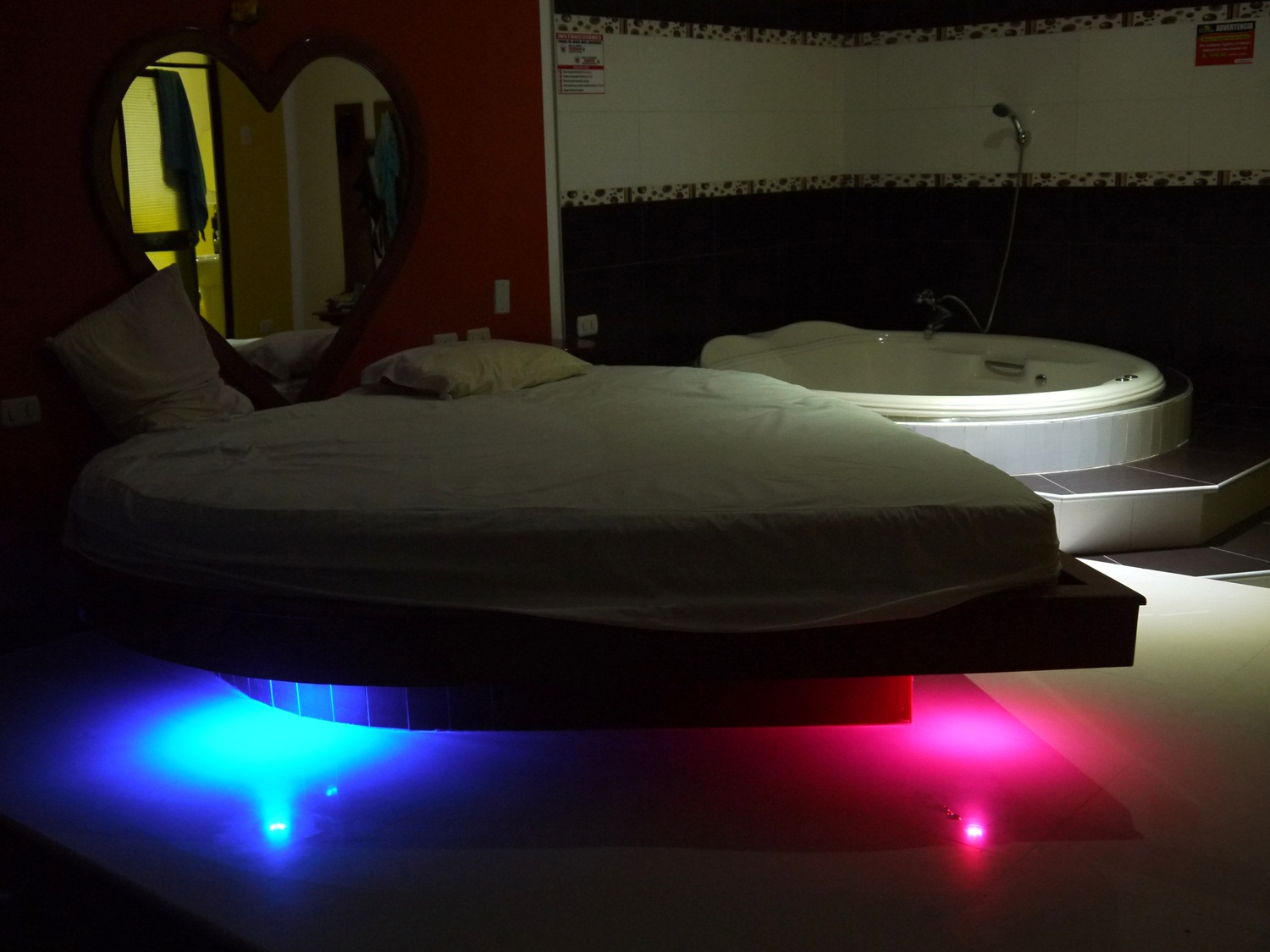
X-rated. Finally, we ticked the “night in a love motel” off our Latin American to do list – and we didn’t even have to pay for it. When we presented ourselves to the chief of police in Bagua Grande and asked if we could sleep on his floor, he insisted on sending us to the local love motel at his expense. Jacuzzi, TV, flashing lights – this room had it all, even if our feet did hang off the end of the heart-shaped bed…

“You wouldn’t want to live here” is a phrase that has run through my head many times on this trip, but maybe none more so than in Peru. This is a country of ghost towns – neglected, wind-swept and strewn with tumbleweed. Cycling through places like this, with the barefoot children of one or two remaining residents watching silently from the doorway, makes you realise that opportunity is one of life’s greatest riches. Most of these people will never have the opportunities we take for granted – to travel, to study and to work.
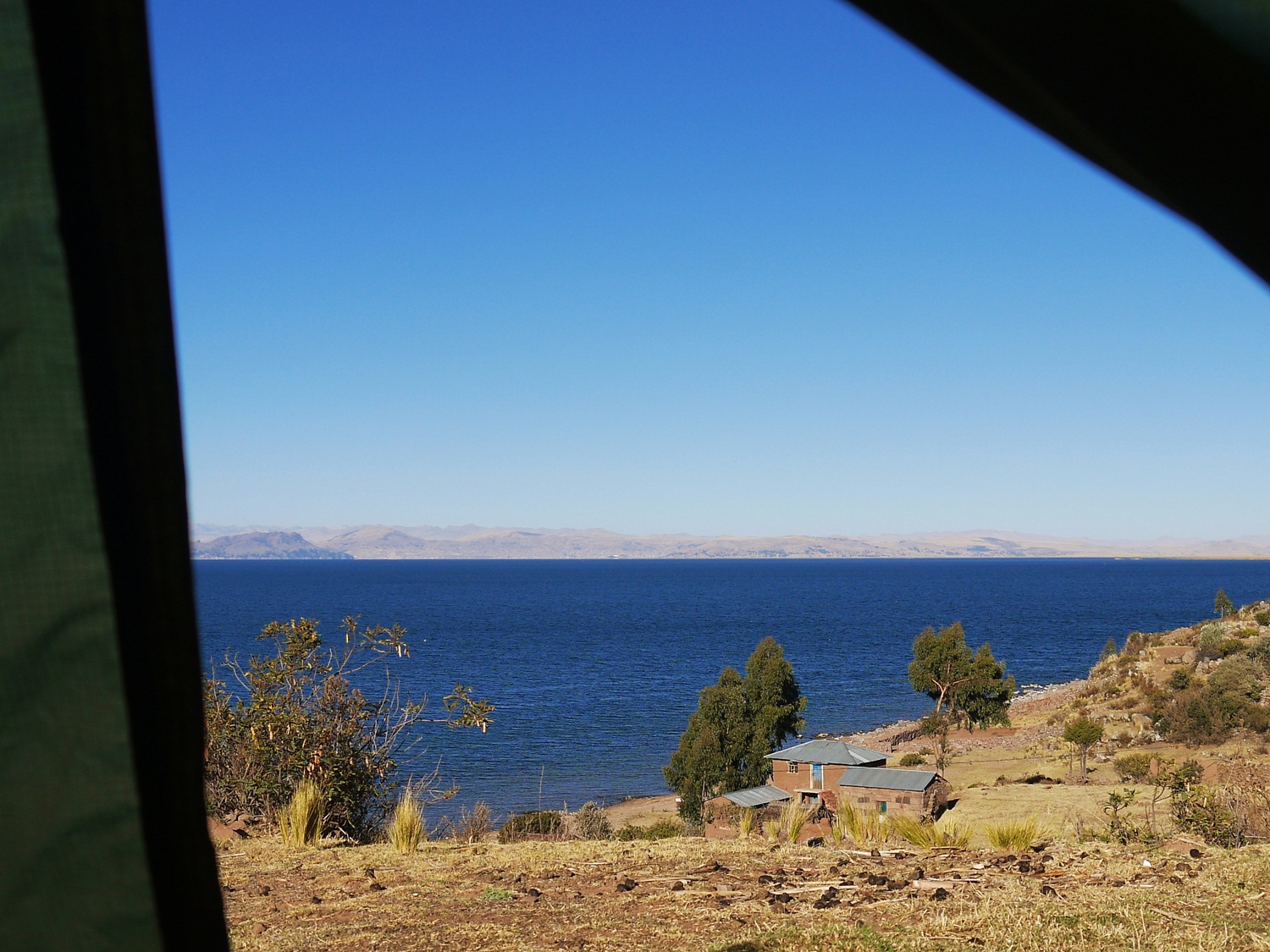
Zzzz. Peru had some of our most idyllic camping spots of the trip so far: the pampas of the Cordillera Blanca with peaks towering above; breakfast on the shore of Lake Junín while watching feeding flamingos; and early morning views across Lake Titicaca from the Llachón Peninsula. Five star accommodation doesn’t get any better than this.
A Chilean interlude
October 31st, 2013
Joined by our friend Anna – who we have repeatedly bumped into over the last year but had never quite managed to cycle with so far – we set off together from La Paz. The aim was to leave Bolivia briefly and enter Chile, hunting for volcanoes, salars and thermal baths through the Vicuñas and Isluga national parks .
Two weeks of riding in little-visited corners of Bolivia and Chile covered a wide spectrum of physical discomforts and absolute pleasures. Scraped, chafed, burned, steamed, scratched, sore, parched, blistered, windswept – and yet at the same time mud-bathed, elated, relaxed and awed; we enjoyed every minute of cycling in this remote and epic landscape.
Sarah

The ‘overflow’ Casa de Ciclistas in La Paz is at Mabel’s house; Mabel, stepmother to indefatigable casa host Cristian, also hosts cyclists in her very comfortable basement. We are received as family and really hope to see Mabel, Pablo and Yolita again.

Before leaving, we are lucky to spend time with some very hairy Alaskans. Max, Kanaan and Andy of “A Trip South” introduce us to Russian dumplings, excessive egg eating and the finer points of taming facial hair that is over a year old.

After the frantic road out of La Paz, we welcome the solitude that the desert brings on the second day.

Wild camping with Anna, we begin cooking together. Travelling with other cyclists obviously requires a certain amount of adapting to each others’ ways. We soon find though that on the most important topic (food) Anna’s appetite and hunger for good camp food matches ours and a beautiful new cooking team is born.
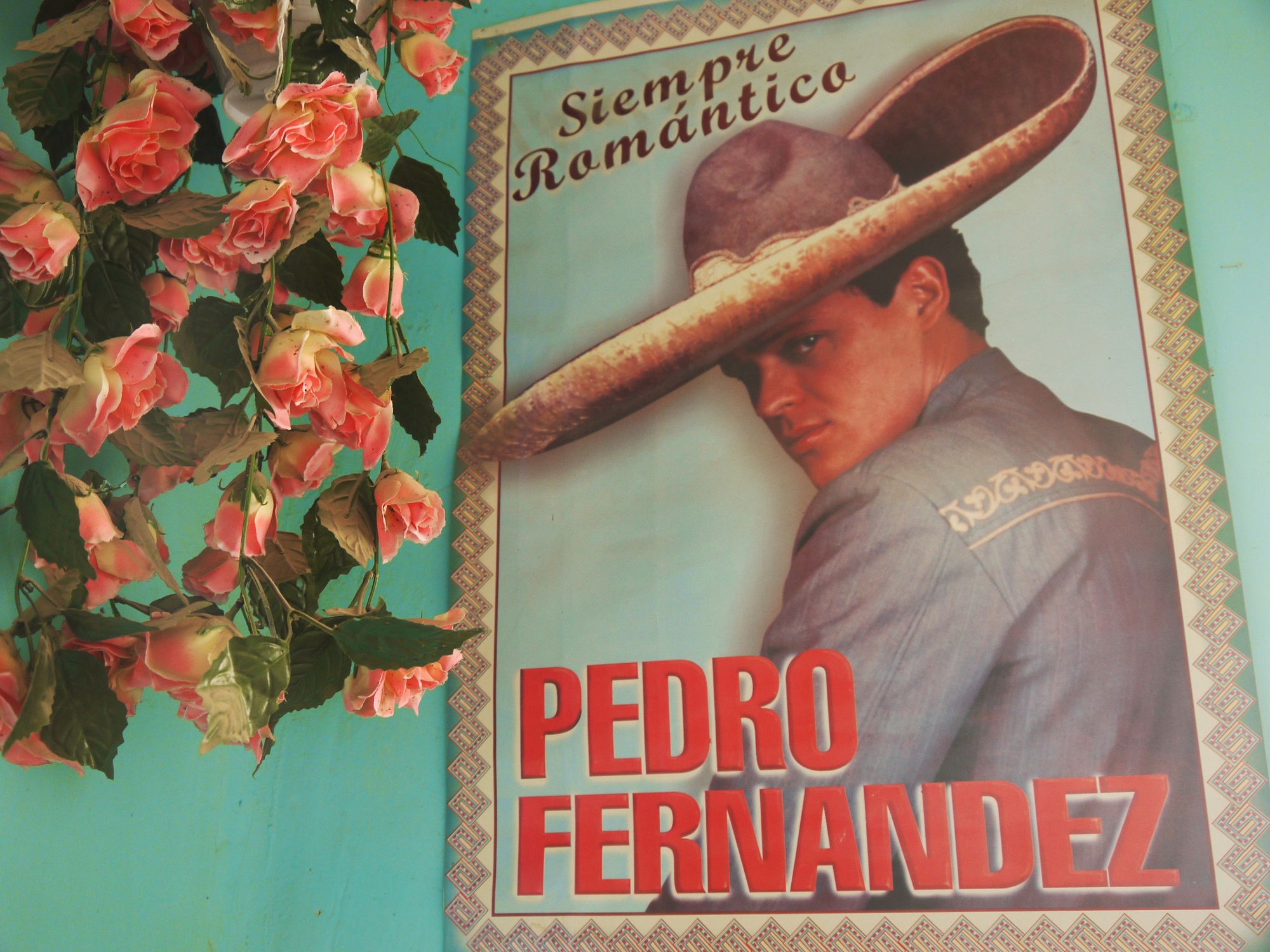
Just one of an eclectic mix of tasteful posters we get to peruse while having lunch in a shop in Curahuara.
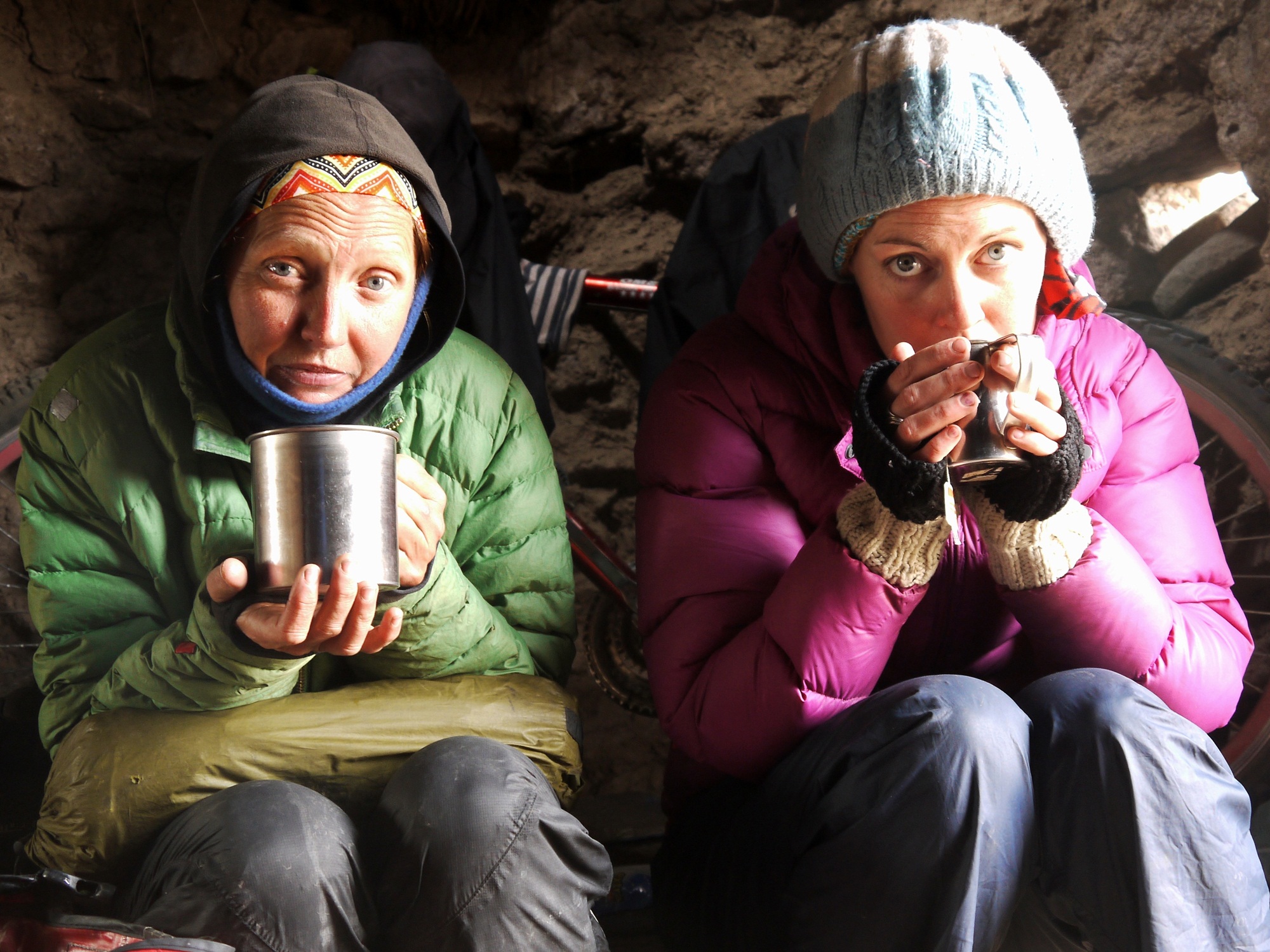
An icy downpour forces us off the road and into a disused shelter. The stove comes out and in a flash we are huddled over cups of tea until the weather clears…
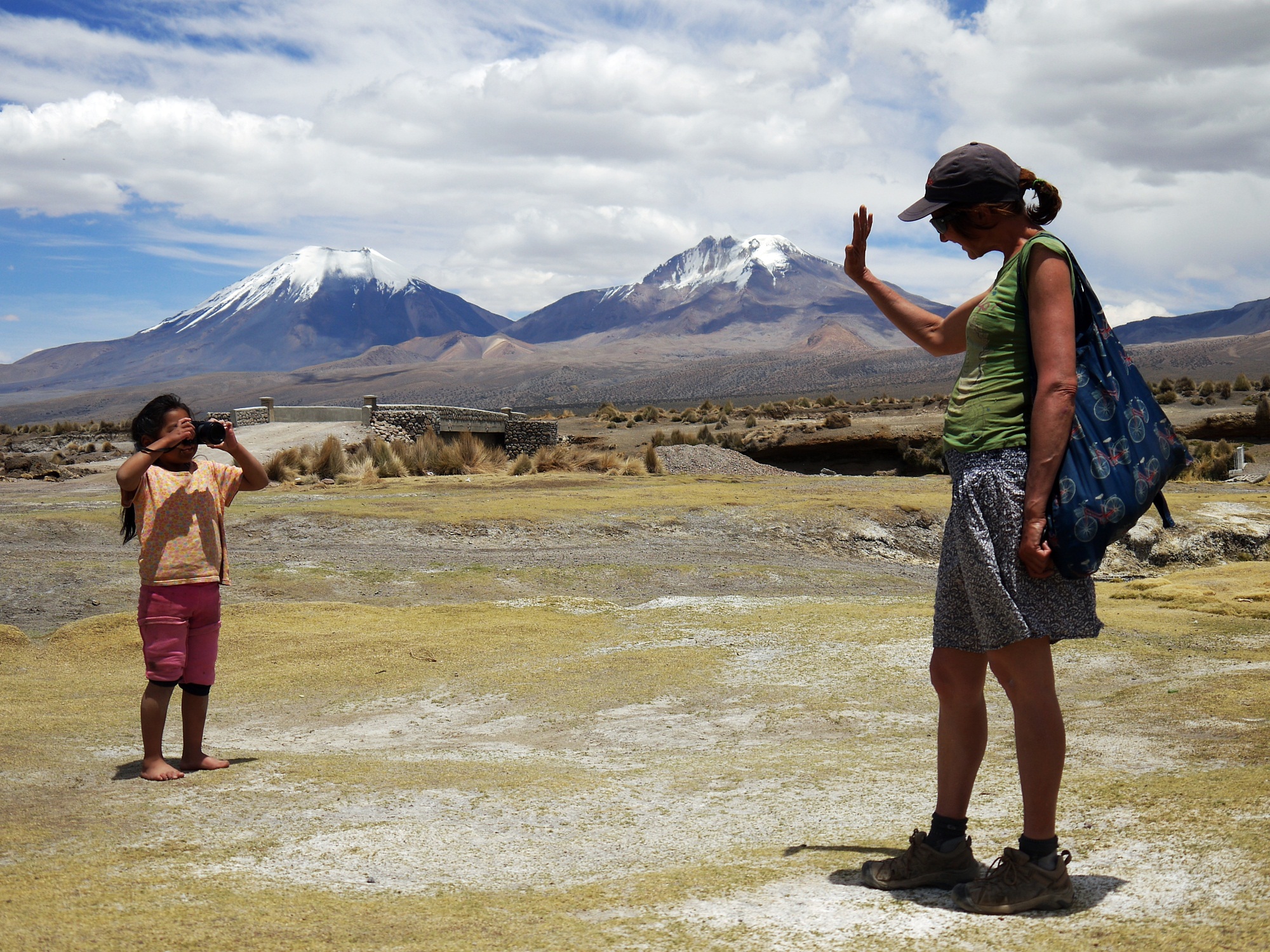
No photos please! Anna gets ‘papped’ with her own camera in the hands of Maria Luz, one of the residents of Sajama with a keen eye for photography.
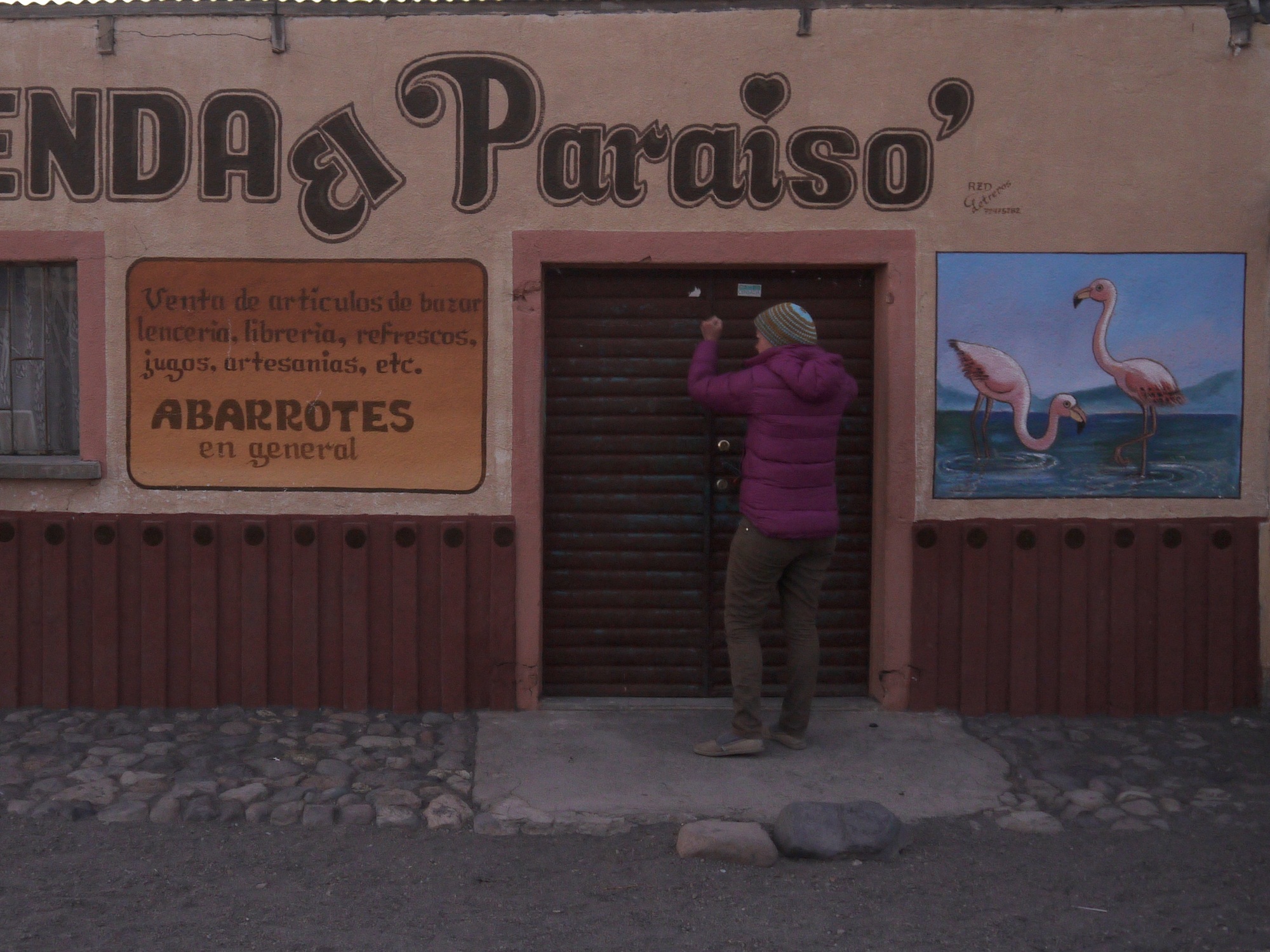
There’s not much going on in Sajama, and the handful of village shops are rarely open. We patiently knock, and wait, and hope…
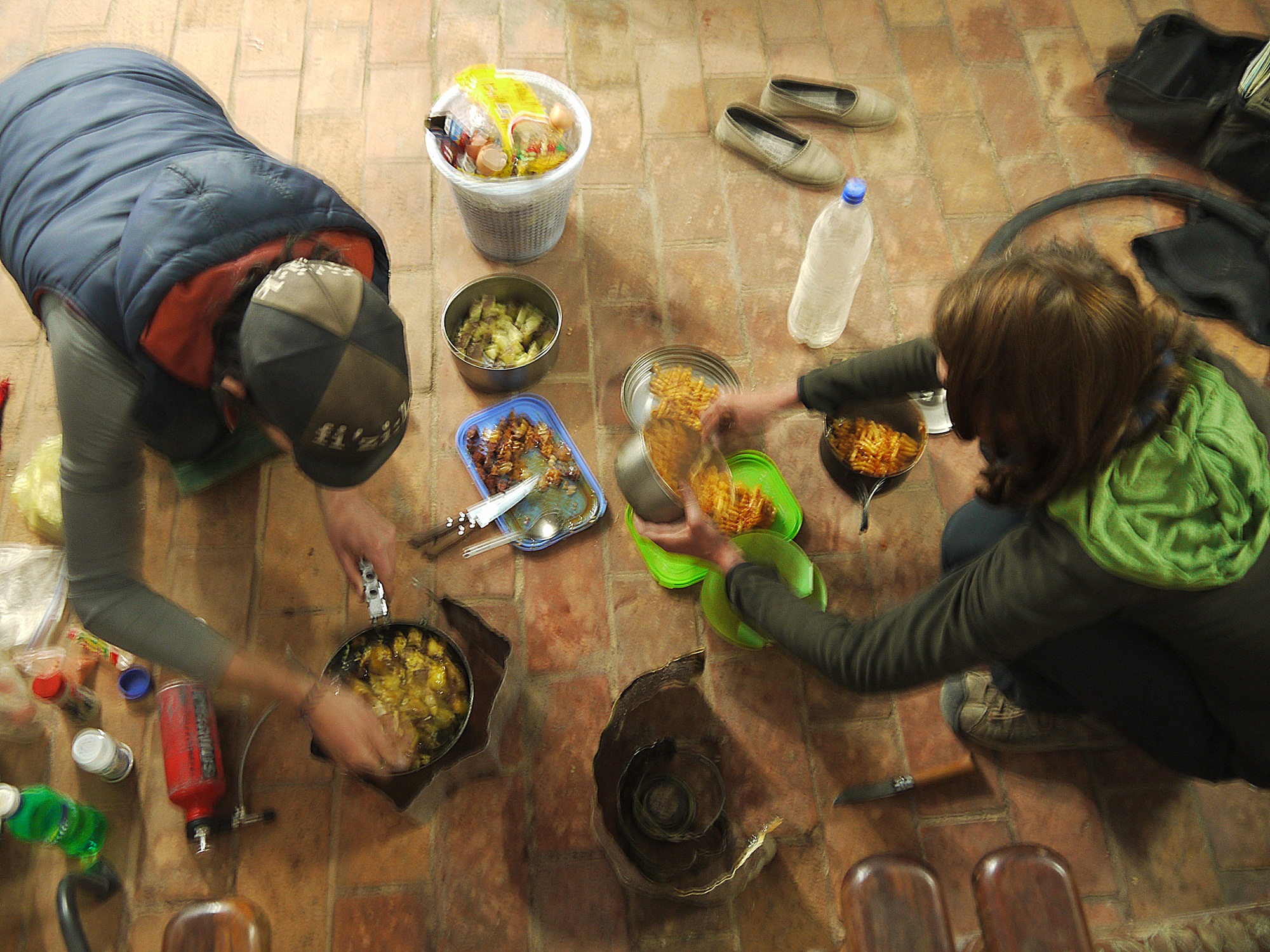
…supplies are short and we have to improvise but there’s still sufficient food to throw three cyclists into a cooking frenzy back in our hotel room…
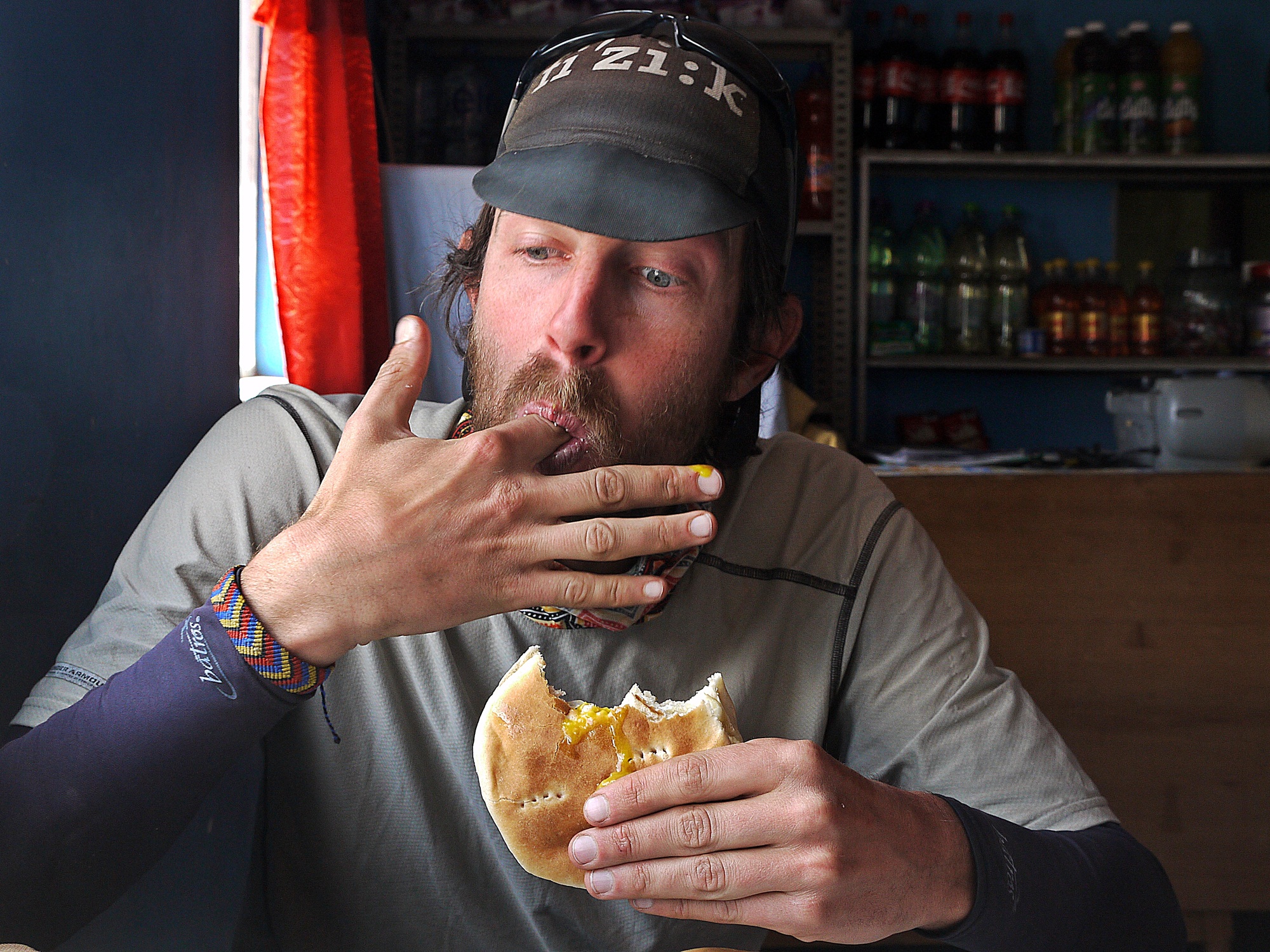
We are forbidden from carrying fruit, vegetables, dairy or meat into Chile and not expecting to encounter shops or restaurants on the Chilean side, we have prepared reluctantly for a five day stint of dried foods and basic meals. We strike gold however on the first morning – a roadside café offering delicious fried egg sandwiches…
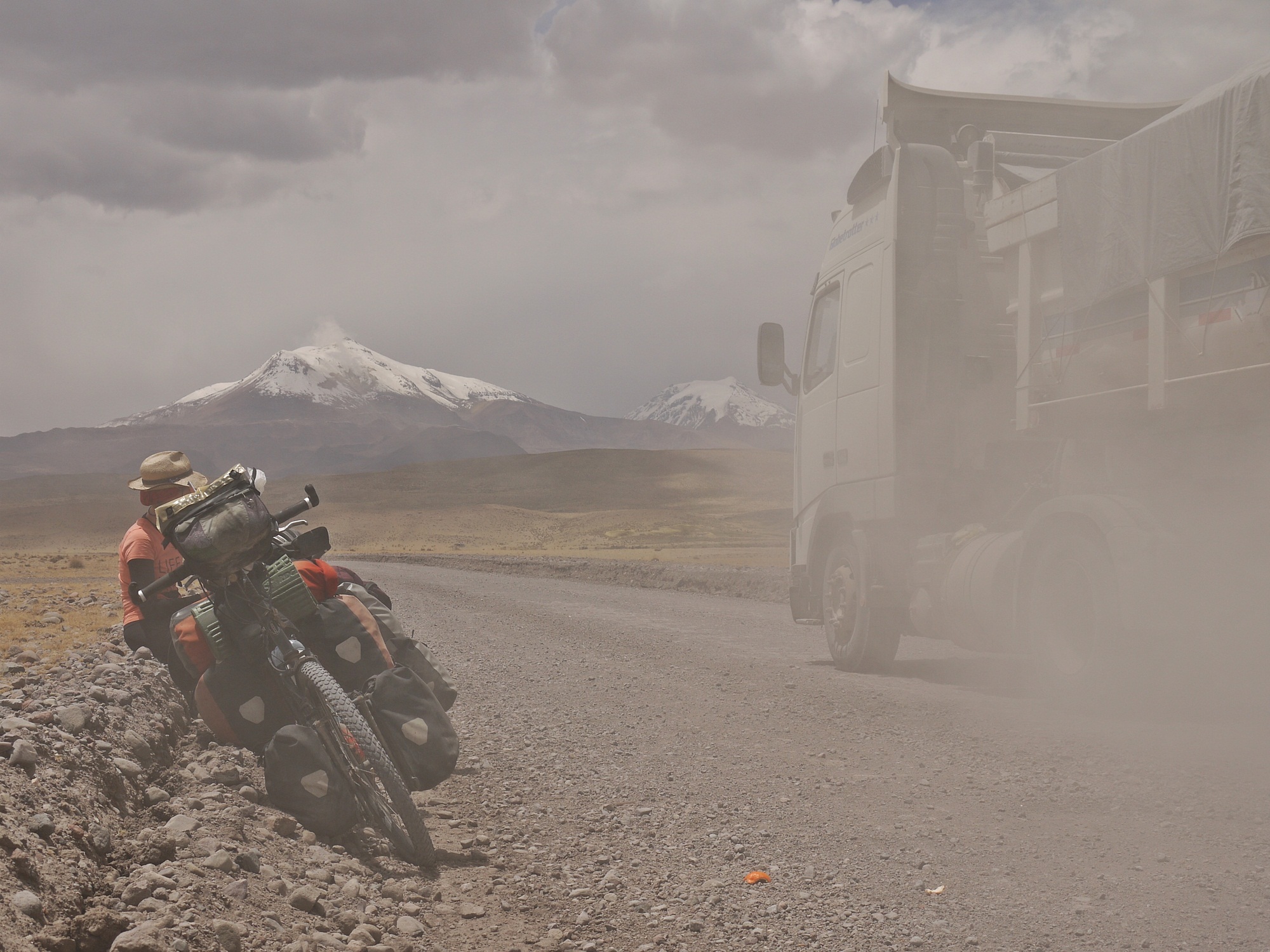
We share the road with a procession of trucks on their way to Arica on the Chilean coast. Despite being very courteous, the lorry drivers can’t avoid covering us in layer after layer of dust.

…and finding ourselves on a wide empty plateau in the early evening, we have to push 3km through sand and wind to find some shelter for camping.
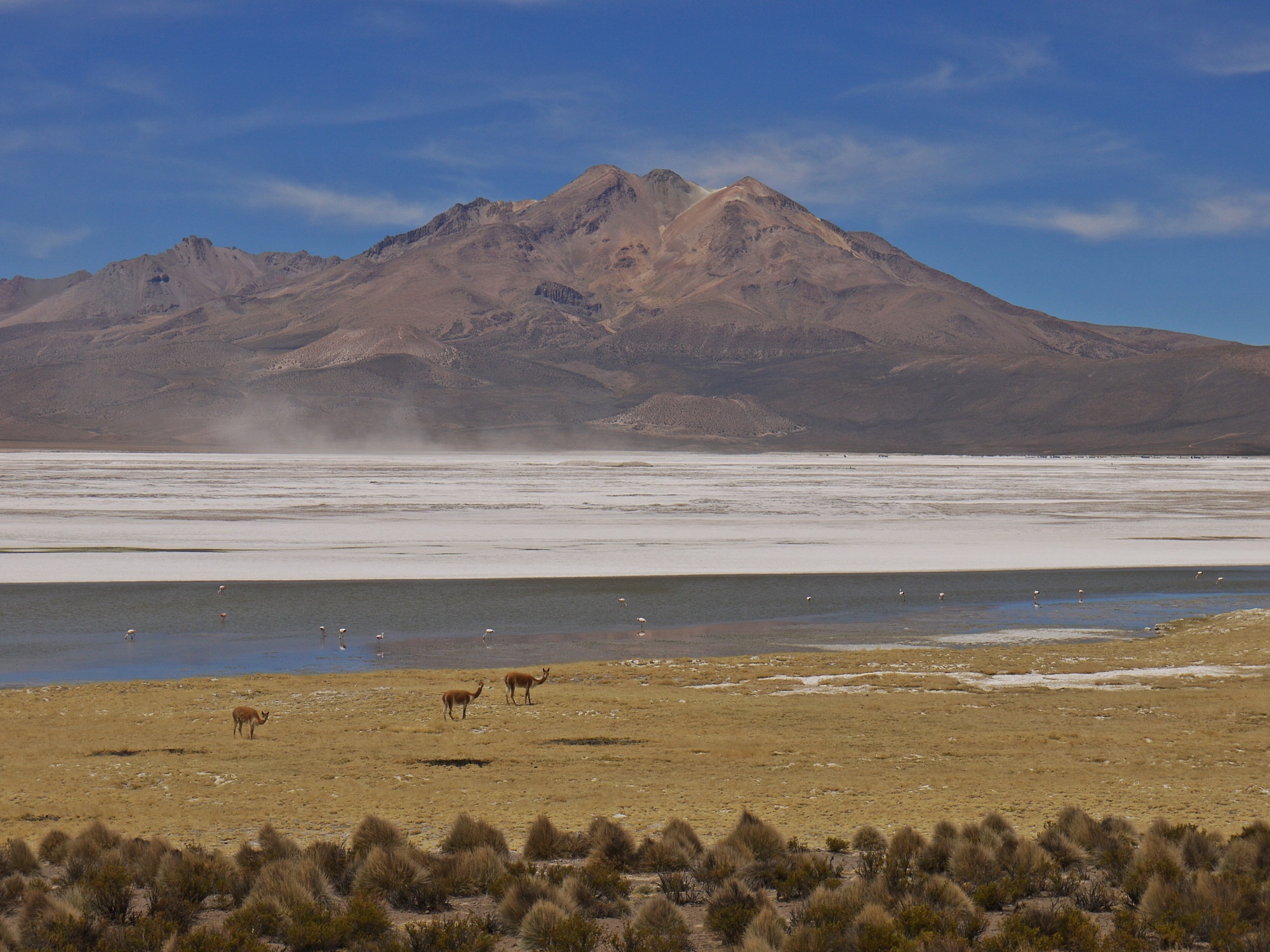
After a silent night of tranquil camping, we are just a short hop away from the edge of Chile’s Salar de Surire. A wide, bright, sparkling, deserted expanse of salt and a haven for vicuña and flamingos.
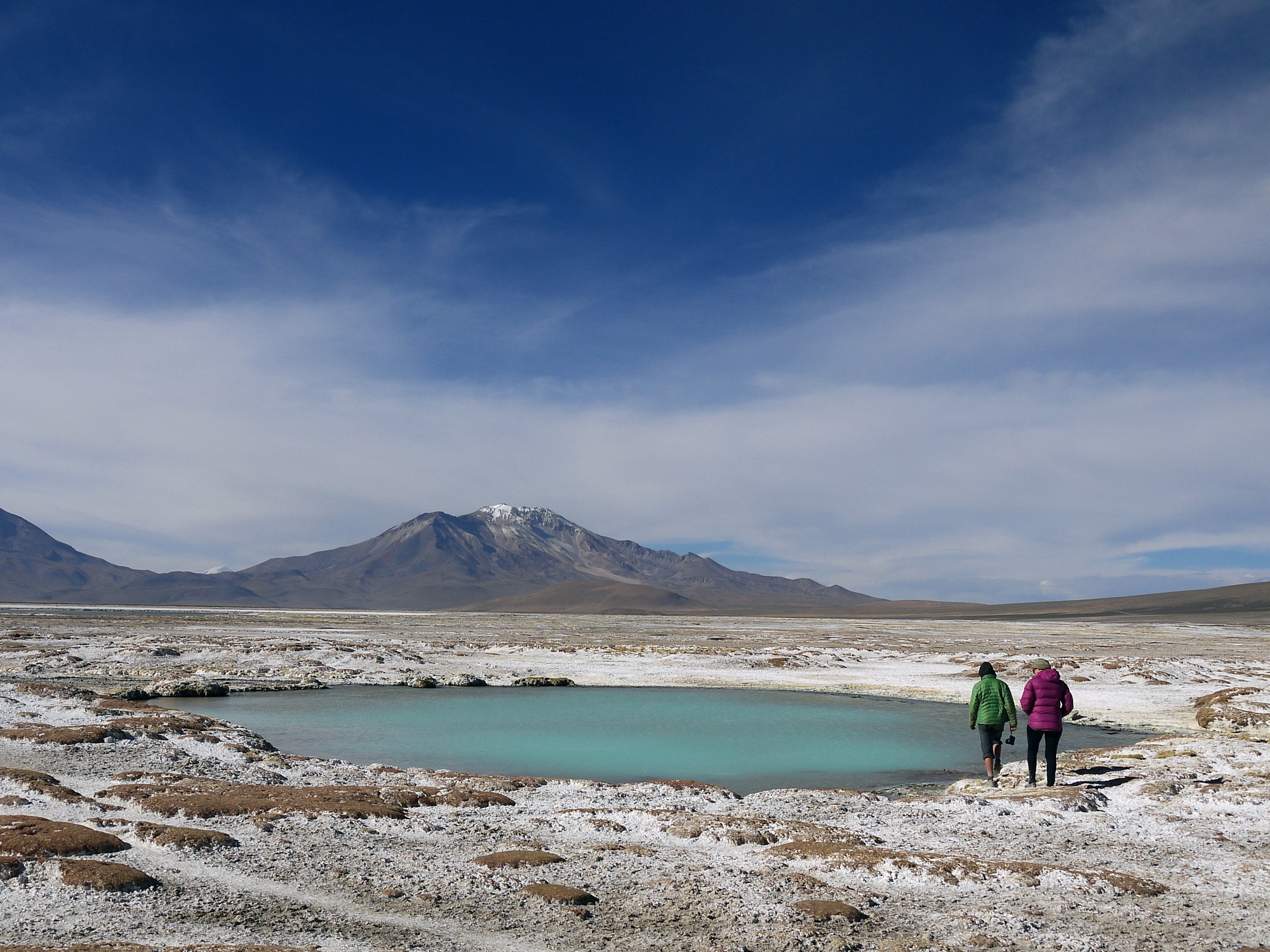
…contrast with the dazzling white salt and turquoise thermal pools. We arrive at the thermal waters at Polloquere…
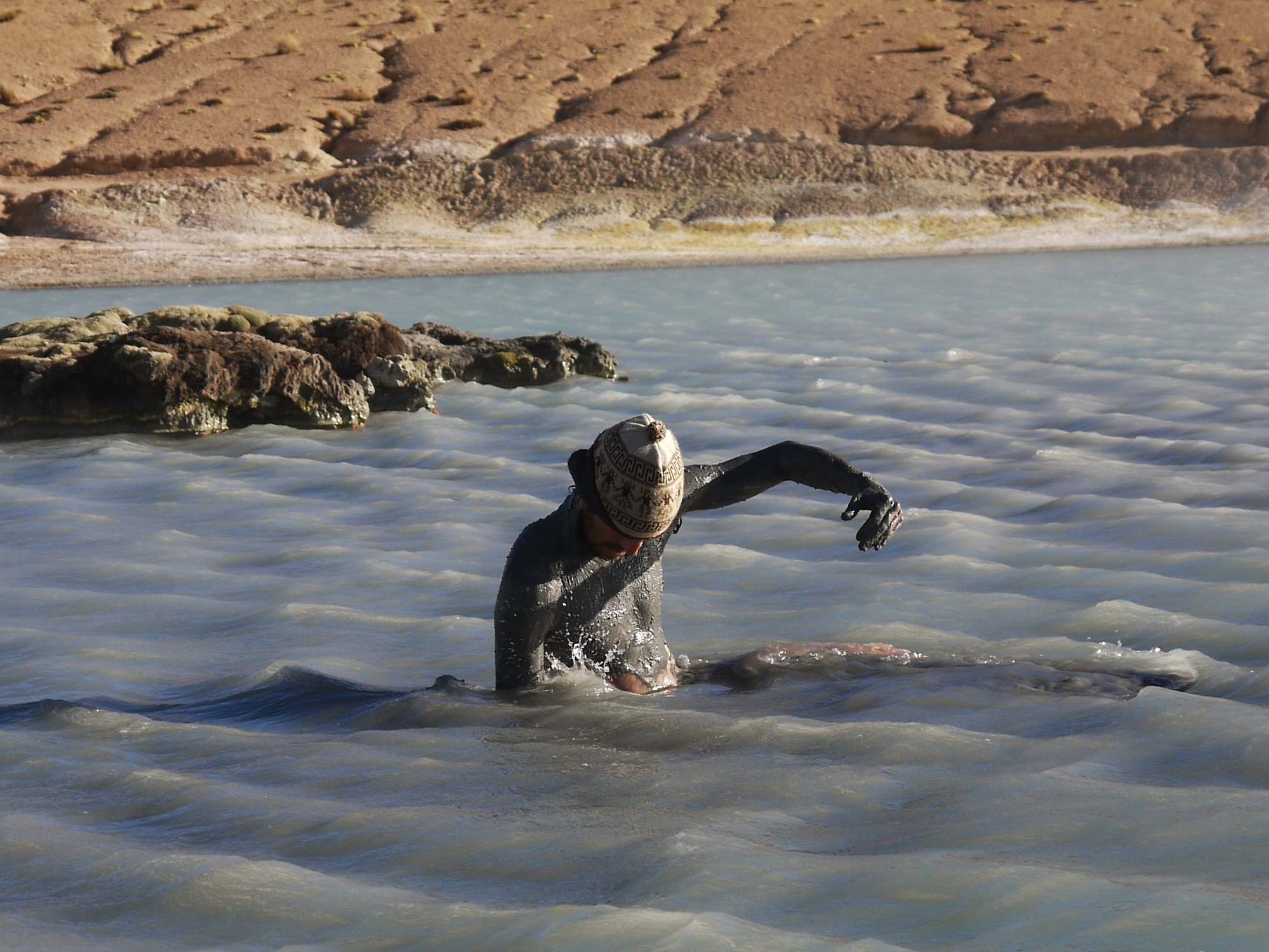
…and jump in. James quickly returns to his “creature from the deep” incarnation, last seen on Lake Tititaca…
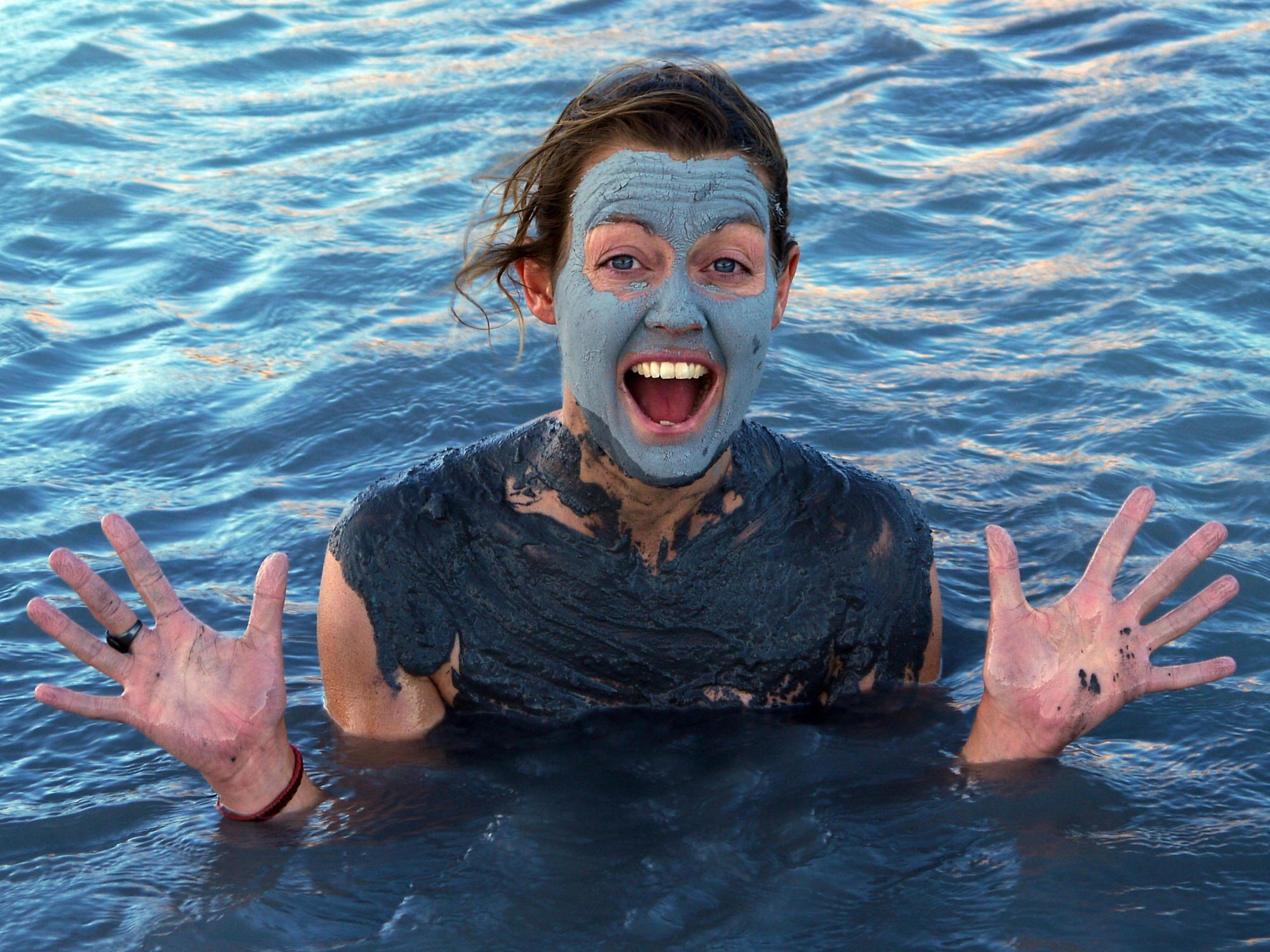
…and I scoop up the silky mud for a face pack. In the cold afternoon winds, the warm waters at around 45°C are bliss…
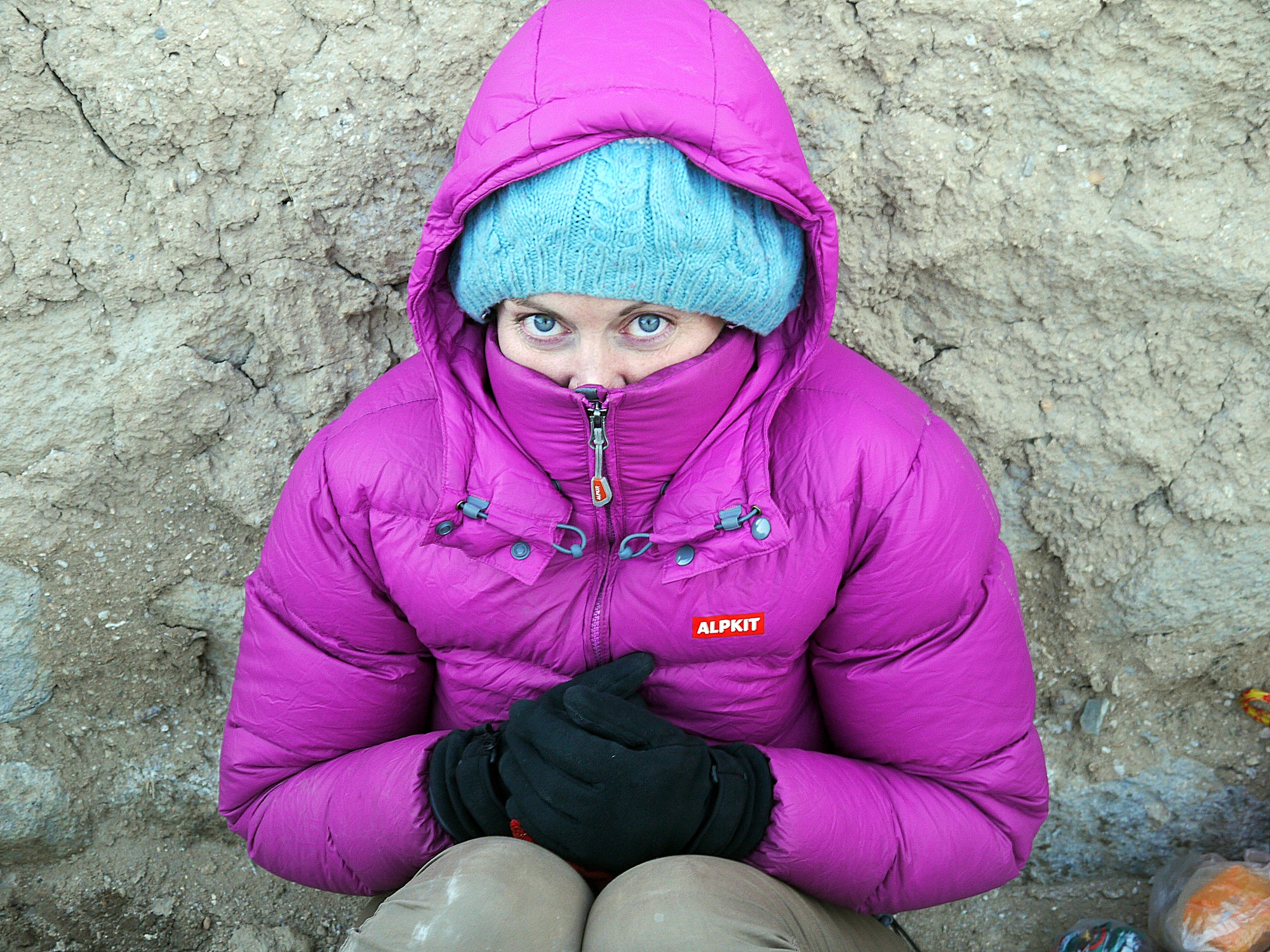
… but it’s a very different story out of the water. Getting straight into warm clothes is a race as the temperatures plummet. We layer up to keep warm…

Dragging ourselves away from a luxurious morning of mud wallowing, we begin our journey back towards the Bolivian border. With barely anything marked on our map and only having seen a handful of lorry drivers for days, we are surprised to find so many place names marked on this road sign…

Crossing back into Bolivia is quick and easy and soon we are back amongst the truckers as the sun sets over the border town of Pisiga.
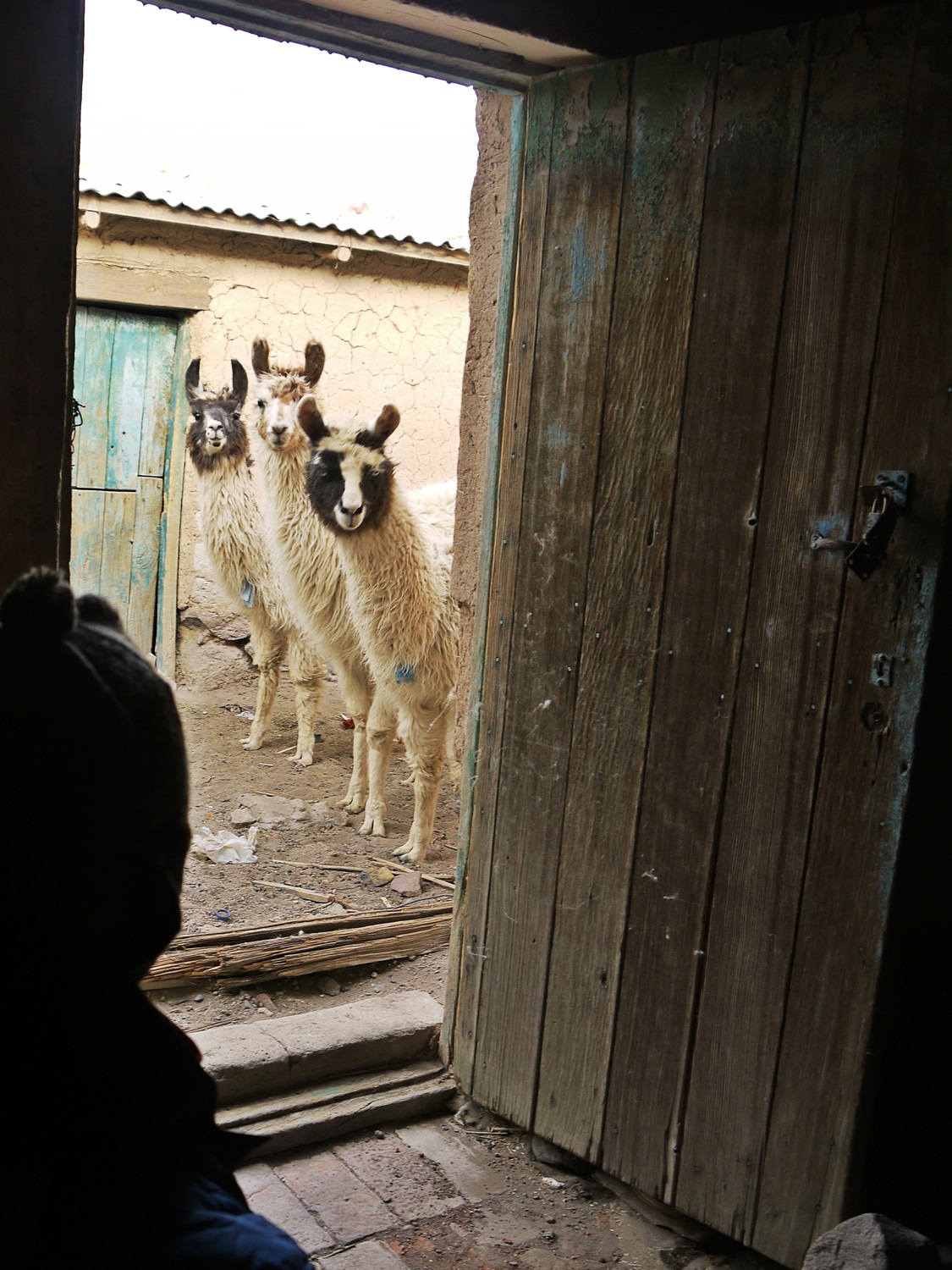
Keen to camp, we accept an invitation from friendly Miguel (who owns the local grocery shop in town) to camp with his baby llamas. They insist on overseeing every aspect of our routine, and welcome us appropriately back to Bolivia.
Anna also blogged about this section of our trip and you can read it here.
Route notes:
Bolivia:
Route: La Paz – Patacamaya – Sajama – Tambo Quemado
– Reached Sajama via unpaved back road which loops to north of Volcán Sajama via Ojsani and Tomarapi – recommended. Turn off level with telecom towers on hill, towards rock forest.
– Last shopping opportunity in Tambo Quemado on Bolivian side – we didn’t see a shop again until we crossed back into Bolivia at Pisiga, 5 days later.
– No fresh fruit, veg, meat or dairy products into Chile – they scan your bags to check. Peanut butter OK, honey and jam not!
Chile:
Route: Guallatire – Chilcaya – Enquelga – Isluga – Colchane
– From customs and immigration, back track a few hundred metres and take the turn on the bend signed to Guallatire – an unpaved, sandy road which climbs to a pass. 10km from customs to Chirigualla hot springs – we slept cosily inside the hut.
– Polloquere hot springs – approx 32km from Chilcaya. Follow dirt road around the east side of the Salar de Surire. At junction in corner of salar, keep right (left turn, uphill, goes back to Bolivia) – springs are on right after a couple of km.
– After springs, continue on this road to a well-signed junction – turn left towards Colchane.
– Food: roadside comedor 10km before Guallatire – also sells biscuits. Other than that, we saw no shops in Chile.
– Water: never carried more than a day’s supply – available from Customs post at border, carabinieri (police) at Guallatire and Chilcaya, and some freshwater springs on the pampa after the Cerro Capitán pass.
See our map for a route overview.
